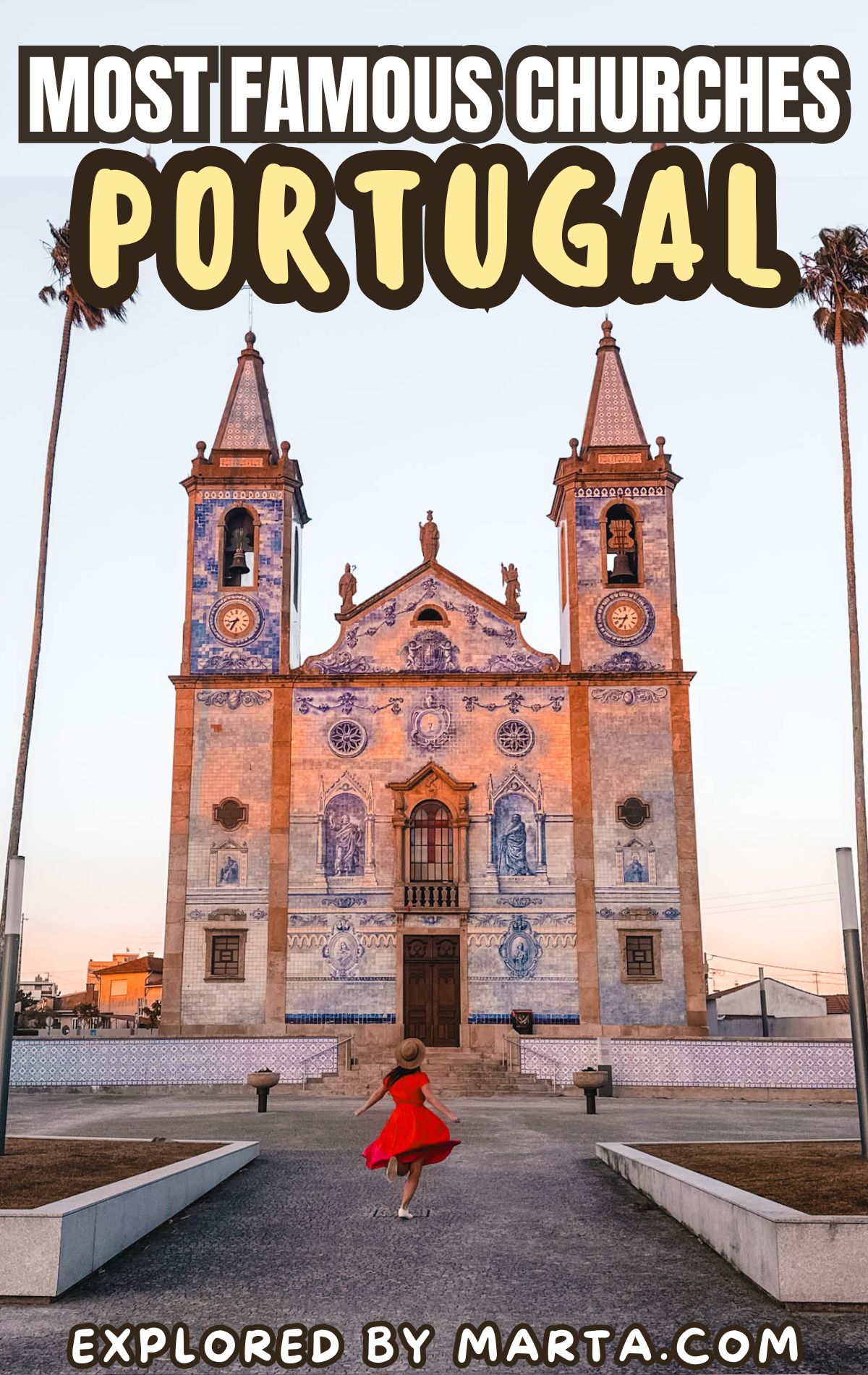22 most famous churches in Portugal
This post may contain affiliate links. If you use these links to buy something I may earn a small commission at no extra cost to you! Thank you for your support!
Come with me to explore the most famous churches in Portugal! From grand cathedrals and hilltop sanctuaries to majestic monasteries and charming chapels, Portugal is home to some of the most beautiful and unique churches in Europe.
During our travels across the country, we’ve visited countless churches – each one with its own story and charm. Whether you’re into religion, architecture, history, or just love discovering new places, these churches are worth adding to your Portugal itinerary.
In this blog post, you’ll find the most famous churches in Portugal with descriptions, photos, and locations on Google Maps, so you can easily plan your visits and see which ones catch your eye. Happy travels!
1. Bom Jesus do Monte
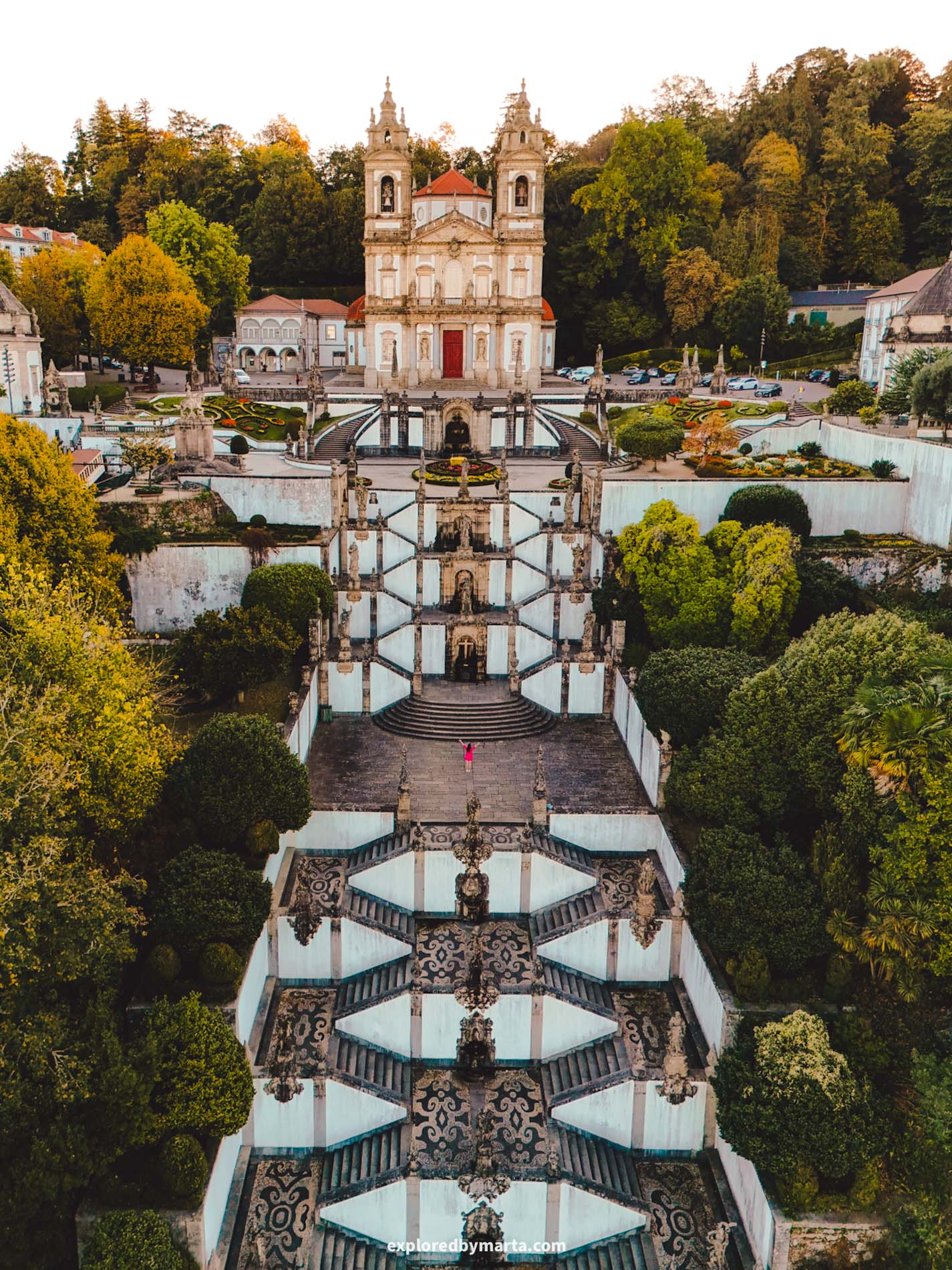
Bom Jesus do Monte is one of the most famous attractions not only in Braga but in all of Portugal. Without a doubt, it is one of the most famous churches you can find in Portugal.
This stunning sanctuary sits on a hill just outside the city and is known for its monumental Baroque stairway that zigzags all the way up to the church at the top of the hill.
Climbing the Baroque stairs is one of the must-do things to do in Braga (if you are able to do that)!
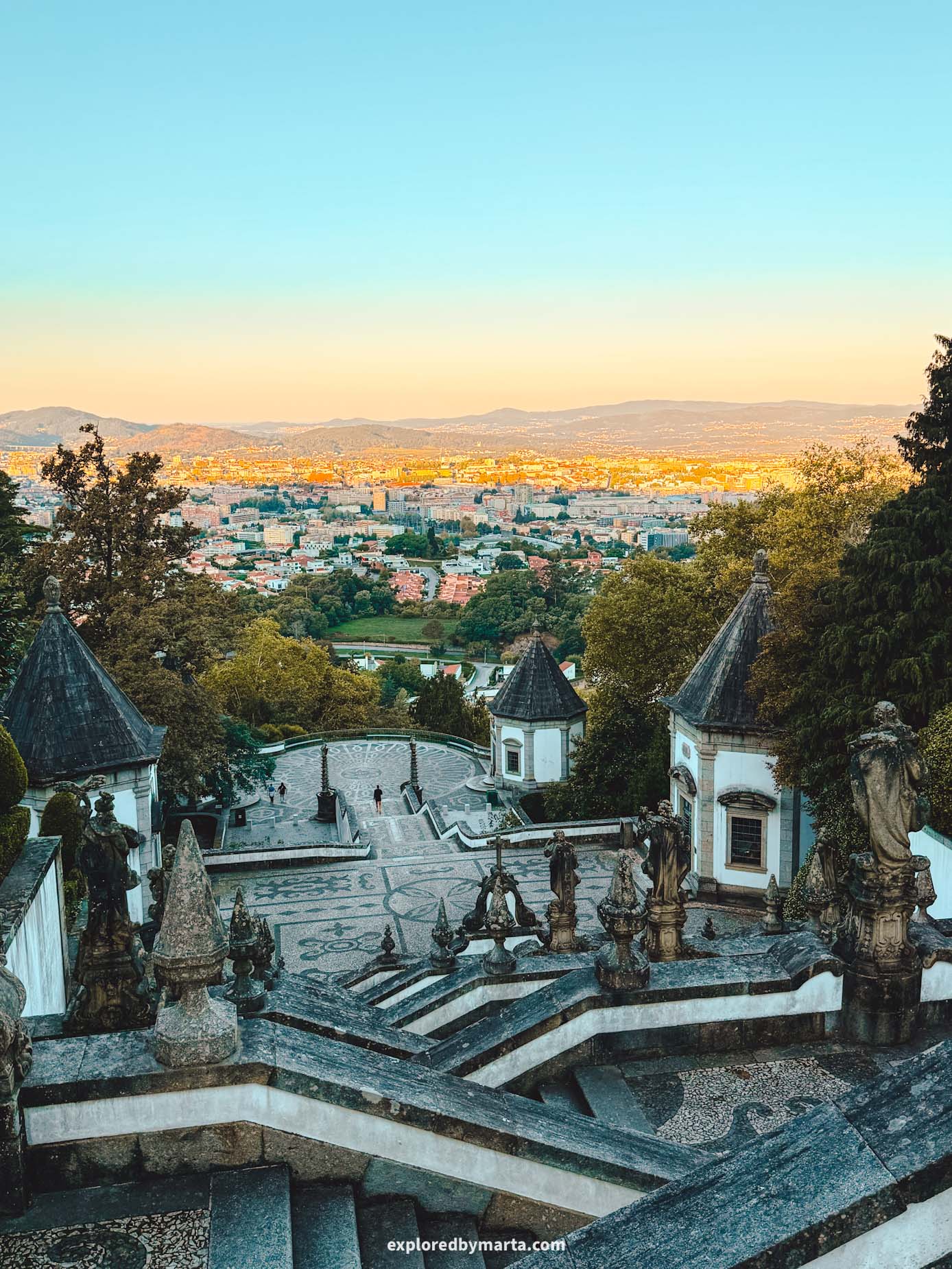

I have visited this place three or four times already, and it always takes my breath away – the architecture, the grandeur, and those panoramic views from the top! It is definitely something special.
The religious site dates back to the 14th century, though the current sanctuary and staircase were built in the 18th-19th centuries.
Each level of the staircase features fountains and statues. It’s a true masterpiece and has been a UNESCO World Heritage Site since 2019.
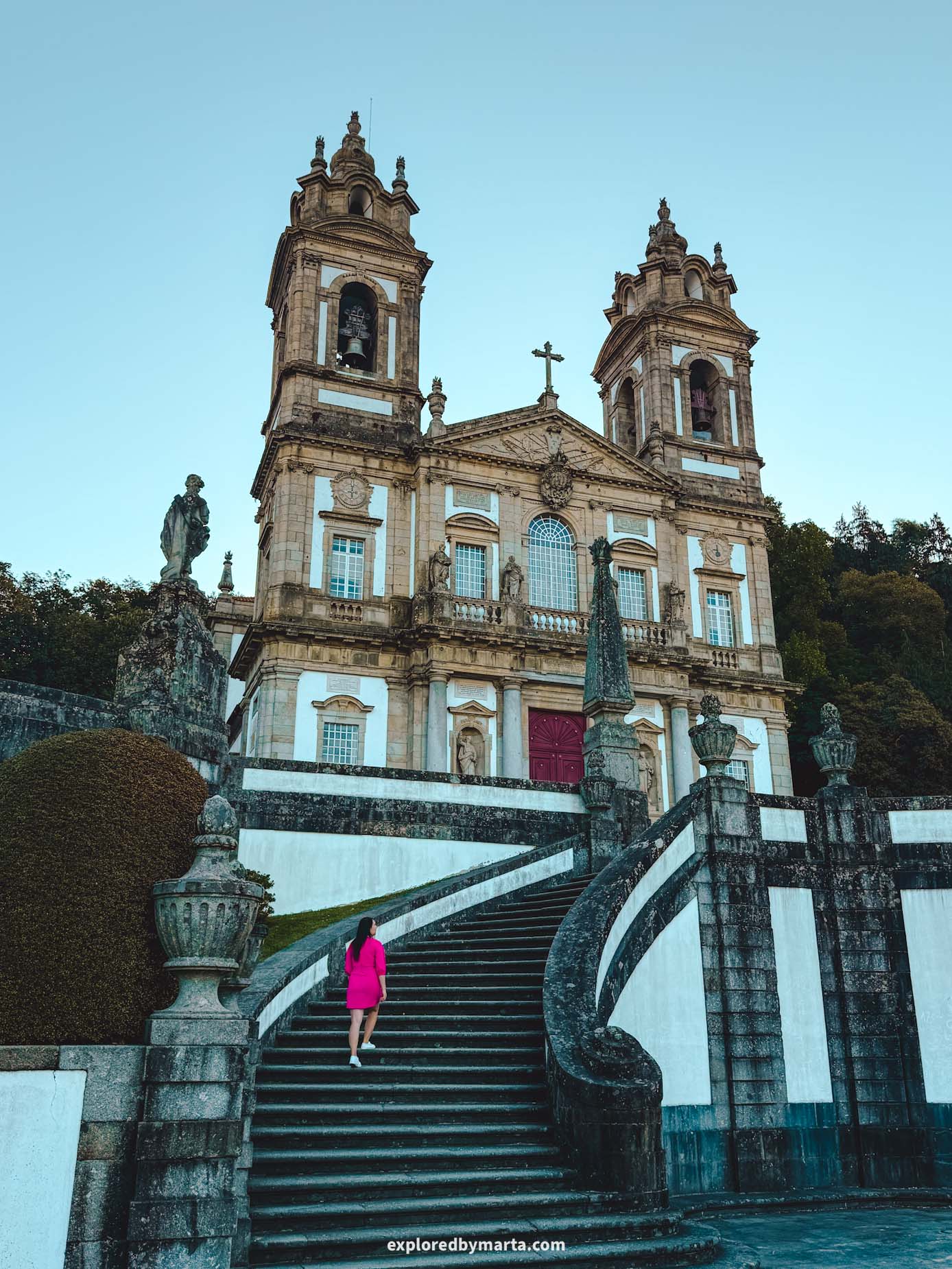

You can reach the top by climbing the 577 steps or by taking the historic funicular. One of the times we came here, we arrived on Sunday morning, and it looked like locals used the stairs as a gym! So many people were walking up and down there, haha!
The church itself is beautiful, but simple. However, the real adventure of Bom Jesus do Monte is the climb up and the views that await you at the summit.
If you come here during the day, I recommend exploring the hilltop, too. There is a beautiful garden with a fountain, as well as many cafes, where you can relax and soak in the special atmosphere this unique place provides. It is one of those places you simply cannot miss!
Location: Bom Jesus do Monte
2. Batalha Monastery
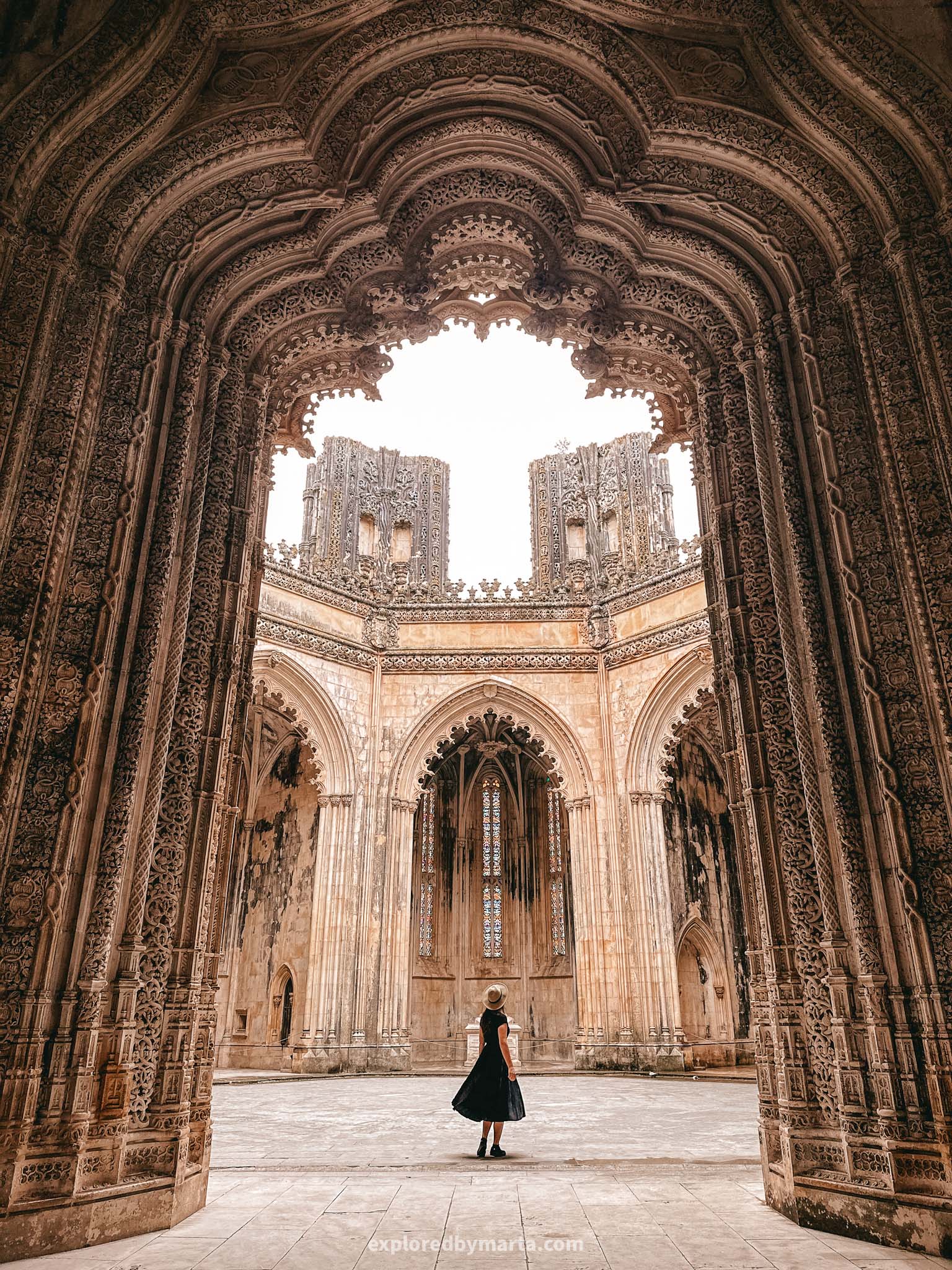
Batalha is a small town in central Portugal, hidden between Leiria, Alcobaça, and Nazaré. Despite its small size, it hides a magnificent secret within its medieval walls – the majestic Batalha Monastery.
It is one of the most beautiful places I have ever seen!
Officially called the Monastery of Santa Maria da Vitória, this is more than just another place on a long list of must-visit places in Portugal.
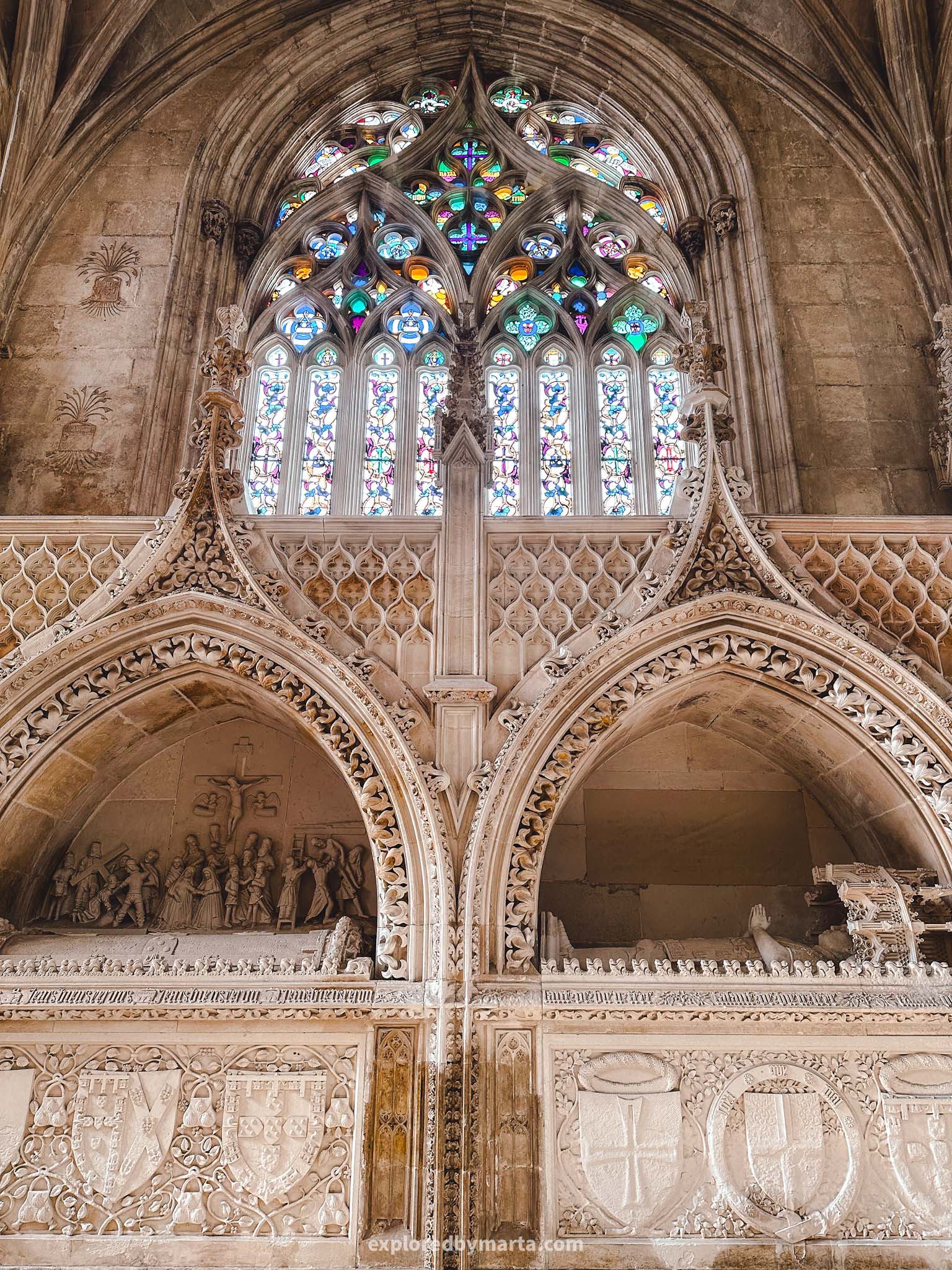

Batalha is one of those towns that was literally born out of history. It was built on the battlefield (that’s where its name comes from – Batalha!), where the decisive Battle of Aljubarrota took place back in 1385.
It is where Portugal, despite being outnumbered, secured its independence from Castile (today’s Spain), and it is considered one of the most important battles in Portugal’s history.
After the victory, Portugal’s King João I ordered the building of a majestic monastery on the very battlefield in honor of the Virgin Mary. The construction of the monastery took over a century and was done under the reign of seven kings and the supervision of fifteen architects.
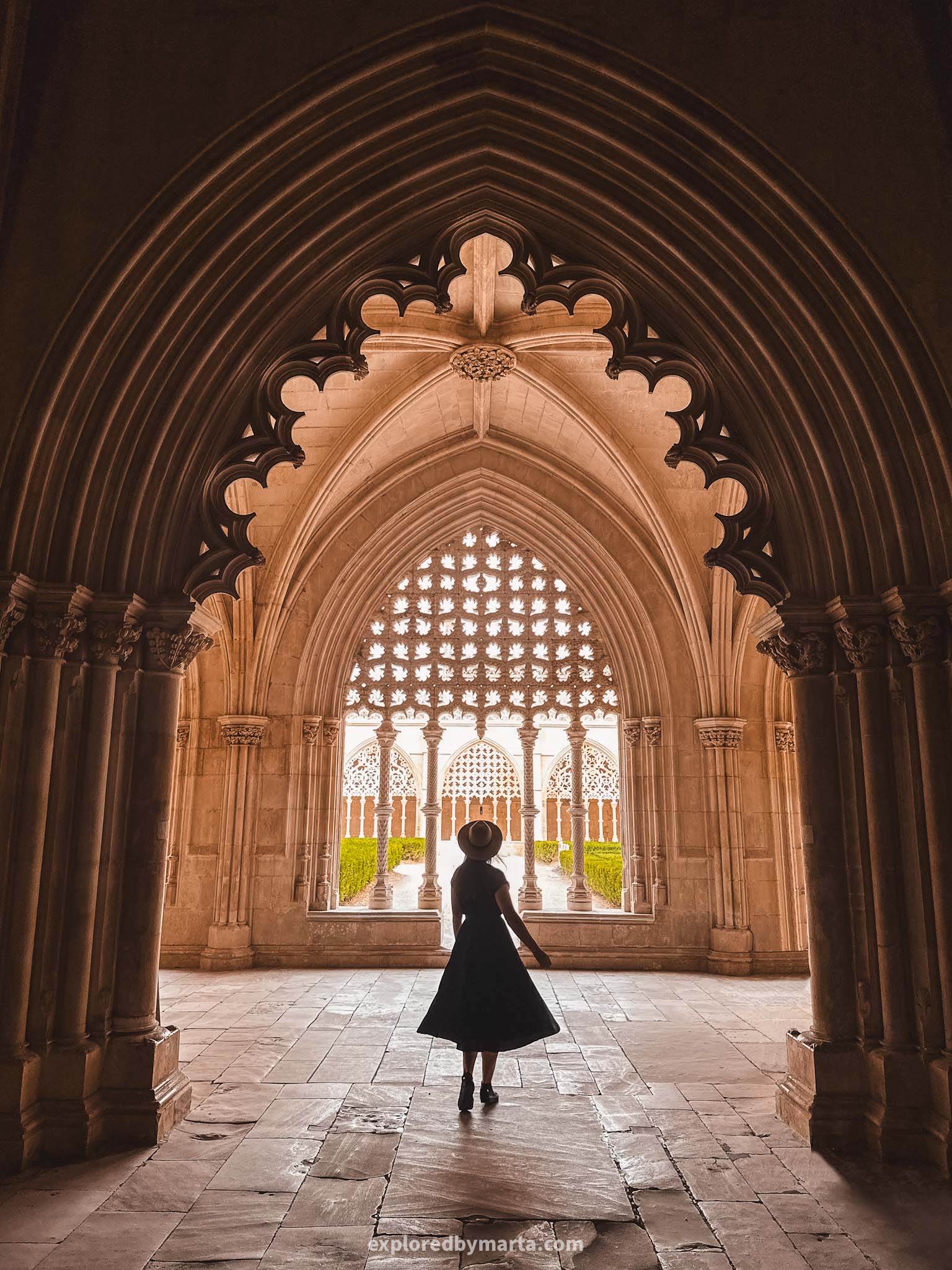
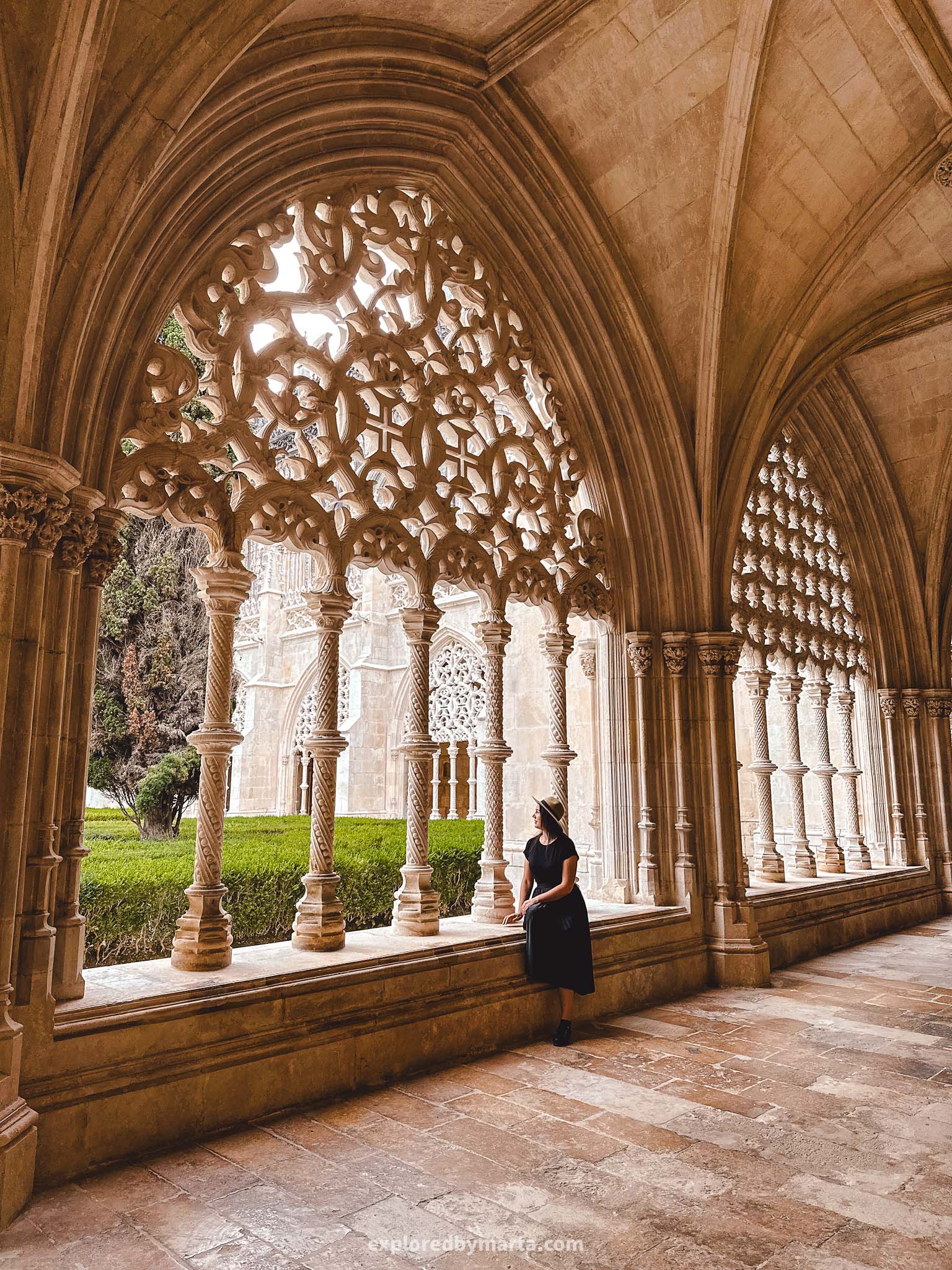
Batalha Monastery is now a UNESCO World Heritage Site and also one of the most important Gothic sites in Portugal. It also serves as the first royal pantheon in Portugal, filled with tombs of kings, queens, and princes.
Inside, you can visit the Founder’s Chapel, which holds the tombs of King João I and Queen Philippa of Lancaster, along with their sons, including Henry the Navigator.
But my favorite place inside the monastery was the famous Unfinished Chapels – the Pantheon that was never finished and has been roofless for centuries.
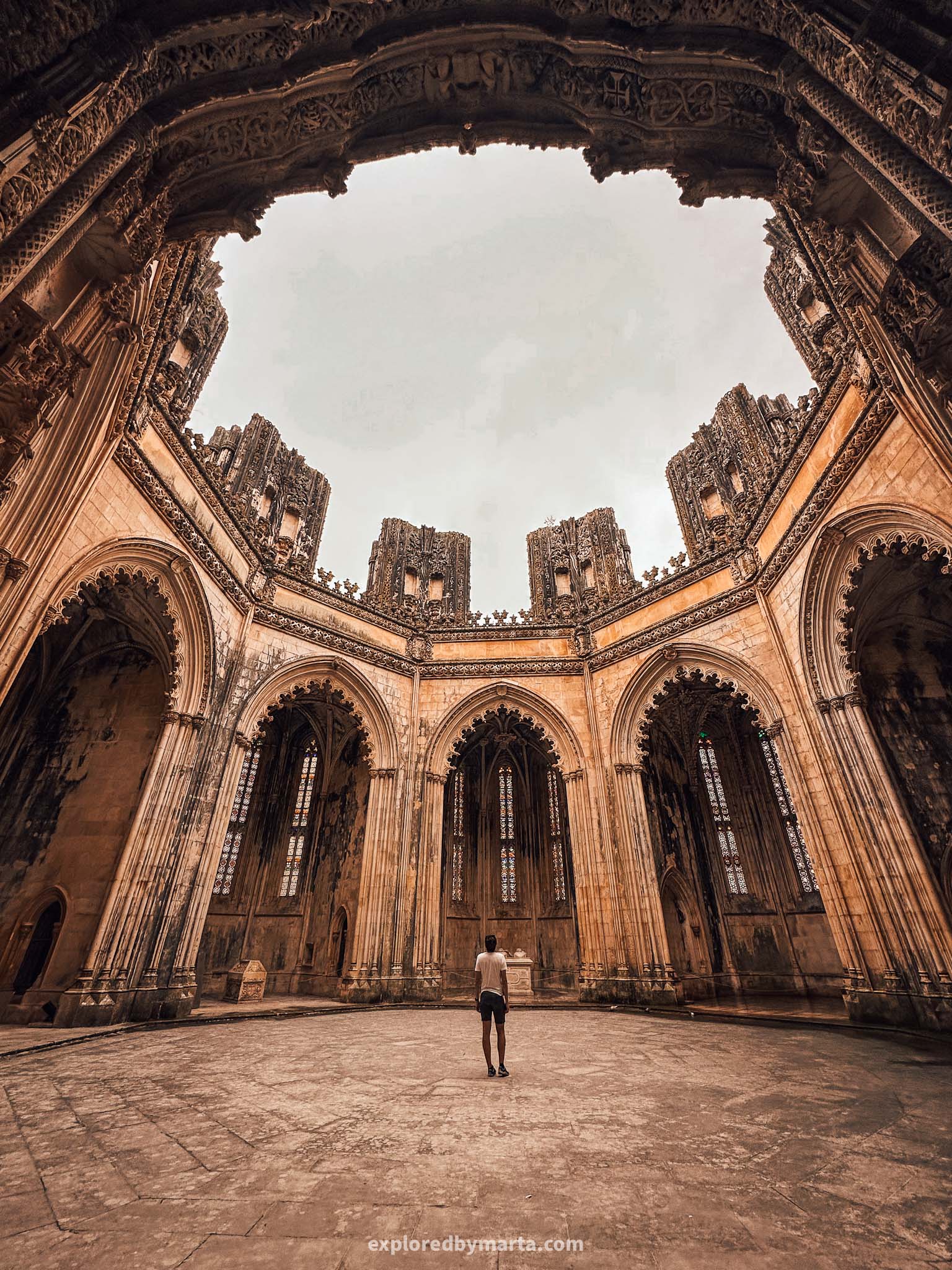
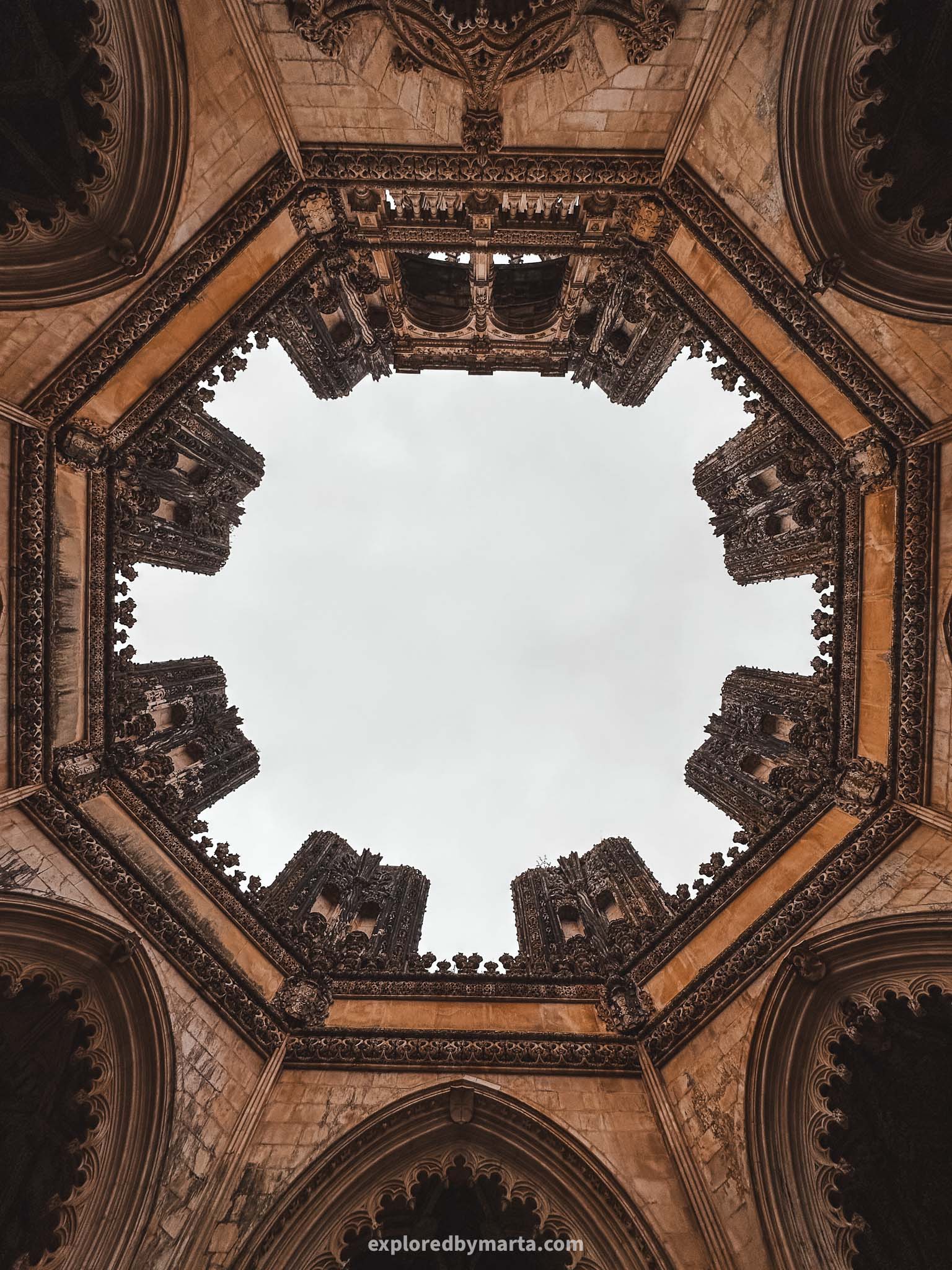
The Unfinished Chapels has one of the most extravagant entrances you’ll see built in Portugal’s intricate Manueline style.
It was a bit mindblowing to think that someone had to carve it with their hands (see the first photo with the entrance). No wonder it took so long to make it (and it wasn’t even finished!).
If you’re traveling through Portugal, the Batalha Monastery is a must-visit place! Plus, it is near a couple of other famous churches and sanctuaries like the ones in Fatima and Alcobaça, so you can plan a perfect day trip full of historical highlights (that’s what we did!)!
Location: Batalha Monastery
3. Sanctuary of Fátima – Shrine of the World
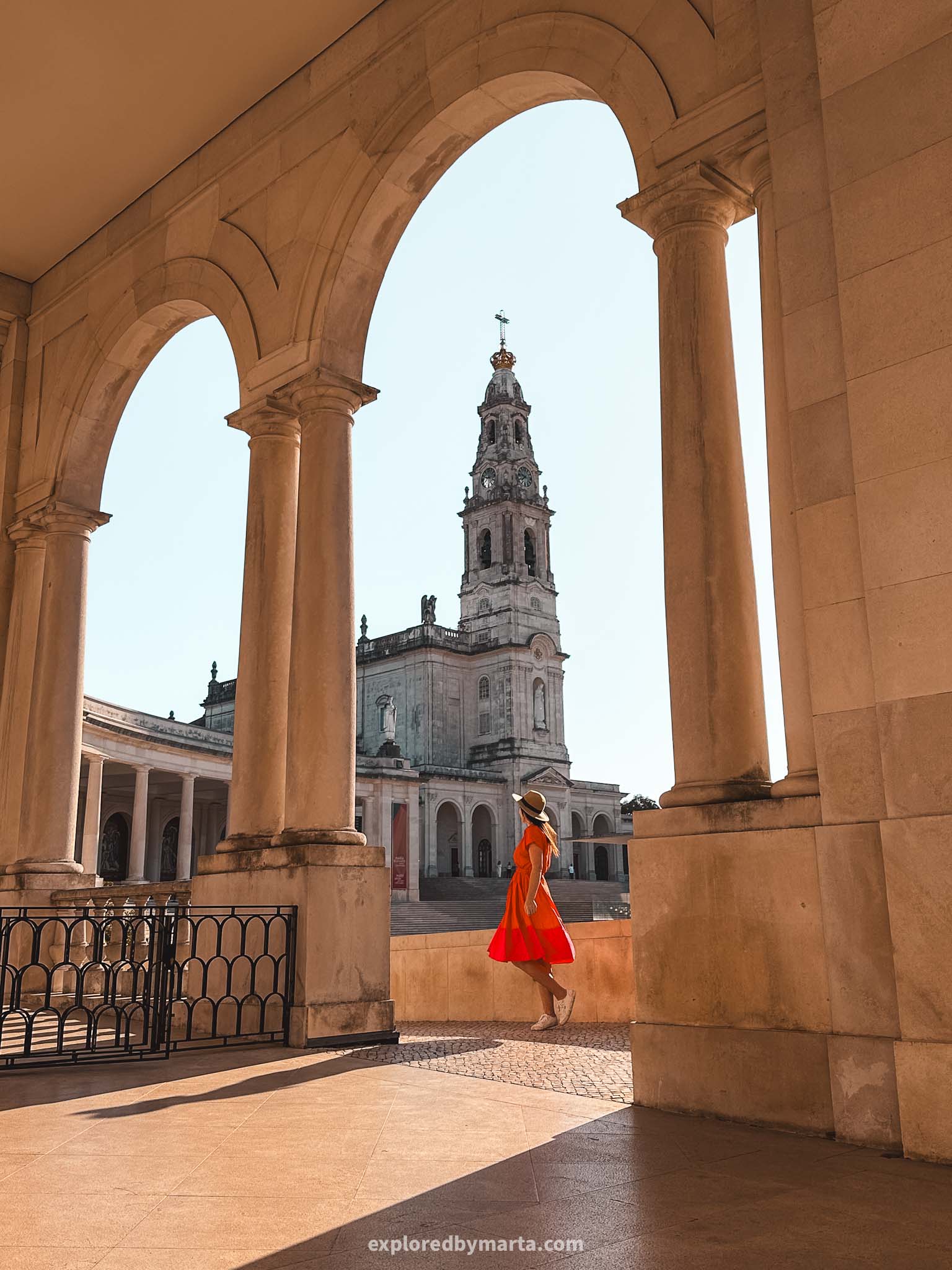
Sanctuary of Fátima is a massive shrine complex and a catholic pilgrimage site built in a place where, it is said, the Virgin Mary appeared to three kids in the early 1900s.
Overall, about four million pilgrims visit the basilica every year.
The sanctuary is located in Fátima town, about a 45-minute drive away from Nazaré and just over an hour ride from Lisbon. Even if you are not really interested in Catholic pilgrimage sites, it is still an impressive place to visit when in Portugal.
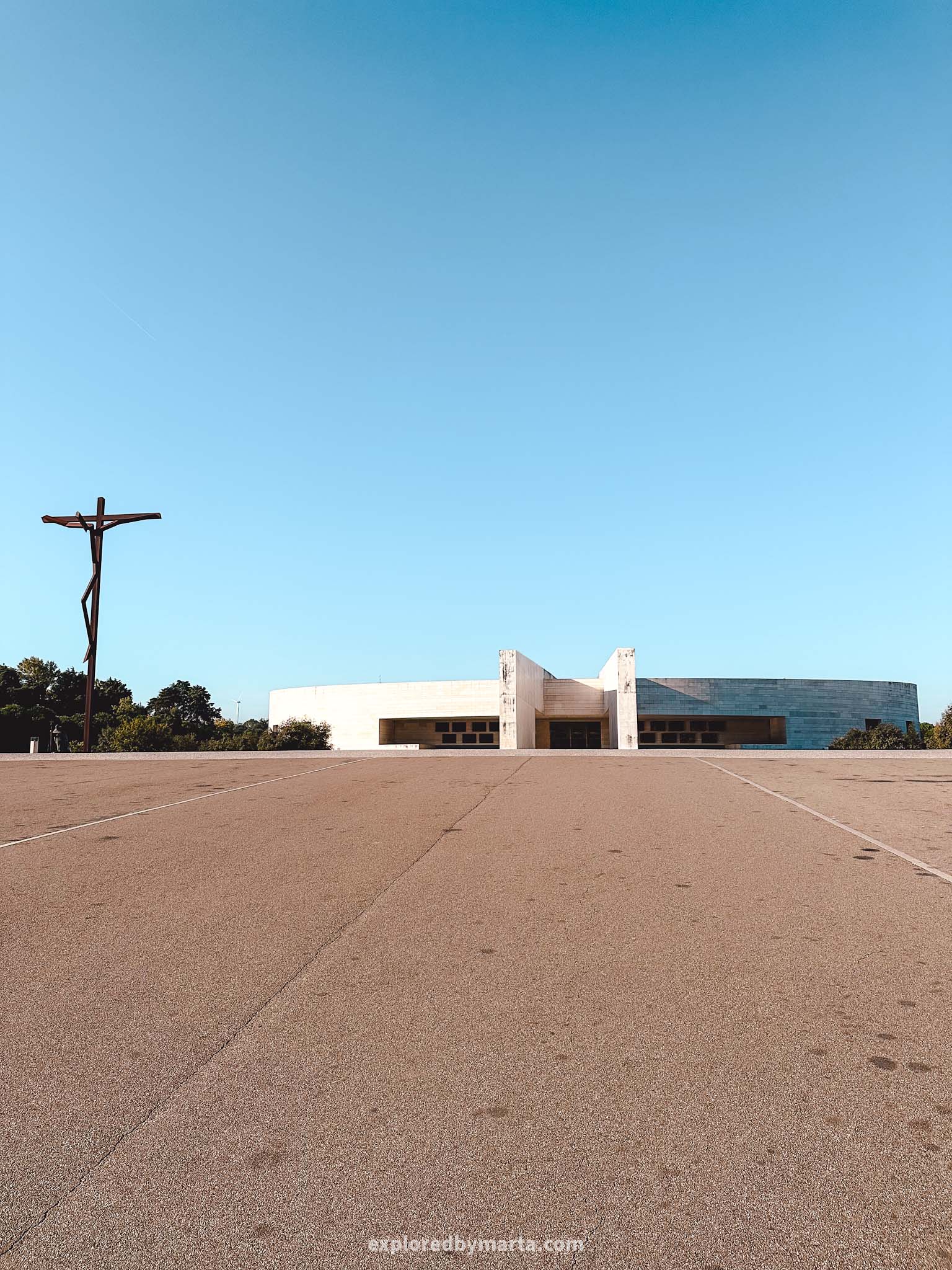
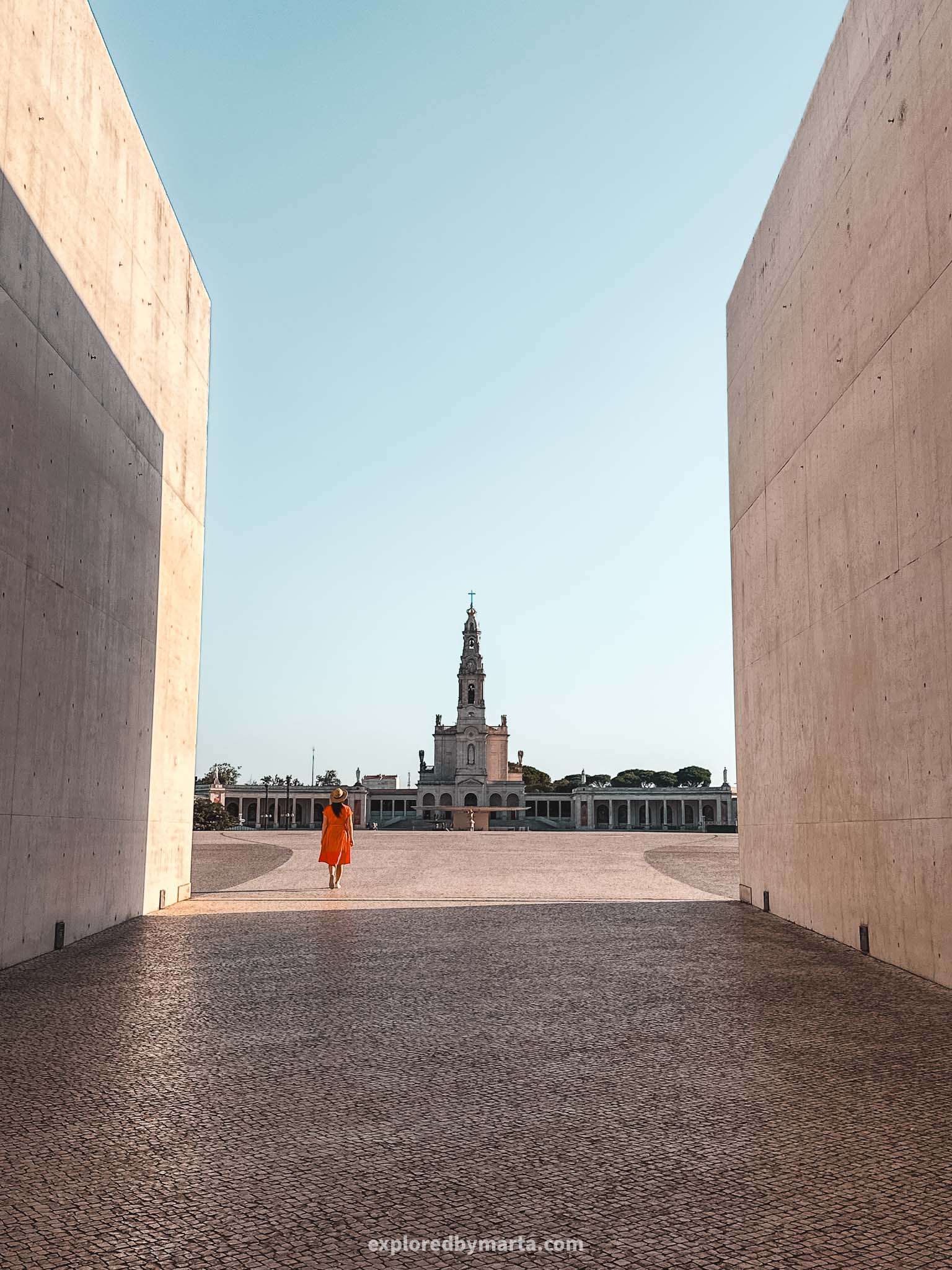
The massive complex consists of several monuments and buildings, like the Chapel of the Apparitions, which is the spot where the Virgin Mary allegedly appeared in 1917, the Basilica of Our Lady of the Rosary (main building), the massive Basilica of the Holy Trinity, and more.
The site is accessible to the public for free, but be sure to check online before going there, as there are regular events taking place on the site.
A rosary or mass won’t be a huge event (with exceptions), but there may be bigger celebrations as well, especially around religious holidays.


The most important dates related to the apparition of the Virgin Mary are the 13th of May and the 13th of October. Those dates will attract millions of pilgrims to the site, so take that into account when visiting this place.
We visited the Sanctuary of Fátima quite early in the morning, and there were already quite a few people visiting.
Don’t forget to walk through the Basilica of Our Lady of the Rosary church and pass by the tombs of the kids who claimed to have seen the Virgin Mary. You can visit this site as well as all the churches for free. This was definitely a unique place.
Location: Sanctuary of Fátima
4. Sanctuary of Our Lady of Remedies in Lamego

Santuário de Nossa Senhora dos Remédios, or Sanctuary of Our Lady of Remedies, located in Lamego town in Northern Portugal, was one of my favorite hidden gems we found in Portugal.
The sanctuary sits top of Santo Estêvão Hill and was built between the 18th and 20th centuries. It can be accessed from the town by a long Baroque staircase of 686 steps, but you can drive up there by car as well.


However, it takes away the magic of climbing the beautiful stairs. To me, climbing the stairs was the best part of the experience. We climbed all the way up there, explored the sanctuary, and then climbed back down.
Building sanctuaries on top of hills and then adding majestic, long staircases up to them is not uncommon in Portugal. We found a couple of similar spots around Portugal. But this iconic staircase in Lamego with statues and azulejos tiles was my favorite of them all!
Location: Santuário de Nossa Senhora dos Remédios
5. Cathedral of Évora

The Cathedral of Évora is truly a masterpiece! Known as the biggest medieval cathedral in Portugal, it is truly a majestic sight to witness! It is also one of the most important examples of Gothic architecture in Portugal.
Visiting the cathedral and climbing up to the cathedral’s roof is one of the top things to do in Évora!
The construction of the cathedral started in the 12th century, when a modest version of the cathedral was built. However, over time, it was enlarged and new parts to the complex were added until its completion in the 18th century.
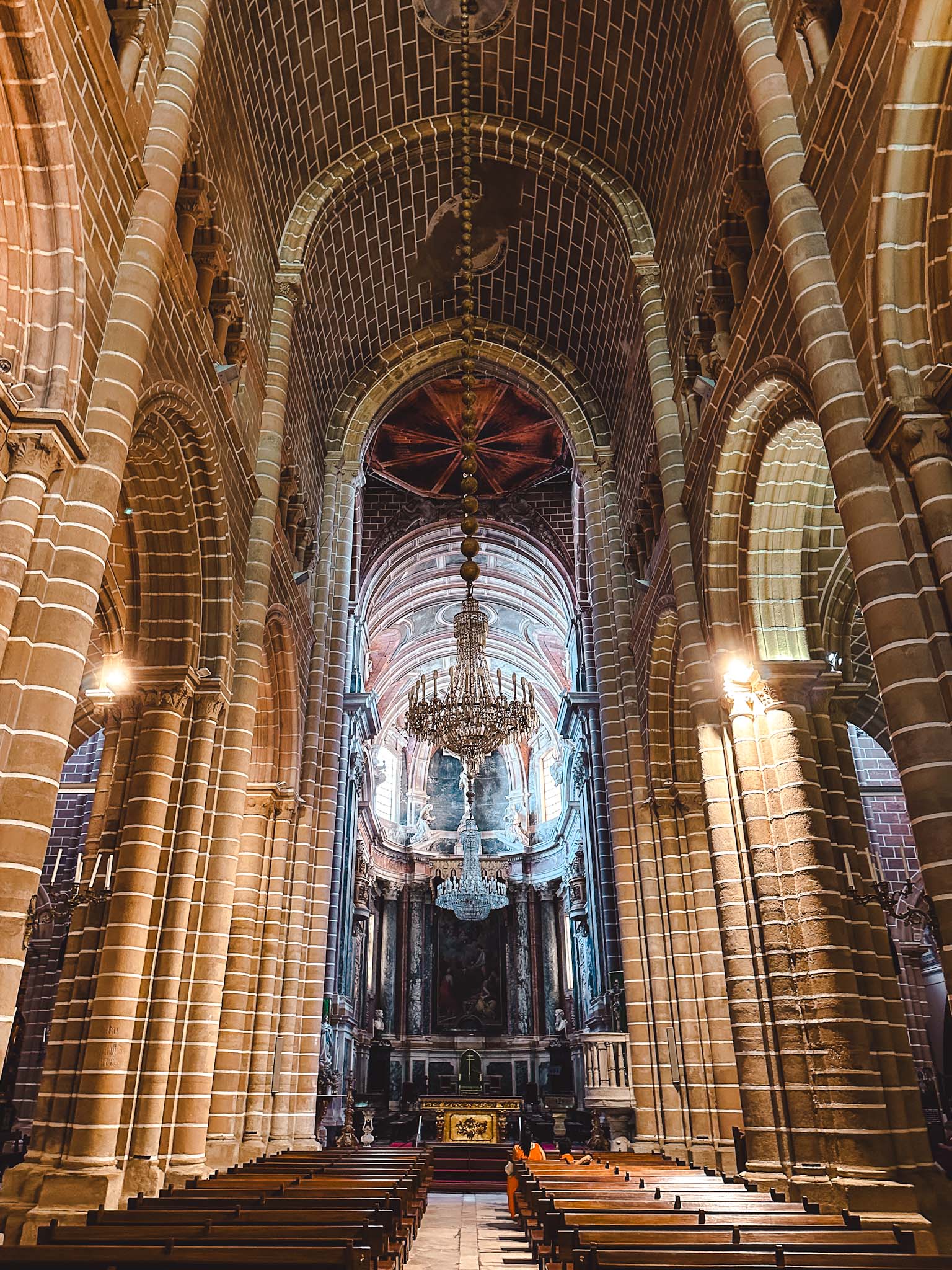

There is a small entrance fee to visit the cathedral. You can check the prices of the Cathedral of Évora on their website. There is a possibility to visit a museum as well, but we skipped this option.
The entrance fee (excluding the museum) permits you to climb up to the roof of the cathedral, which was one of my favorite things we did in the city.
You also get to see the church as well as walk around the cloister, a rectangular courtyard attached to the cathedral.
I love climbing up to the rooftops, and this was one of the most beautiful rooftops I got to visit in Portugal! You have to climb up at the very beginning of the visit. You’ll walk around the rest of the building afterward.


Once you are on the roof, you will notice that the cathedral has a very striking and picturesque lantern tower with multiple spires (see first photo!). This rooftop is the highest place in Évora where you can get panoramic views over the entire city center.
After the visit to the rooftop, you can then climb back down and explore the rest of the complex – the church, walk around the cloister, climb up to the roof of the courtyard building, and visit the rooms around the perimeter.
The cathedral was my favorite place in the beautiful Évora, the capital of the Alentejo region! The visit will take at least one hour as there is a lot to admire. This was a highlight of our visit and is definitely amongst the most beautiful churches in Portugal!
Location: Cathedral of Évora
6. Sé de Braga, the oldest cathedral in Portugal
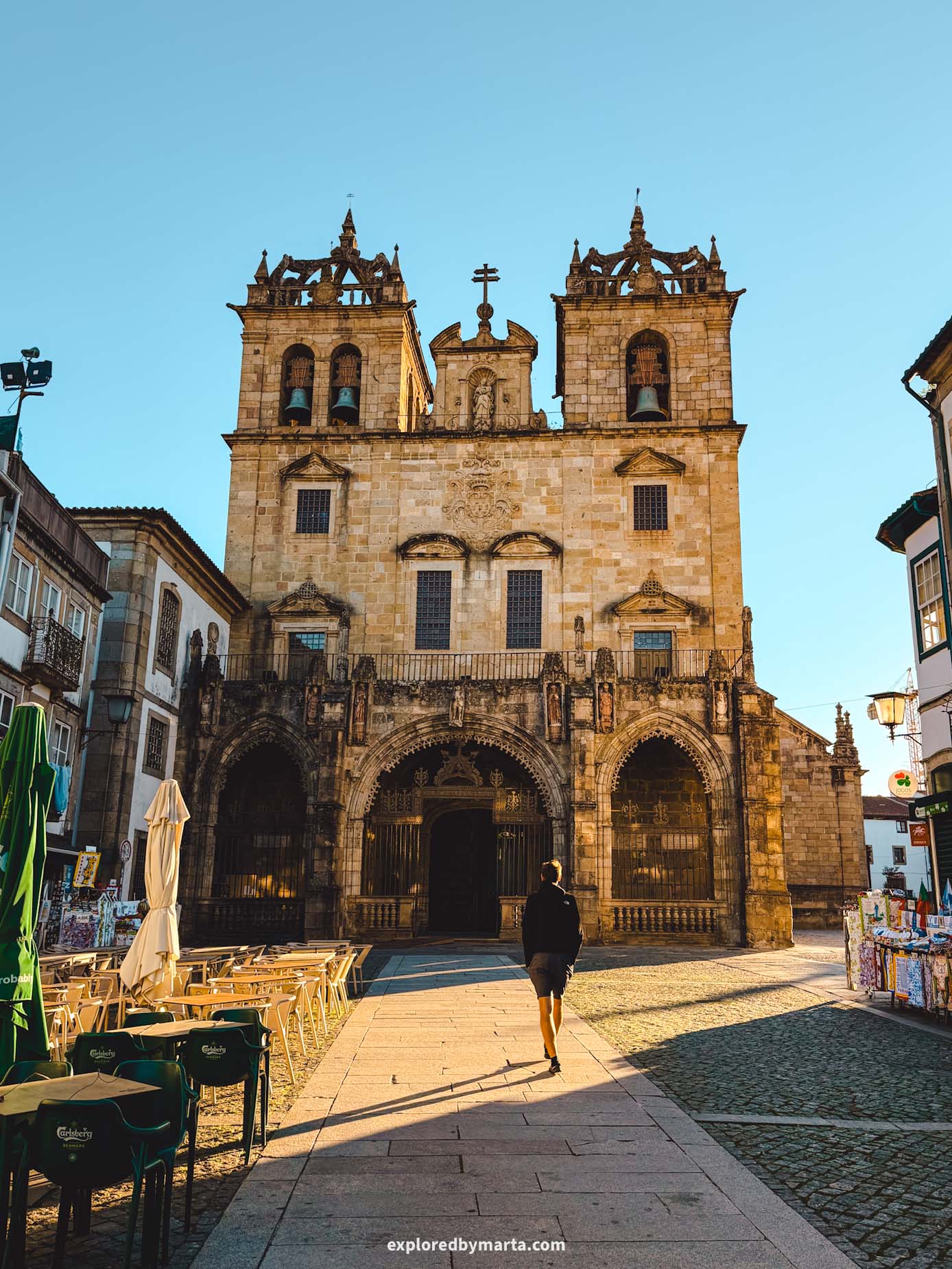

Another favorite of mine is Sé de Braga, or Braga Cathedral, which is, without a doubt, one of the main attractions in this city.
Braga Cathedral is not just one of the many cathedrals you’ll probably stumble across while road-tripping around Portugal. It is actually the very first and oldest cathedral in the country.
Sé de Braga dates back to the 11th century and is older than Portugal itself. No matter if you are a religious traveler or not, this splendid architectural wonder is a must-visit place in Braga.

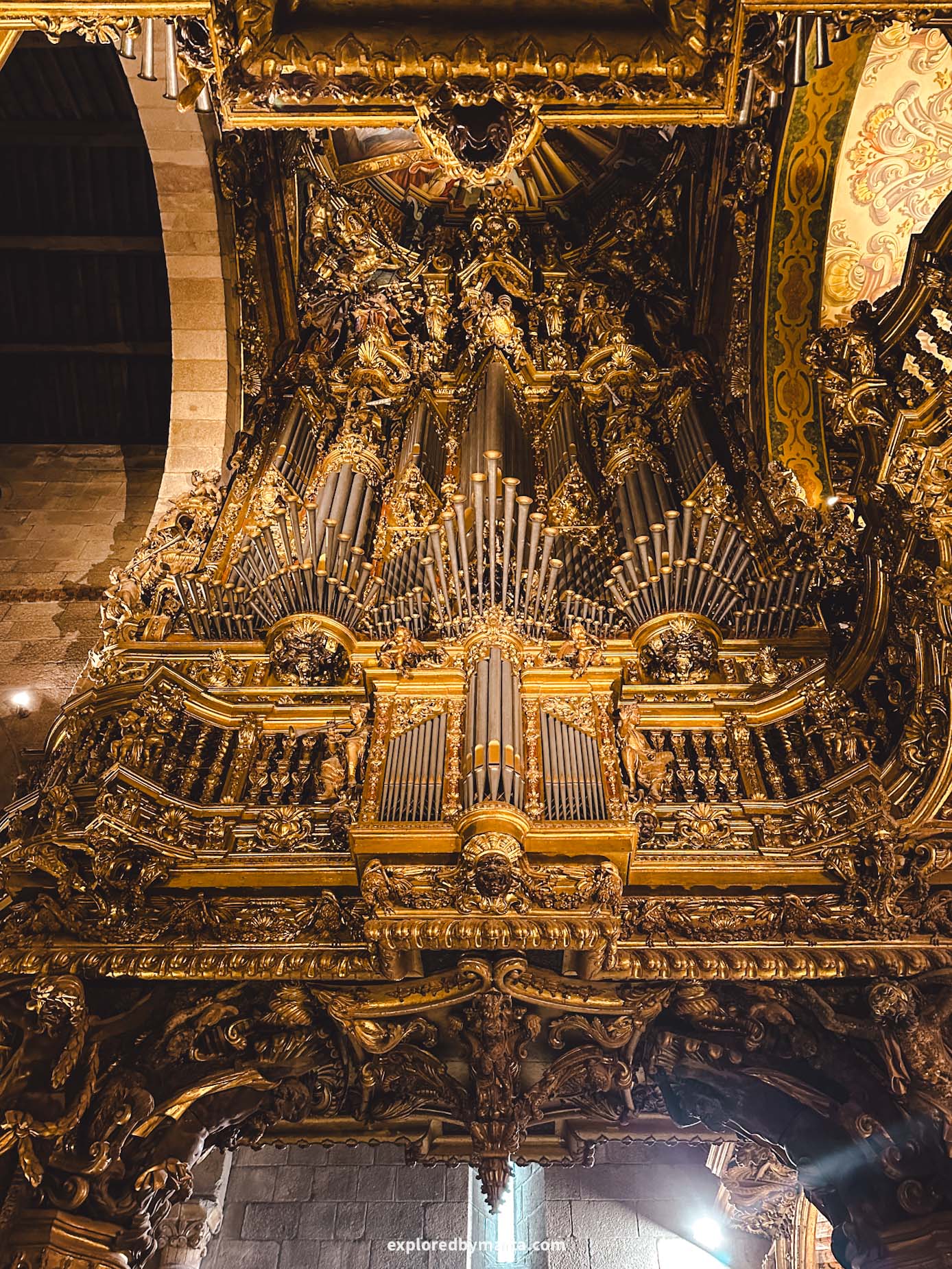
Go there for the history, go there for the relics, go there for the architecture!
The cathedral is located in the very heart of the old town, and you can visit it for a small entrance fee. We actually paid a little extra and bought a combined ticket to climb up to the high choir and visit the cathedral museum on the upper floors.
Just make sure to find the right entrance – you can get to the ticket office from the side entrance located in the cloister next to Igreja Misericórdia, and not through the main doors.
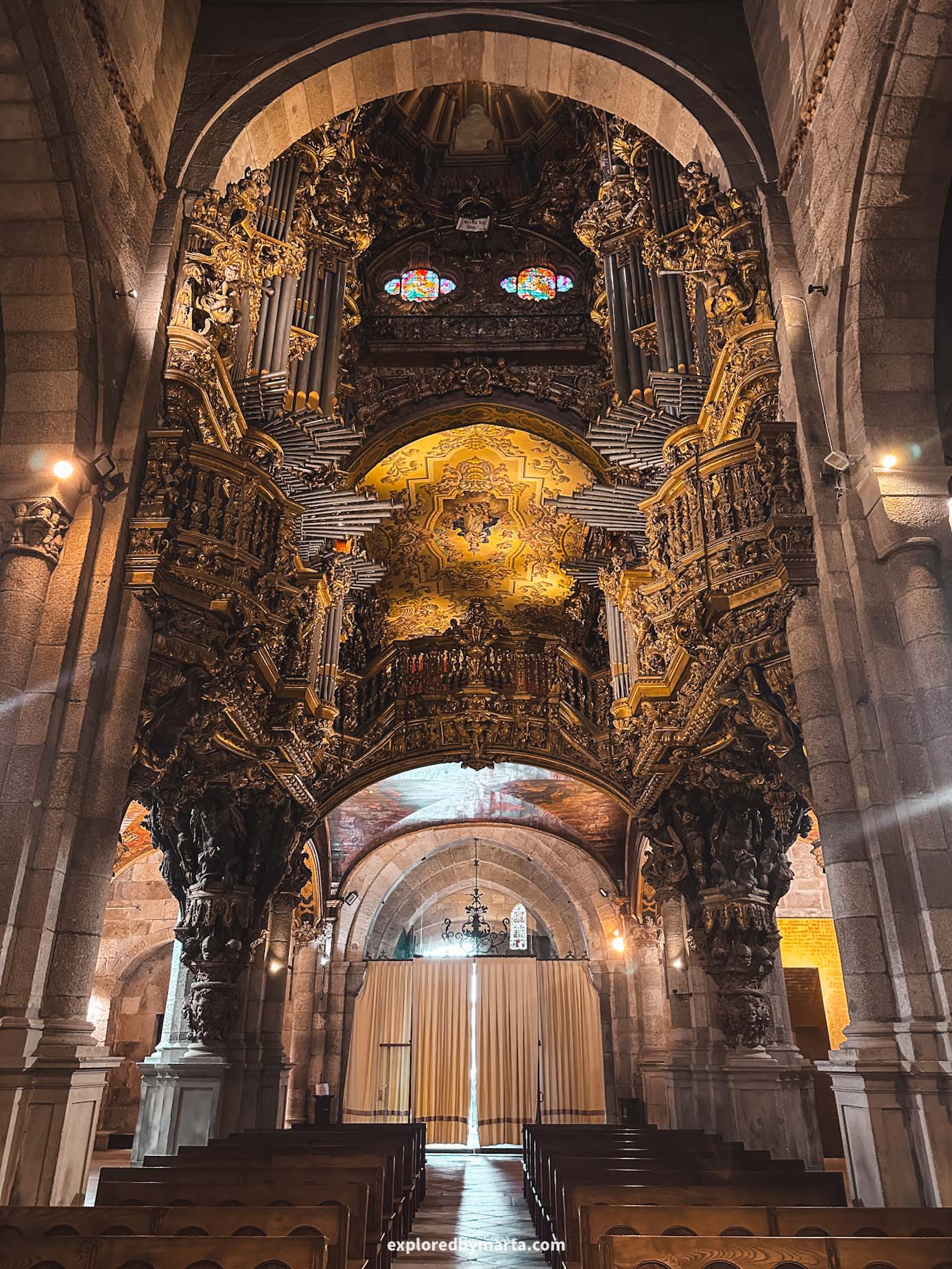
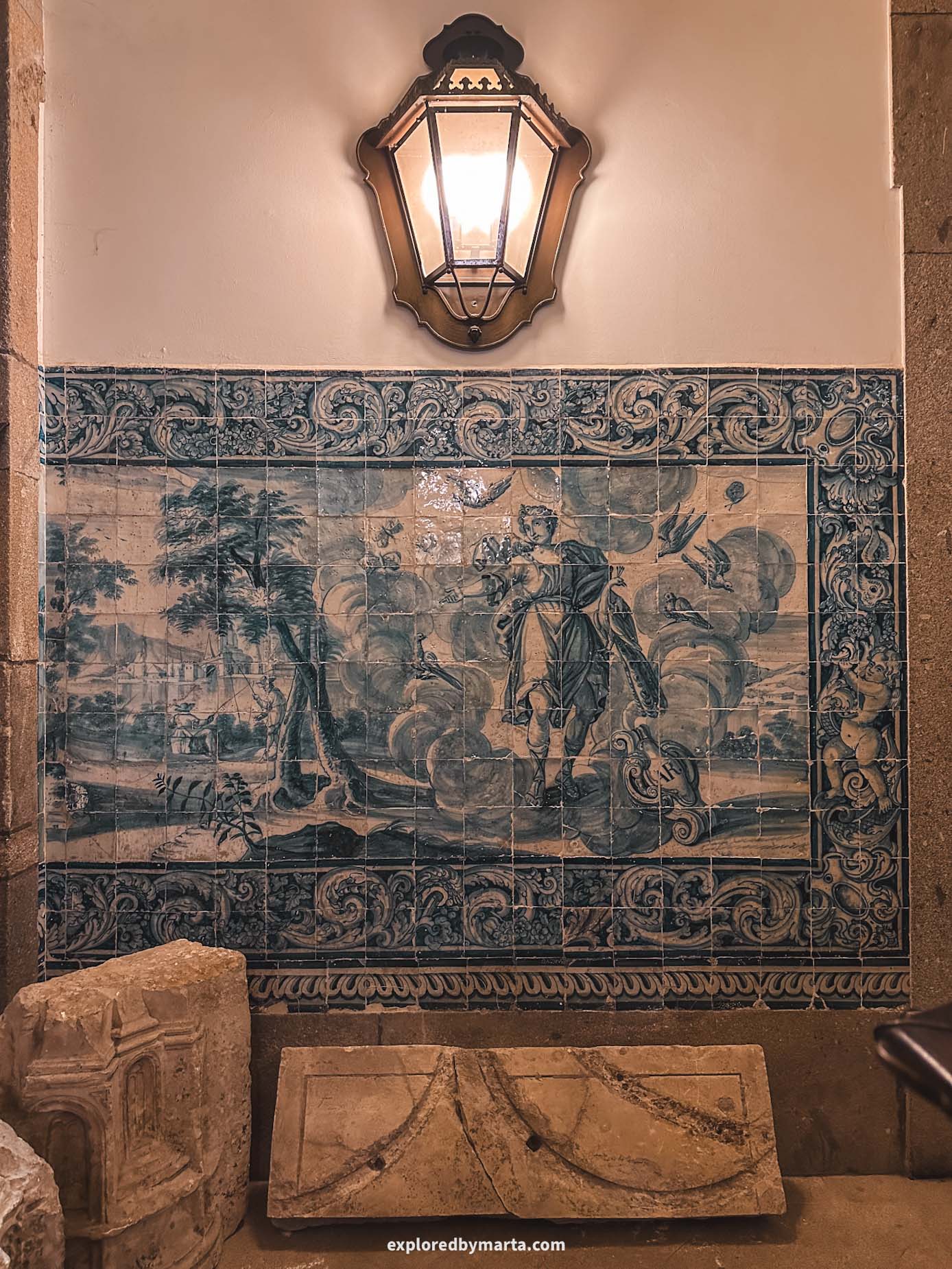
The cathedral is actually everything you would expect from a medieval cathedral – dark, moody, built with stone and wood, and decorated with stole statues, gilded altars, and metal lanterns. I really loved it!
The architecture there reflects many centuries of restorations and expansions as it combines different styles like Gothic, Manueline, Baroque, among others.
The cathedral also hosts the tombs of Henry and Teresa of Burgundy, who were the parents of Afonso Henriques, Portugal’s first king.
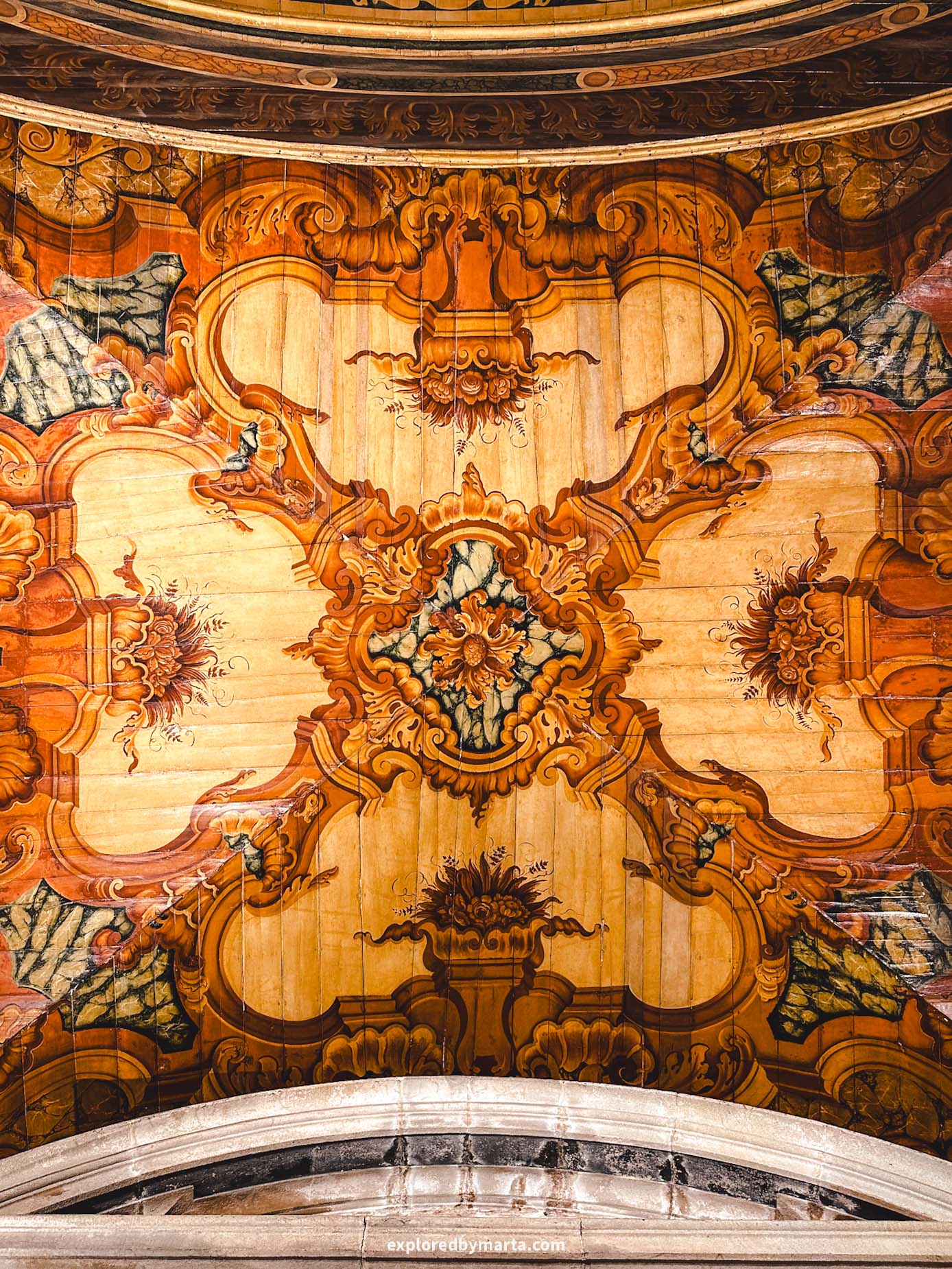

If you decide to pay extra for a combined ticket like we did, you’ll also get to visit the upper floor and see sacred art, ancient relics, and the choir stalls. I guess the museum was quite interesting, but nothing spectacular, so I’m not sure if it is really worth paying extra for.
If you love art and history, then definitely go for it, but if you are just a regular traveler, you won’t miss anything by not visiting the museum. But the cathedral is a must!
Braga Cathedral is definitely one of the most visited monuments in the city, so make sure to arrive early to beat the midday crowds! It isn’t just a historical monument or a building – the cathedral is an important piece of Portugal’s story, so I hope you get to visit it!
Location: Sé de Braga
7. Jerónimos Monastery
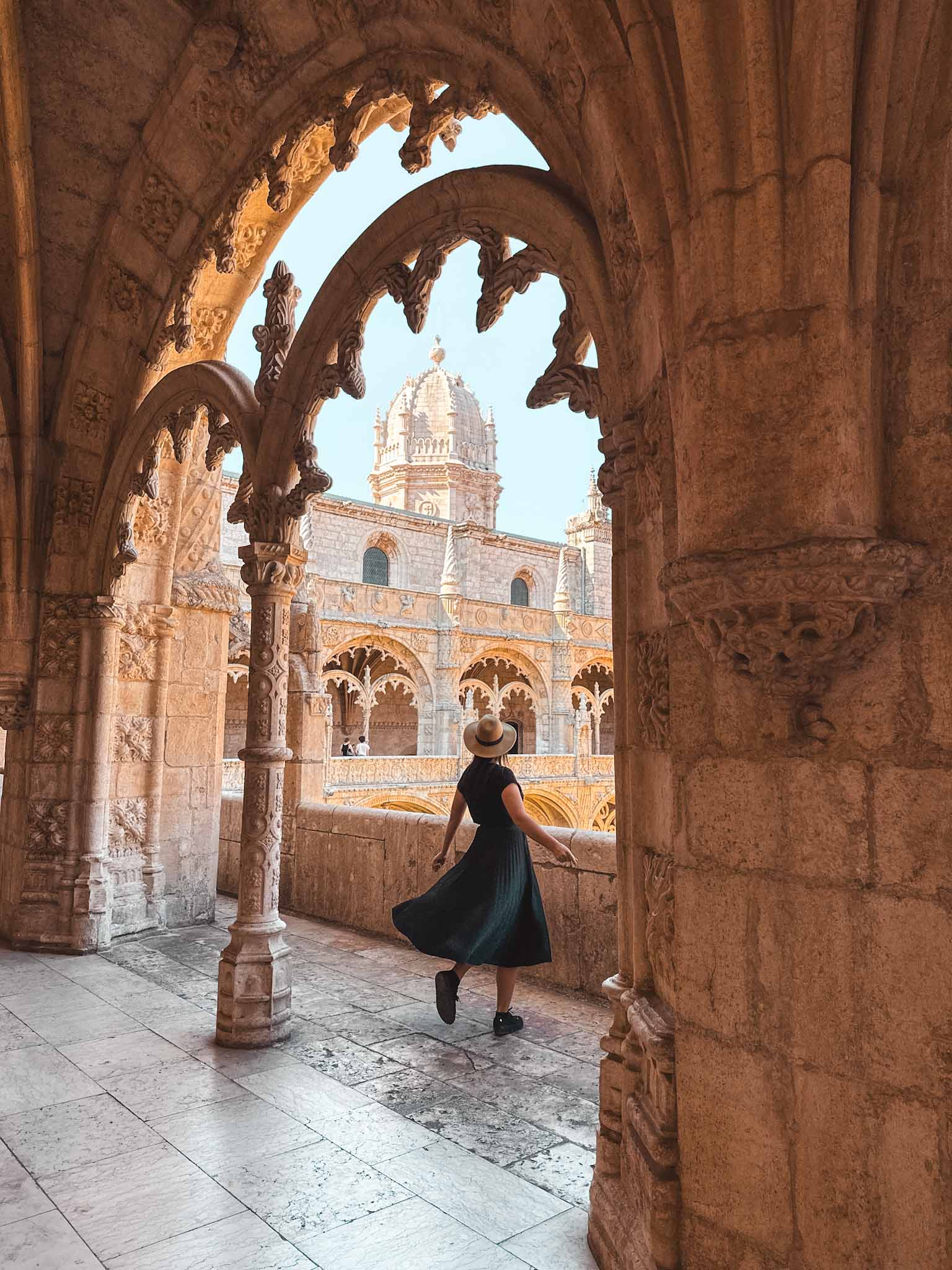
Located in the Belém district in Lisbon, the iconic Jerónimos Monastery is one of the bucket list places to visit in Lisbon, and, it comes as no surprise, has been voted by the Portuguese as one of the Seven Wonders of Portugal.
Mosteiro dos Jerónimos, as they say in Portuguese, is also a prominent example of the Portuguese late Gothic architectural style – Manueline. It was, without a doubt, one of my favorite places to visit in Lisbon and Portugal.
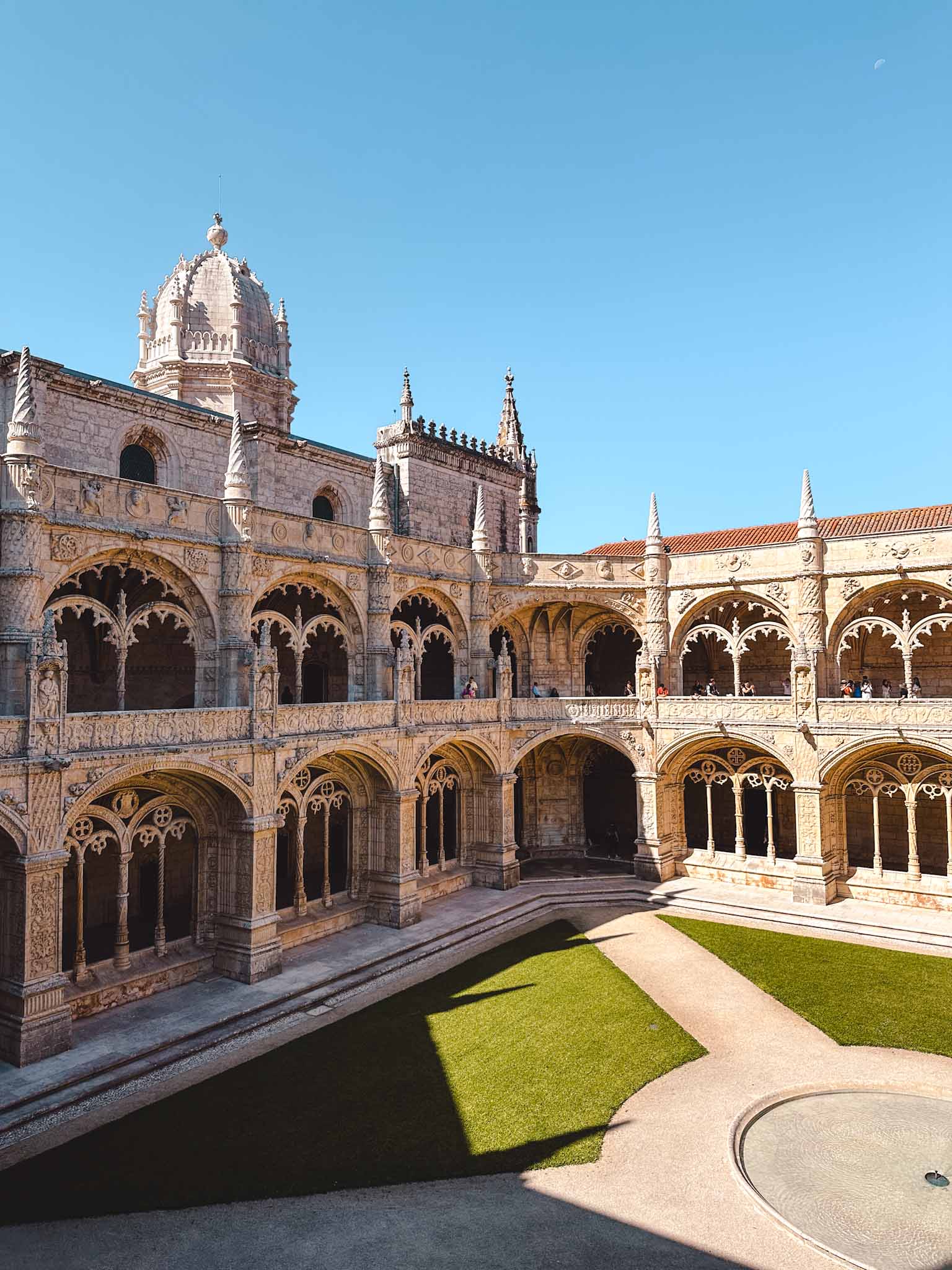

The monastery is a 16th-century masterpiece listed as a UNESCO World Heritage Site and is definitely a must-see place in Lisbon! Although the only place you will see during your visit is the big courtyard and some rooms connected to it, it is still well worth it!
Once you get to the courtyard, you can walk around the ground floor and admire the architecture as well as some of the rooms that are connected to it and house tombs of some important figures in Portugal’s history.
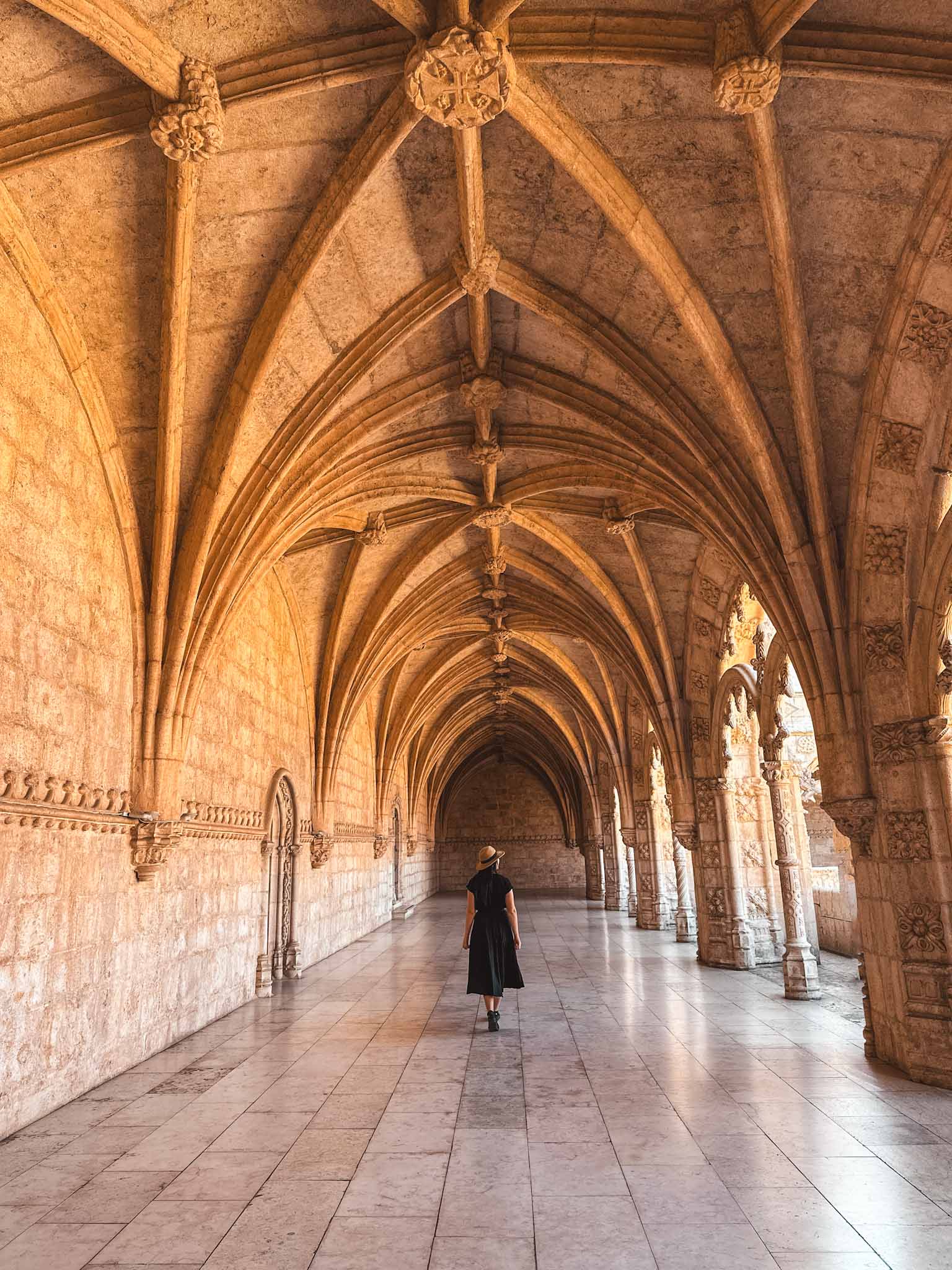
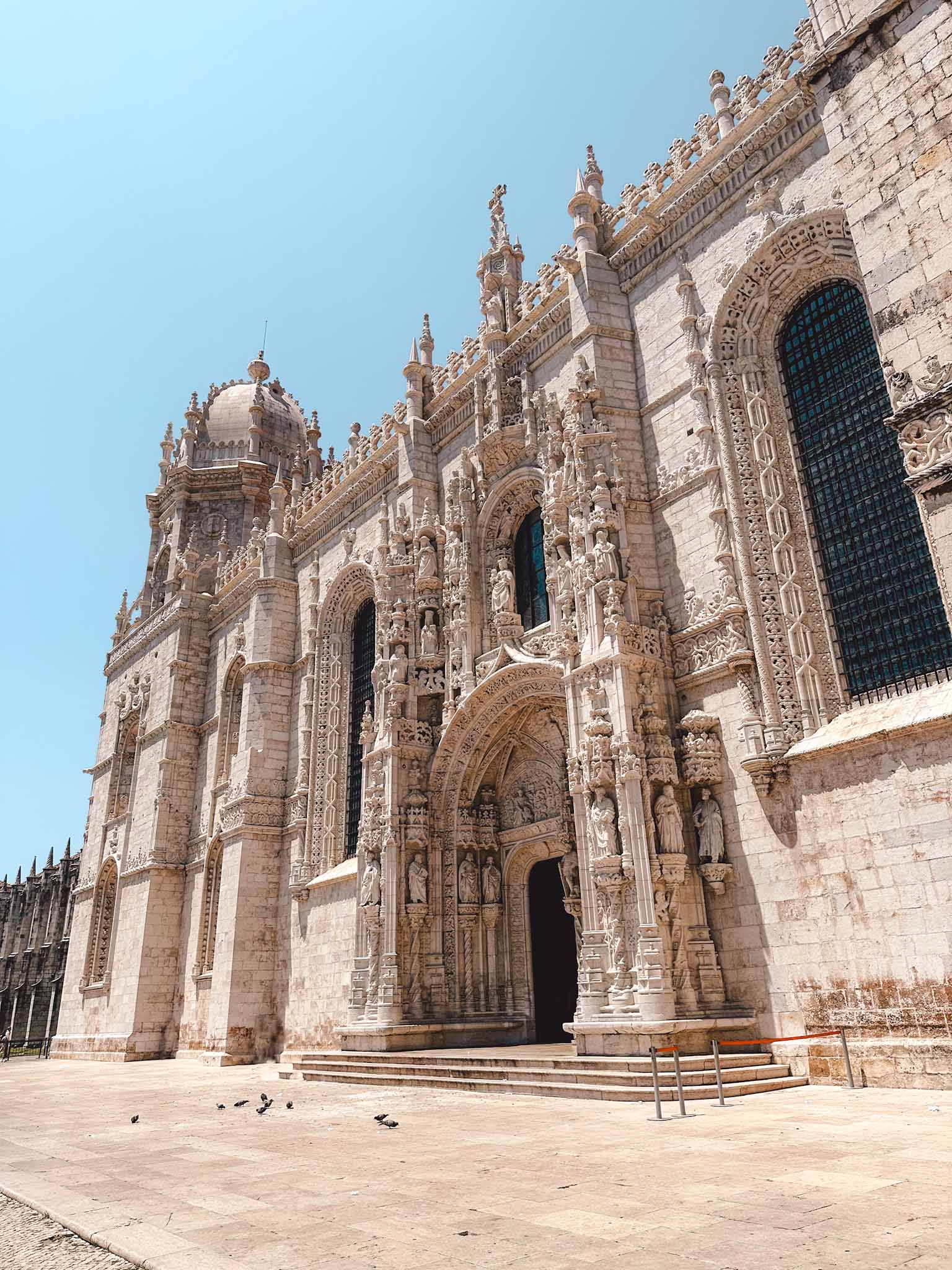
Once you finish circling around, you can then climb up to the upper floor. The upper floor of the courtyard was my favorite. You get a nice overview of the whole area from above and the intricate architectural details up close.
Imagining all the work that was put into creating this masterpiece is mind-boggling. In terms of architecture, it will be hard to find a more beautiful place in Lisbon than Jerónimos Monastery! One of the most incredible historical monuments for sure!

Interestingly, Jerónimos Monastery is the former monastery of the Order of Saint Jerome, whose monks were the ones who created the recipe for the world-famous Portuguese egg tart – pastel de nata – right here in this place.
The monastery is connected to a church (the entrance to the church is next to the monastery, and it has its own opening hours), which is the final resting place for King Manuel I, King John III, and the famous Portuguese explorer Vasco da Gama.
Do not miss this place when visiting Portugal!
Location: Jerónimos Monastery – Entrance to the monastery
8. Chapel of Souls in Porto

The Chapel of Souls, or Capela das Almas, in Porto, is one of the most photographed churches in Portugal! This charming and stunning church immediately catches your eye with its dazzling blue-and-white azulejo-covered facade.
The tiles depict scenes from the lives of Saint Francis of Assisi and Saint Catherine, and there are 15,947 azulejo tiles covering the exterior walls. How incredible!?
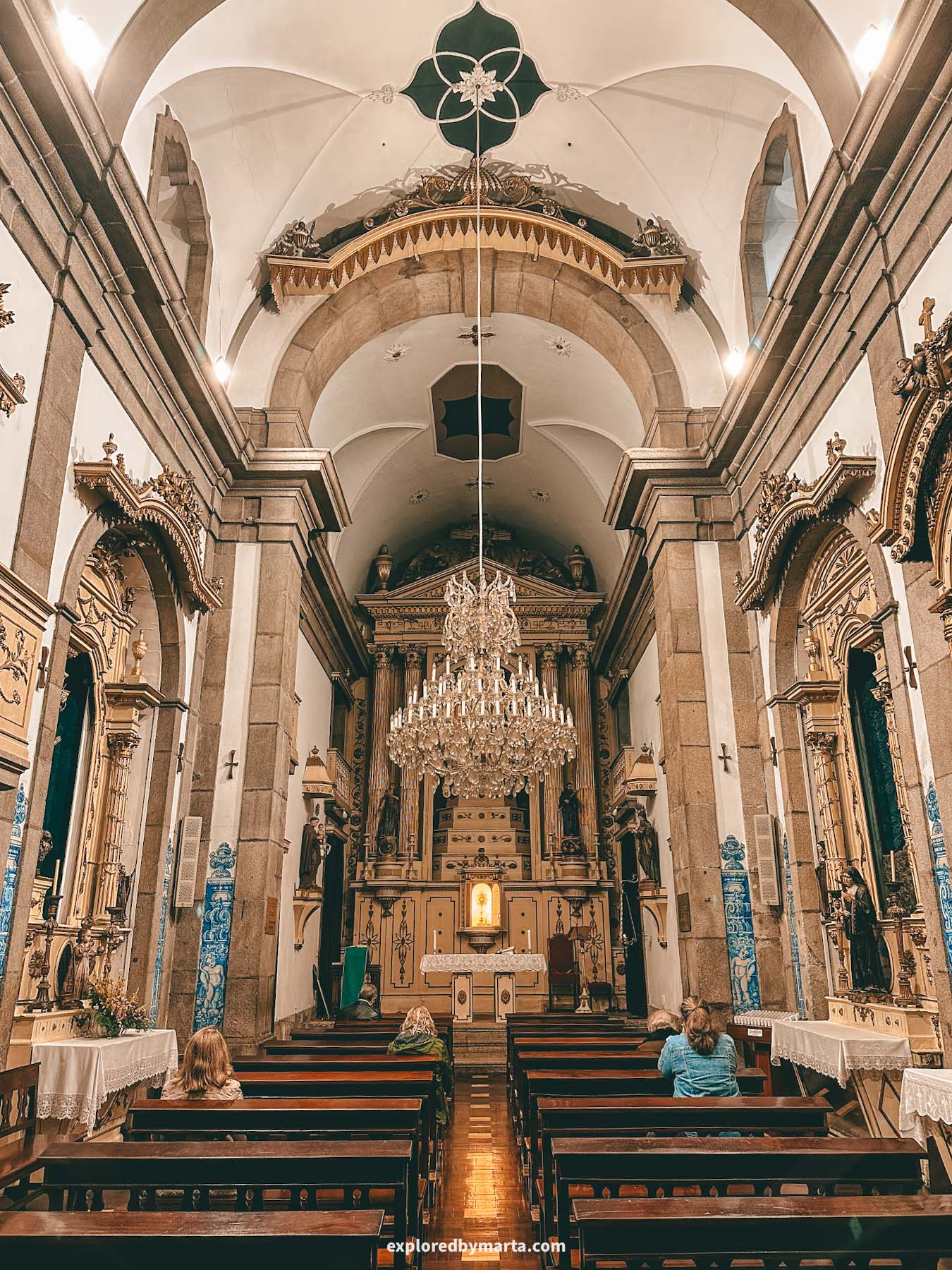

This 18th-century chapel was once just a regular white church in the city, but ever since these traditional azulejo tiles were added in the early 20th century, this chapel has been turned into one of Porto’s most recognizable landmarks.
The interior of the chapel is rather simple and peaceful. It is definitely a quiet escape from the lively shopping street outside. You can peek inside for free.
If you’re exploring Porto during your travels around Portugal, don’t miss a visit to the charming Chapel of Souls. If you want to catch a photo by the blue wall, then try to come earlier to beat the crowds!
Location: Capela das Almas de Santa Catarina
9. The round church in the Convent of Christ


Tomar is one of the most fascinating places we visited in Portugal!
Known as the home of the Knights Templar, Tomar is filled with rich history, incredible architecture, and legends. There is only one reason people travel to Tomar, and it is to visit the majestic Convent of Christ.
Located about an hour and a half north of Lisbon, this small city hosts one of the most important monuments in Portugal’s history (and a UNESCO World Heritage Site).
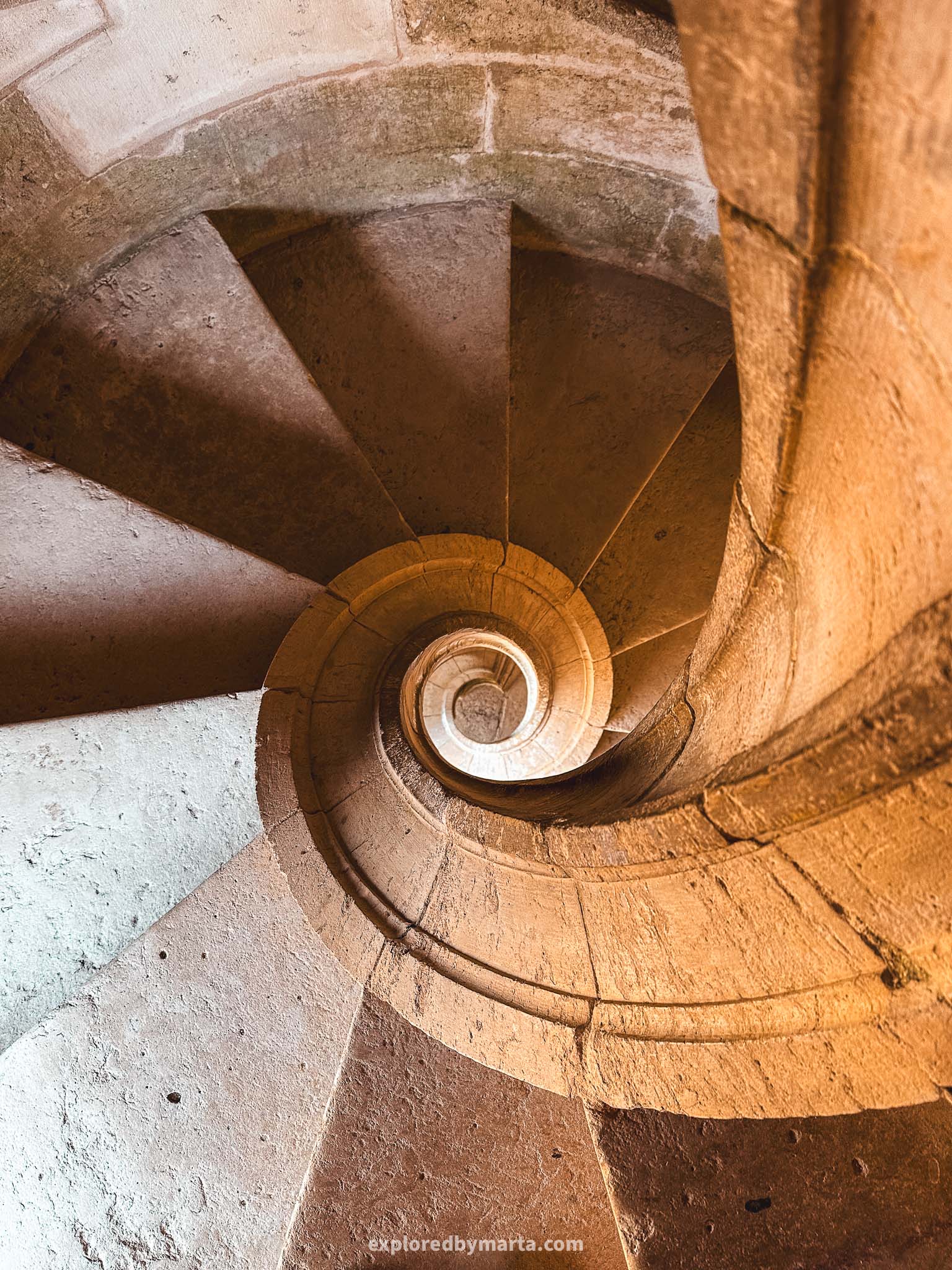

The Convent of Christ was founded in the 12th century as the headquarters of the Knights Templar, a powerful military order of warrior monks who played a major role in Portugal’s formation. The construction of the impressive building complex took about five centuries!
One of the most beautiful places in the convent is the 12th-century Oratory of the Templars – the famous round church (called a ‘rotunda’) covered with intricate frescoes and paintings (see the first two photos).
Another famous architectural artwork that you can visit in the Convent of Christ is the Chapter Window (photo below). The Manueline window is filled with maritime themes, including ropes, wood, buoys, and others.
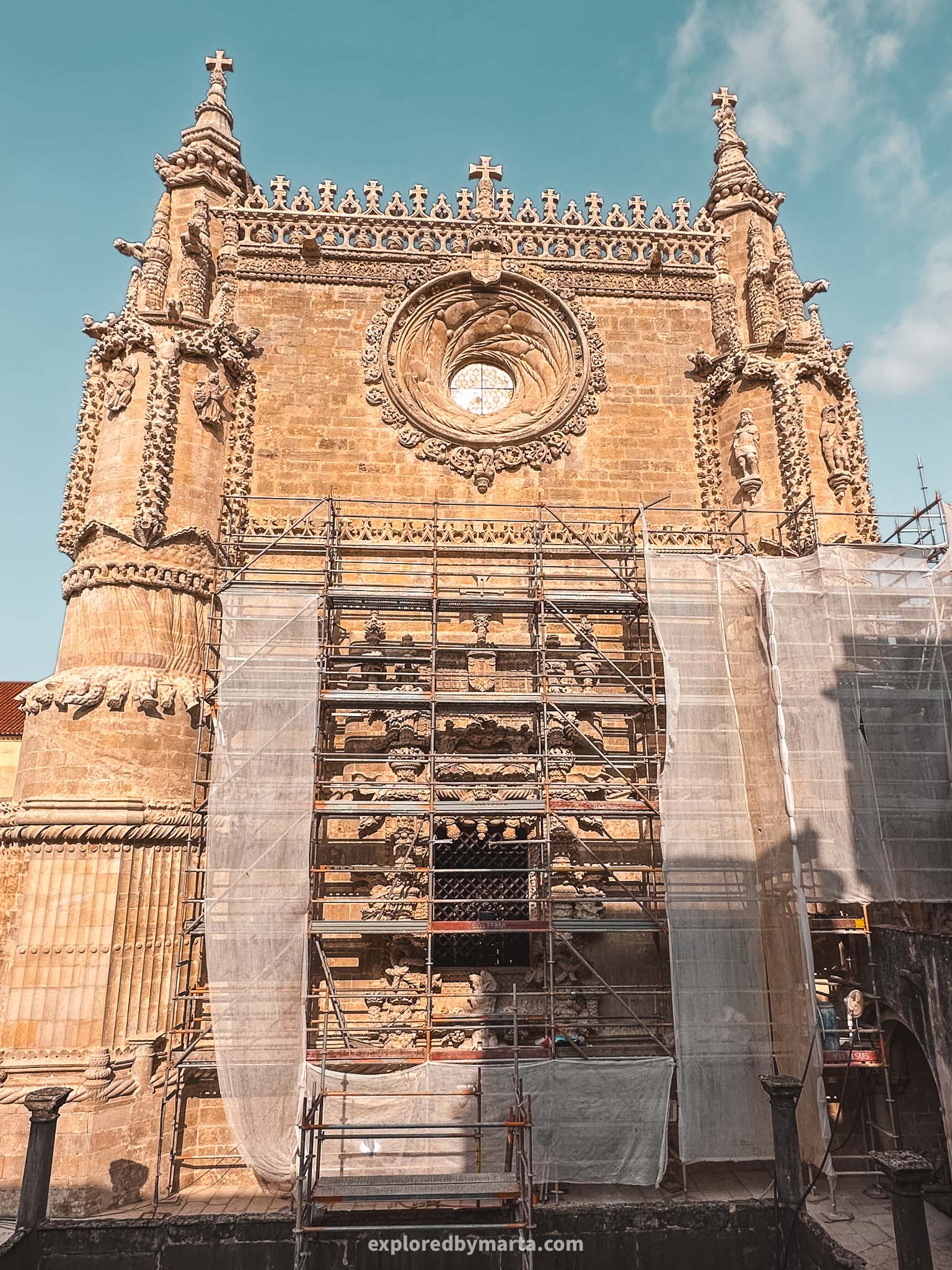
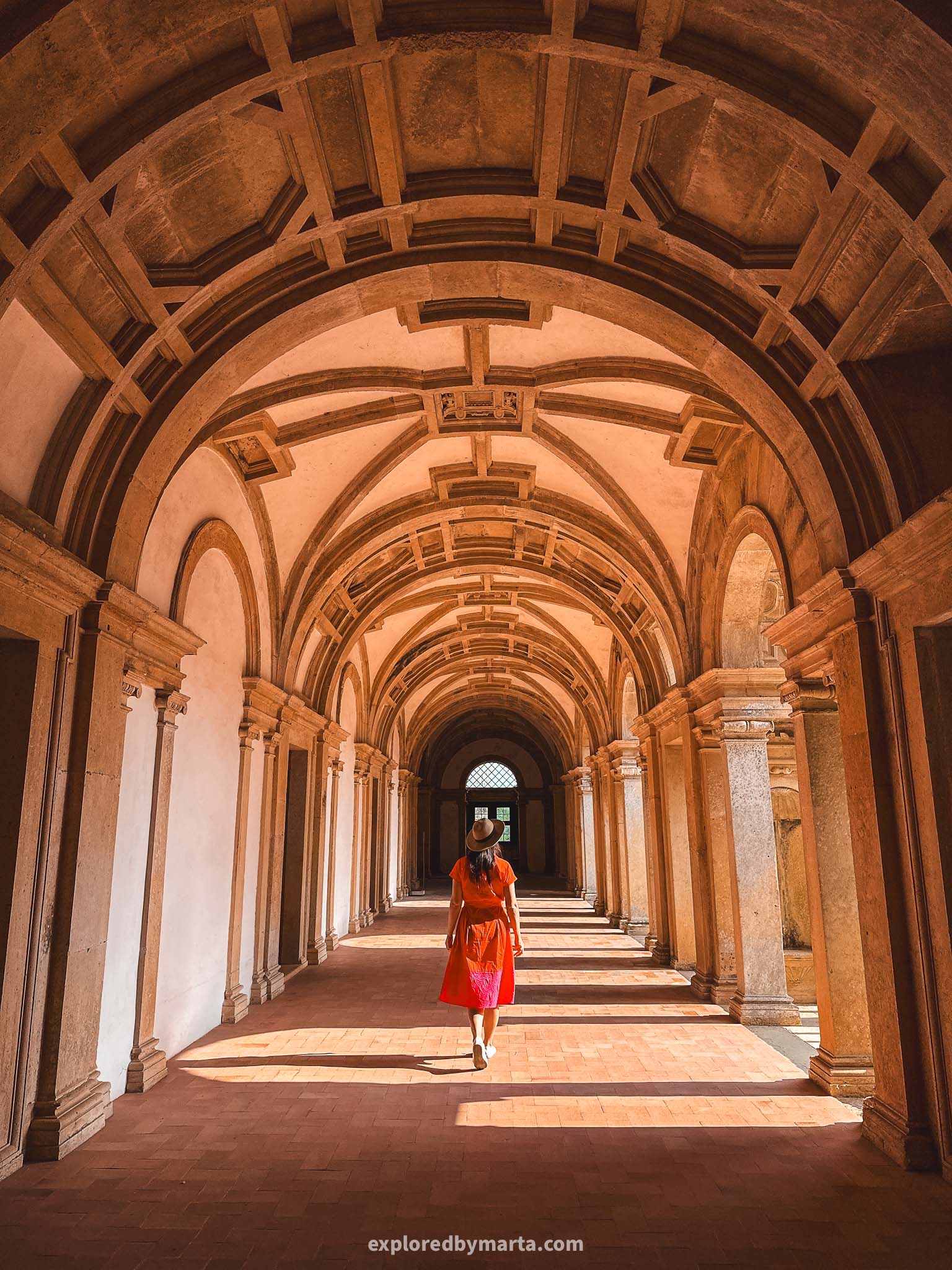
I’ll never know why they had to renovate it during our visit, haha. Okay, but we did see it through the fences. But one of my personal favorite places in the convent was the spiraled staircase that leads to the second floor and can be accessed from the main courtyard. So unique!
Honestly, this was one of the most beautiful places we got to visit during our road trip around Portugal. Walking through its old halls and towers gives you a glimpse into the life of the knights who once lived here.
The mix of history, mystique, and beauty makes it a truly unforgettable place.
Location: Convent of Christ
10. Monastery of Alcobaça

Alcobaça is a peaceful and charming town in central Portugal, best known for its impressive Monastery of Alcobaça, one of the most important and beautiful monasteries in the country.
If you love historical places and jaw-dropping medieval architecture, you must visit this place! I was actually stunned by it all!
Located about 1.5 hours north of Lisbon, Alcobaça makes for a perfect day trip from the capital. You can combine a visit to this place with a visit to the nearby towns like Nazaré, Batalha, or Óbidos.

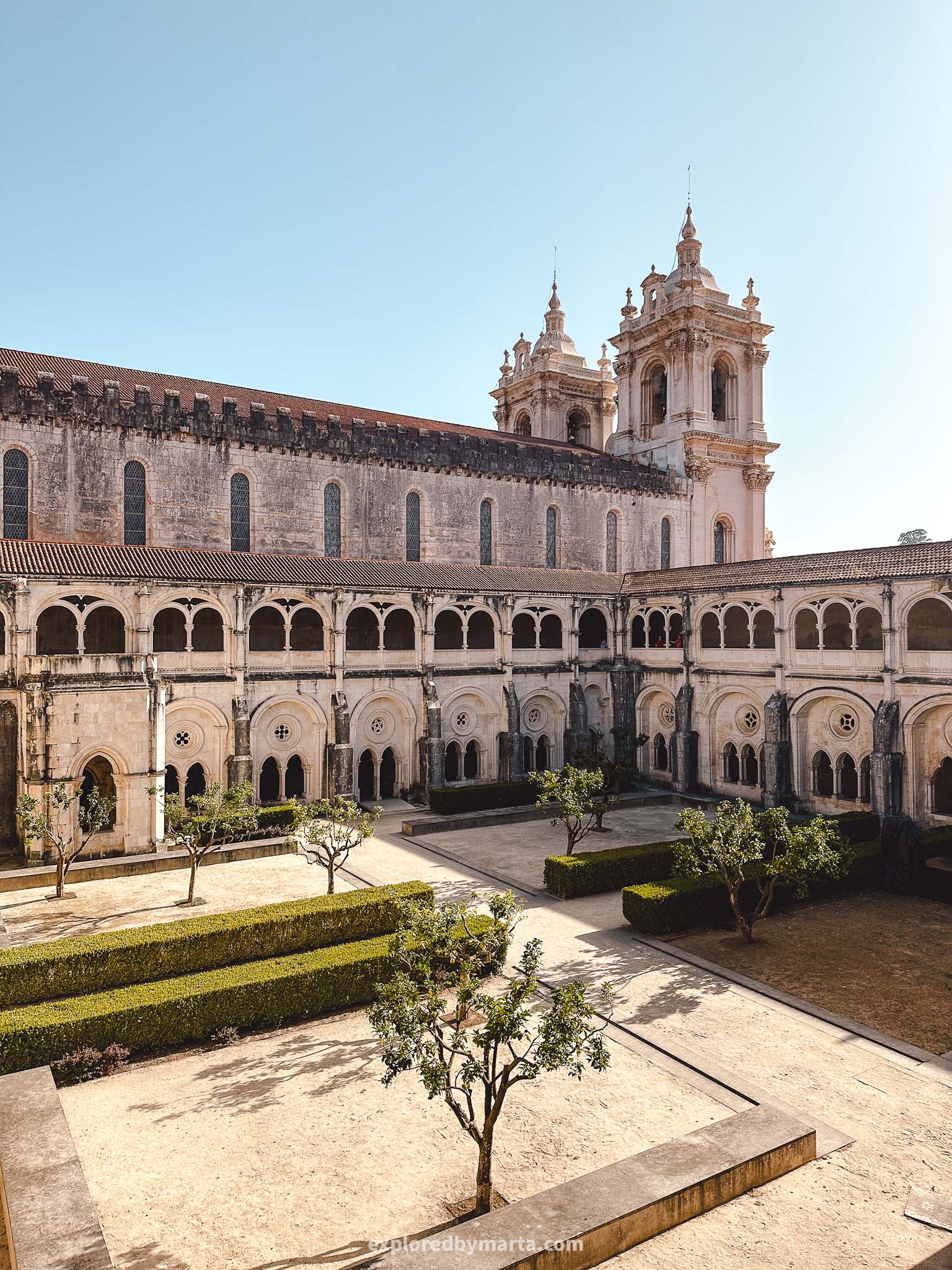
The town’s Mosteiro de Santa Maria de Alcobaça is a UNESCO World Heritage Site and one of Portugal’s most remarkable examples of early Gothic architecture.
Founded in the 12th century by the first Portuguese king, Afonso Henriques, the monastery was a gift to the Cistercian monks. At the time of its completion, it was the largest church in Portugal!
The most famous part of the monastery is the tombs of King Pedro I and Inês de Castro, whose tragic love story is often compared to that of Romeo and Juliet.

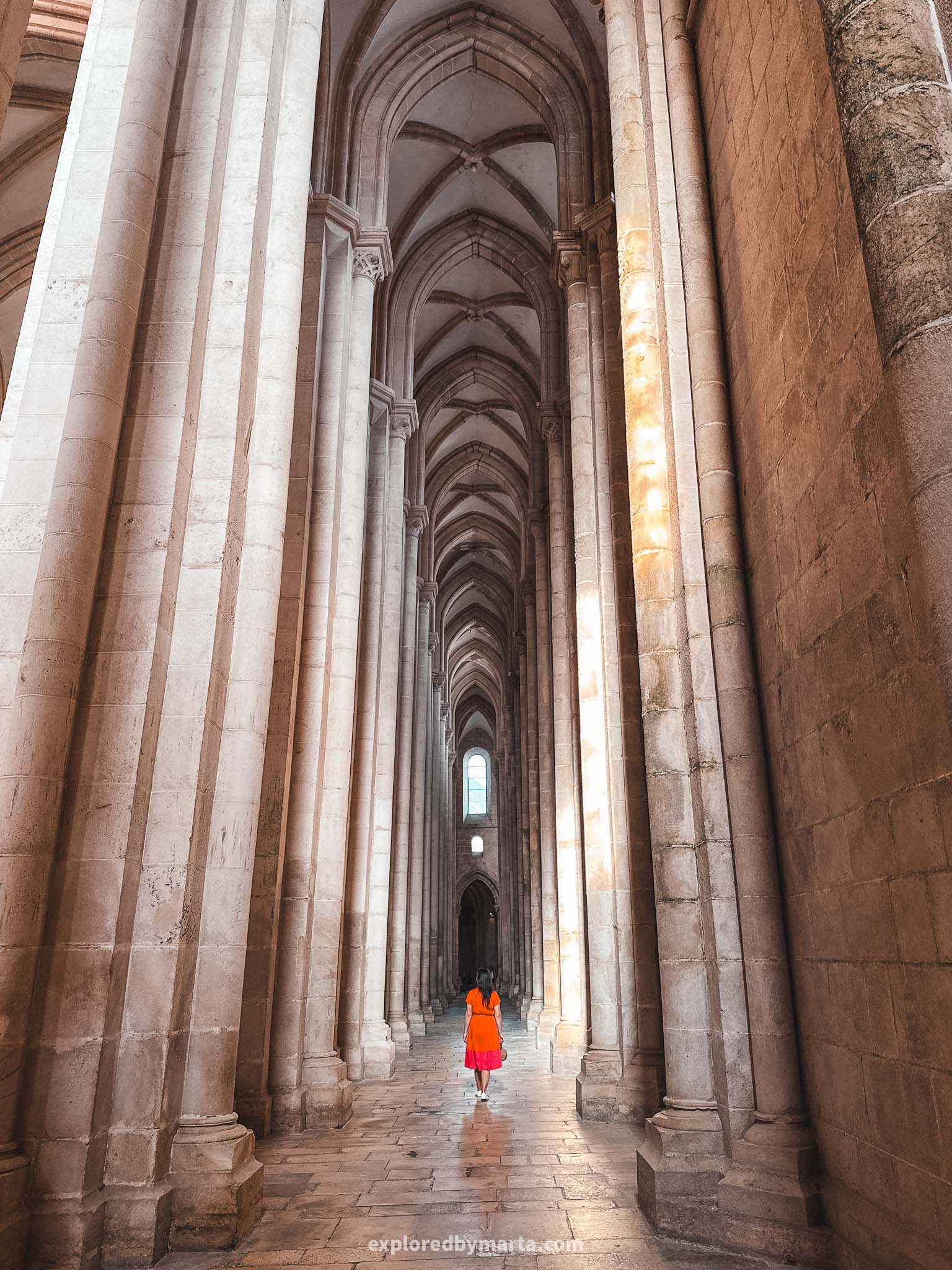
Alcobaça Monastery was once one of the richest and most influential monasteries in Portugal, with a population of nearly 1000 monks.
There’s so much to see there – cloisters, curch, rooms, halls, courtyards, tileworks, and architectural elements. It is massive! Especially those stone columns inside the church (see photo above).
Beyond the monastery, Alcobaça is a peaceful place to stroll around. However, we just came here for the majestic monastery. You can only see so much in one country, so we skipped the rest of the town and left it for another day.
Location: Alcobaça Monastery
11. Porto Cathedral
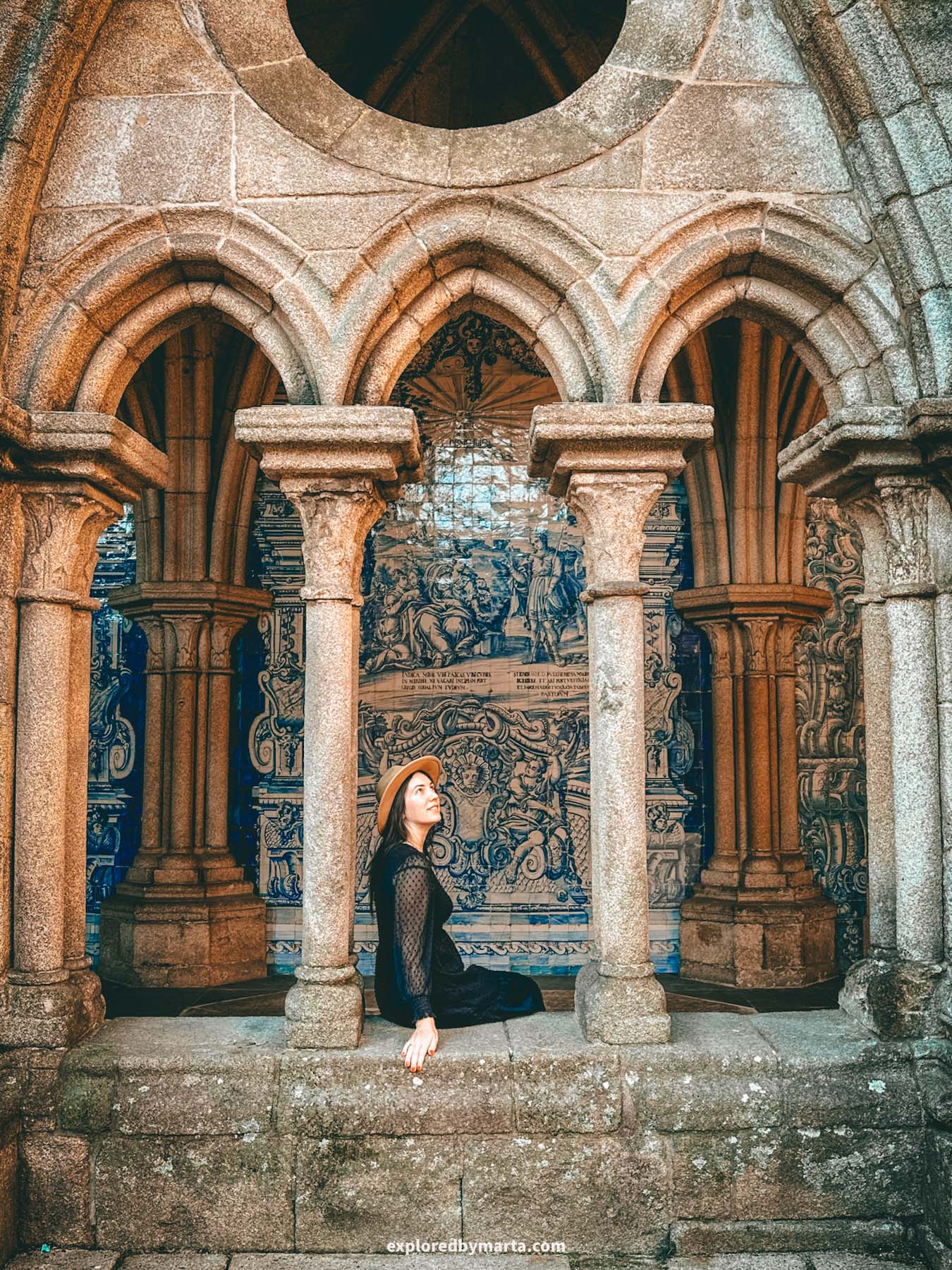
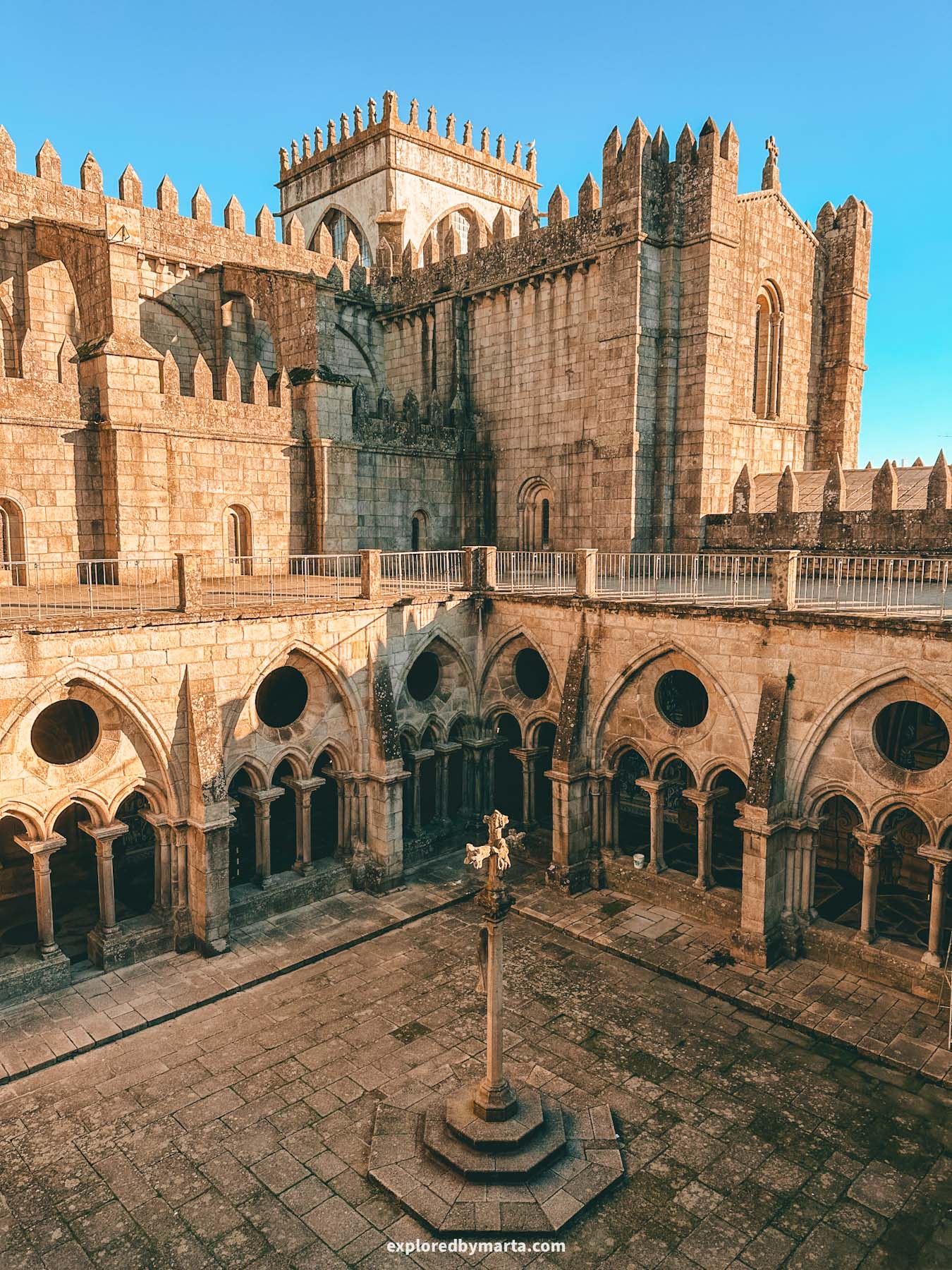
The Porto Cathedral, or Sé do Porto, is one of the city’s most important and iconic landmarks, standing tall and proud on the highest point of Porto’s old town.
It’s a must-visit place for anyone exploring the city, not only for its historical significance, but also for the amazing views of the rooftops of Ribeira and the Douro River.
Built in the 12th century, the cathedral is one of the oldest monuments in Porto and a beautiful mix of Romanesque, Gothic, and Baroque architecture.

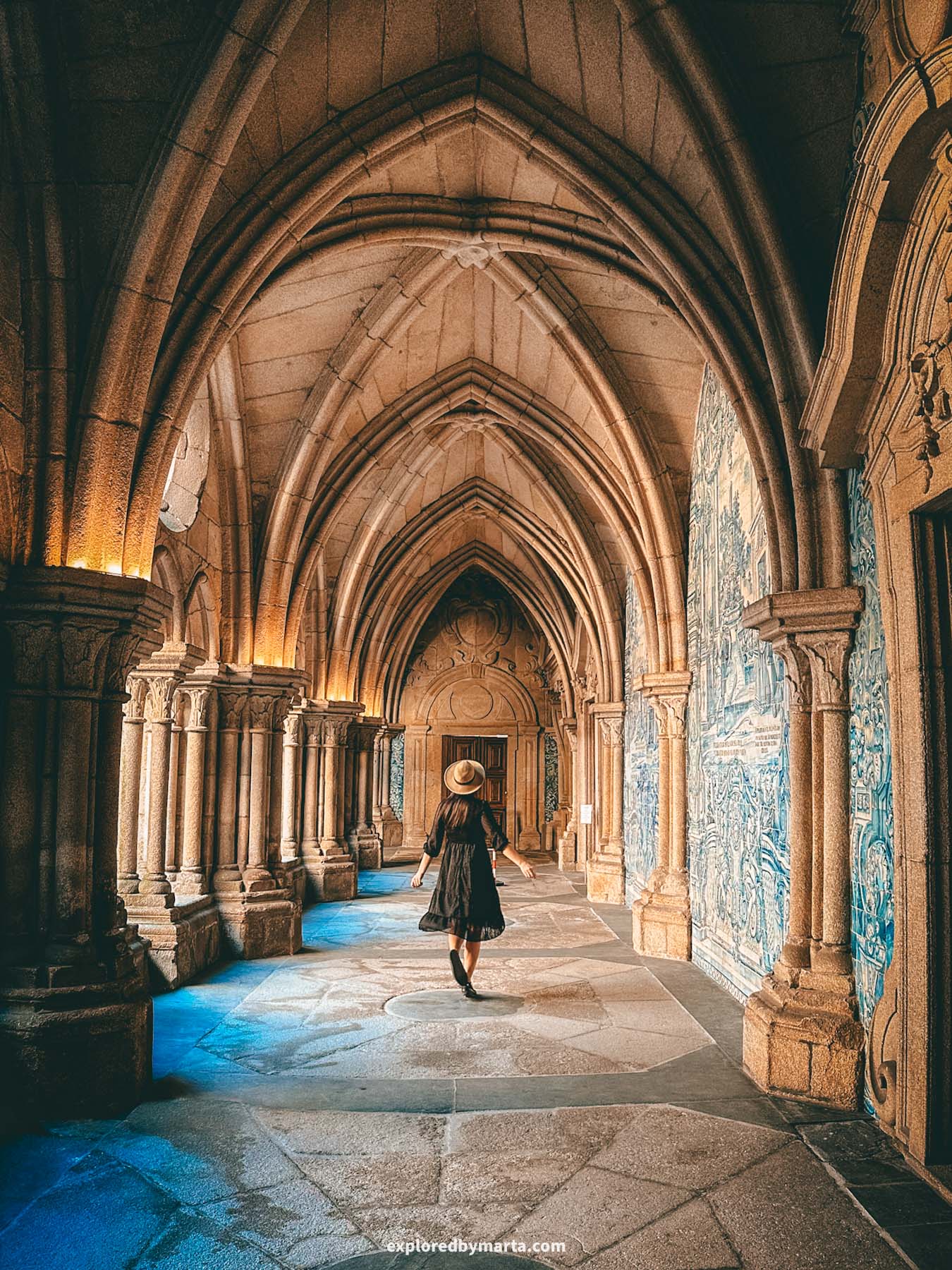
The cathedral actually looks fortress-like with its stone walls and towers, but inside you will find other architectural styles and elements.
I especially loved the courtyard with its stone arches and traditional azulejo tile panels. Such a photo-perfect place!
We made sure to arrive at the cathedral first thing in the morning, so we could enjoy and take some photos uninterrupted by the crowds. It does get crowded during the day!

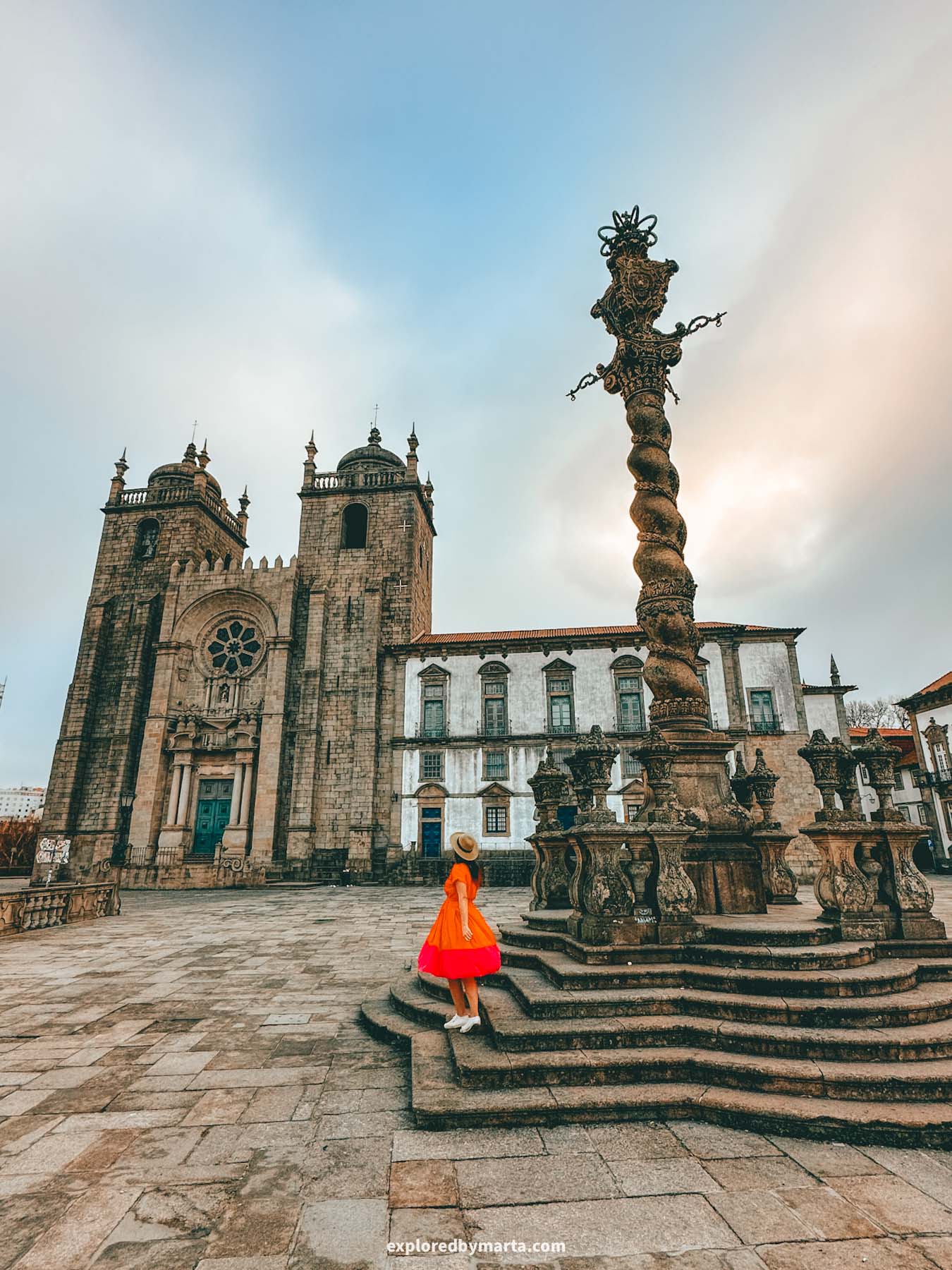
From the cathedral’s terrace, you’ll get one of the best panoramic views in Porto, stretching across the Dom Luís I Bridge and the colorful houses of Vila Nova de Gaia.
Even if you don’t go inside the cathedral, the views are right there at the square where the cathedral is located. That’s why it is a popular place for people to gather around sunset time – you’ll see the whole city in golden hues!
Whether you come for the architecture, the history, or simply the views, the Porto Cathedral is a place that truly captures the soul of the city. It’s a must-visit place for sure!
Location: Porto Cathedral
12. Santuário de Santa Luzia
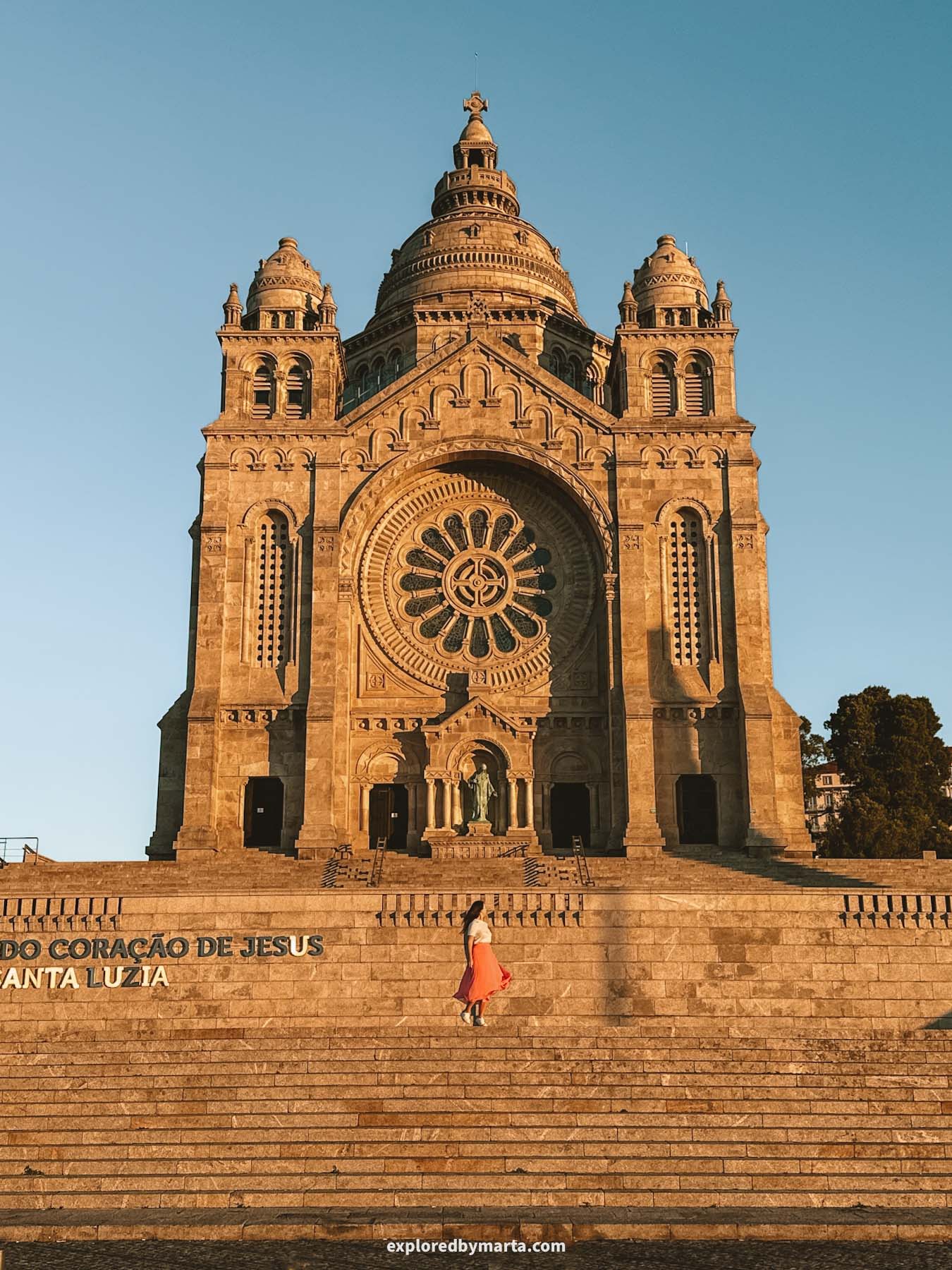
If you love charming coastal towns with a mix of sea views, history, and authentic Portuguese culture, you’ll definitely enjoy visiting Viana do Castelo and its stunning Sanctuary of the Sacred Heart of Jesus on Mount of Santa Luzia.
The town is located about an hour north of Porto, and it sits next to the Atlantic Ocean and the mouth of the Lima River. Viana do Castelo is famous for its beautiful setting, combining golden beaches with green hills, and a strong medieval heritage.


However, there is one special highlight in this town, and it is the stunning Santuário de Santa Luzia, a basilica perched on top of a hill overlooking the city.
You can reach the sanctuary by funicular or car, or you can climb up there by stairs like the pilgrims! The panoramic views from up there are absolutely worth it!
We actually came to the sanctuary multiple times during our travels around Northern Portugal. The best time to come here is in the morning – you’ll get to watch sunrise in all its glory from the mountaintop!
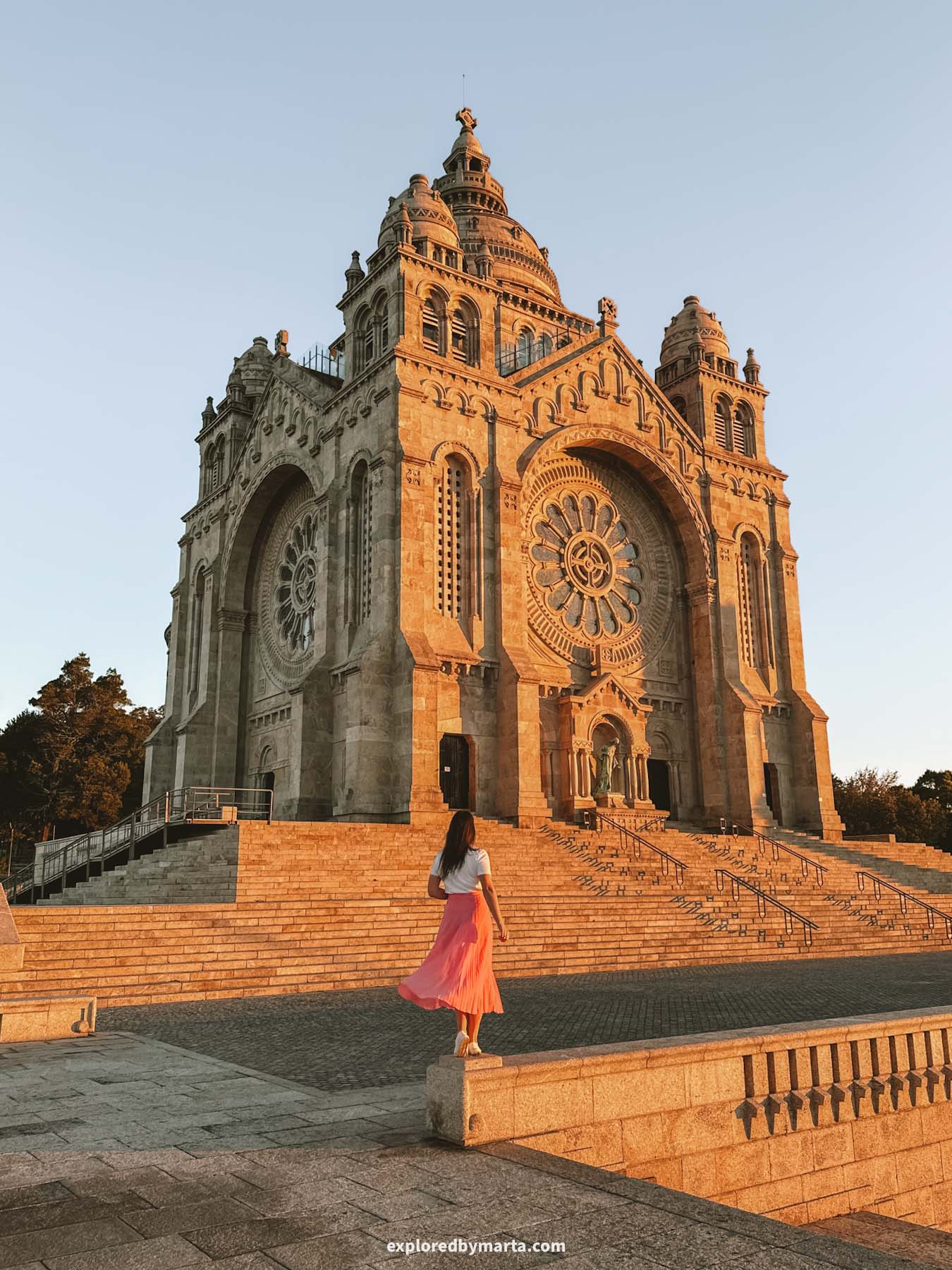

Watching the sunrise from the Mount of Santa Luzia was one of my favorite memories from our travels in Portugal! We also came back here another day to check out the interior of the beautiful sanctuary – it is truly…heavenly!? Just look at those blue frescoes!
The town itself is filled with charming streets, traditional tiled houses, and lively squares. Viana do Castelo is also known for its rich folk traditions and colorful festivals, especially the Romaria de Nossa Senhora d’Agonia, one of the most famous celebrations in Portugal.
Location: Santuário do Sagrado Coração de Jesus
13. The most colorful church – Igreja Matriz de Válega
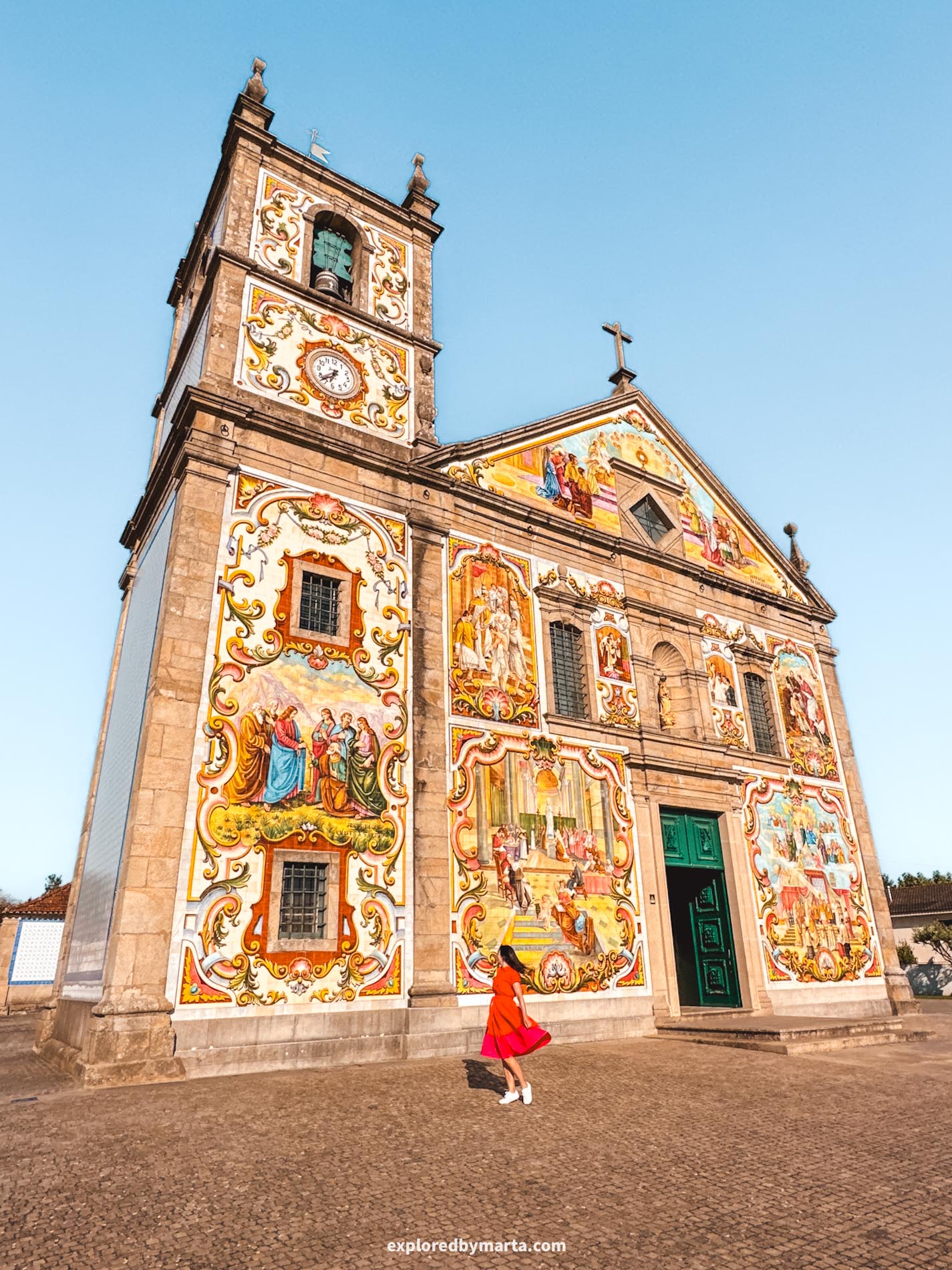
Honestly, Igreja Matriz de Válega is not only the most colorful of all the churches in Portugal, but it is the most colorful church I have seen in the world. And I’ve seen a considerable number of churches during my travels, haha!
This is definitely one of the most beautiful churches in Portugal, and a favorite of mine, for sure. Both the exterior and interior of this church are covered with colorful tiles depicting different biblical illustrations.
The best part? You can visit this absolute marvel for free!
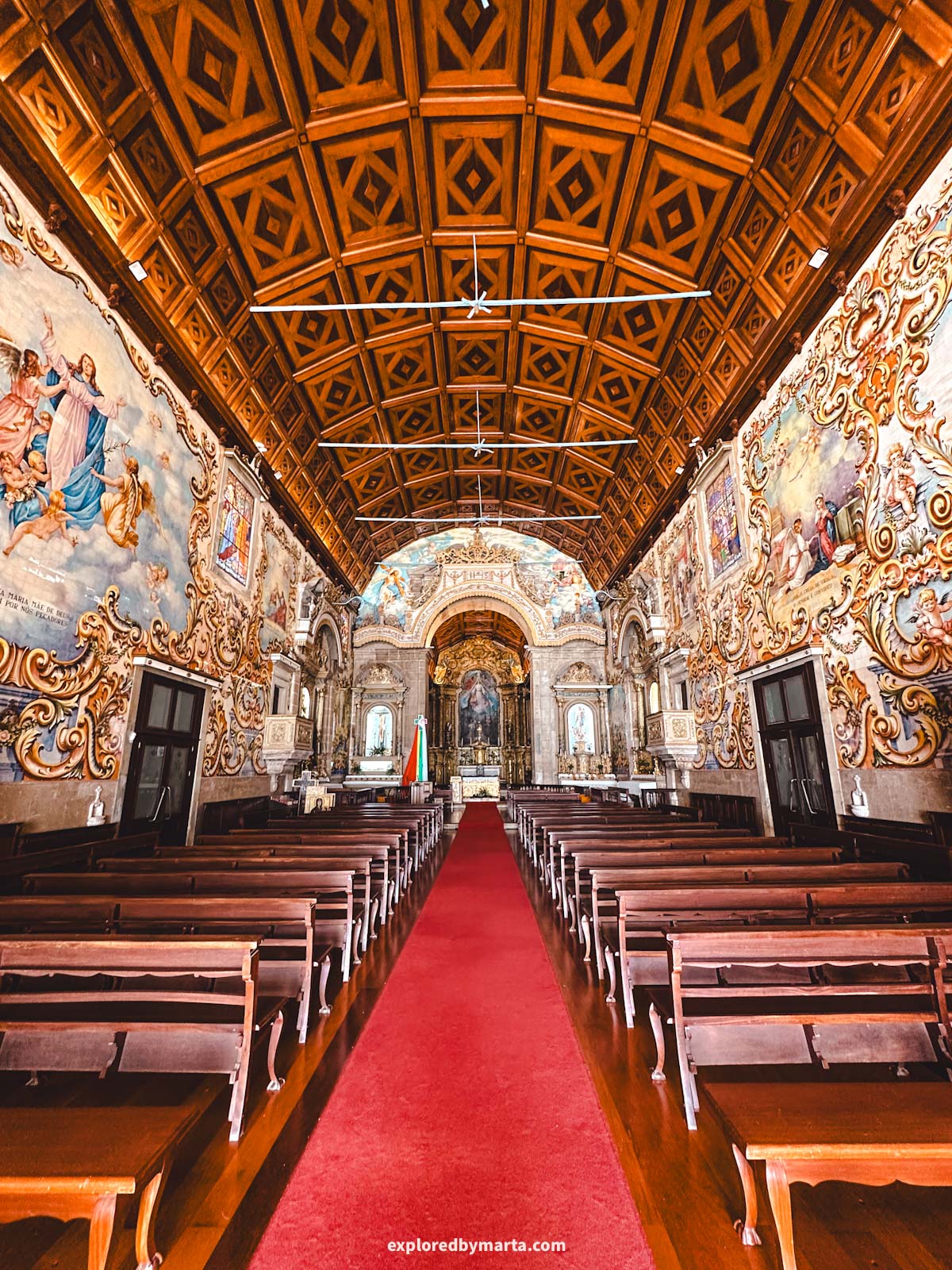
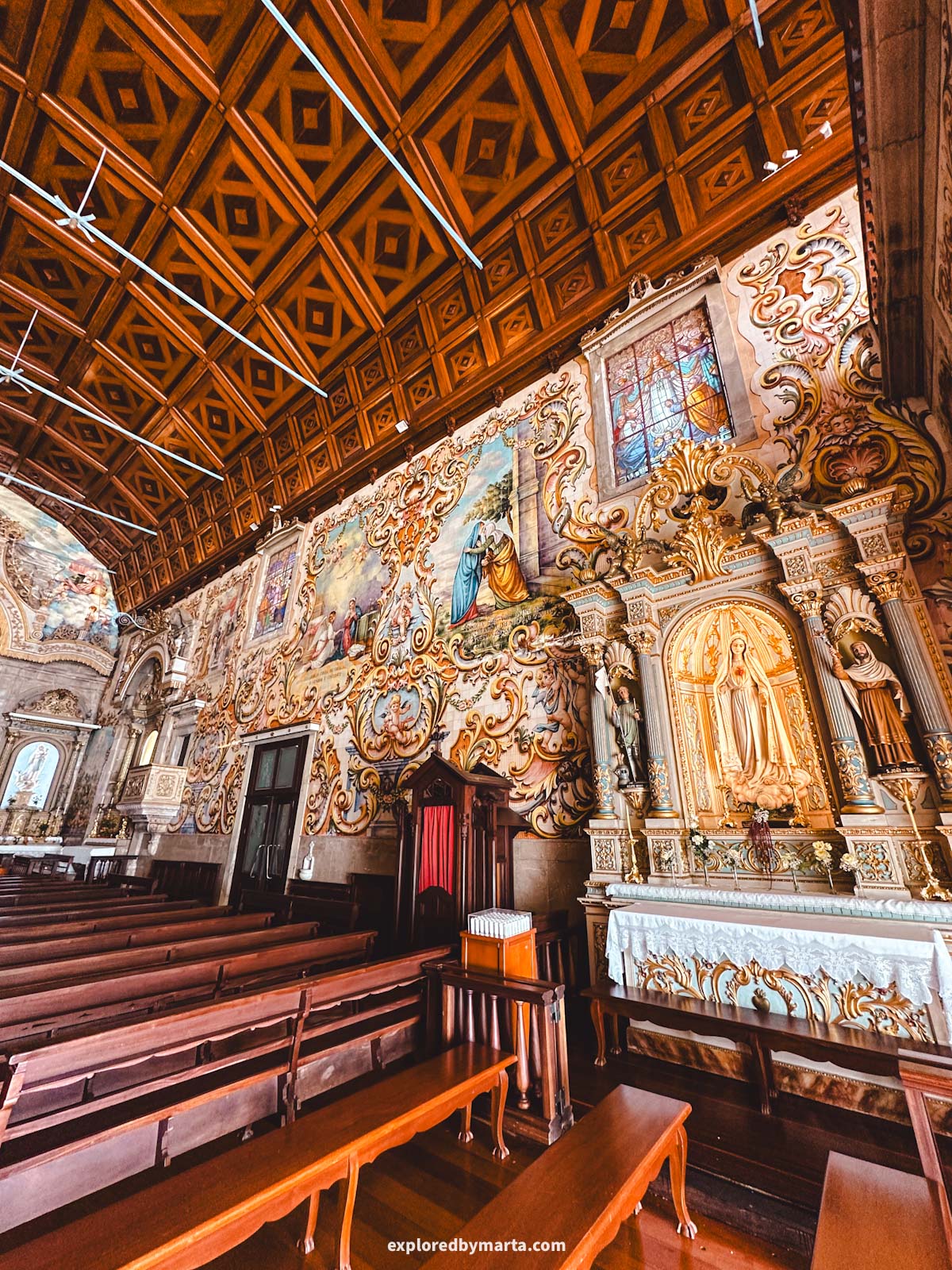
The church is located in Válega, a small town in the Aveiro district, not really known to the regular traveler, and is only a 40-minute drive South from Porto.
While this church dates back a thousand years, the construction of Igreja Matriz de Válega, as we see it today, started in the middle of the 18th century and lasted for a hundred years.
However, the colorful tiles were added back in the middle of the 20th century. They cover the whole church, but the colorful part is only on the front facade and inside.
The church is freely accessible, and you can even visit the interior during its working hours. But even seeing it from the outside is a magical experience!
Location: Igreja Matriz de Válega
14. The blue church of Igreja Paroquial de Cortegaça
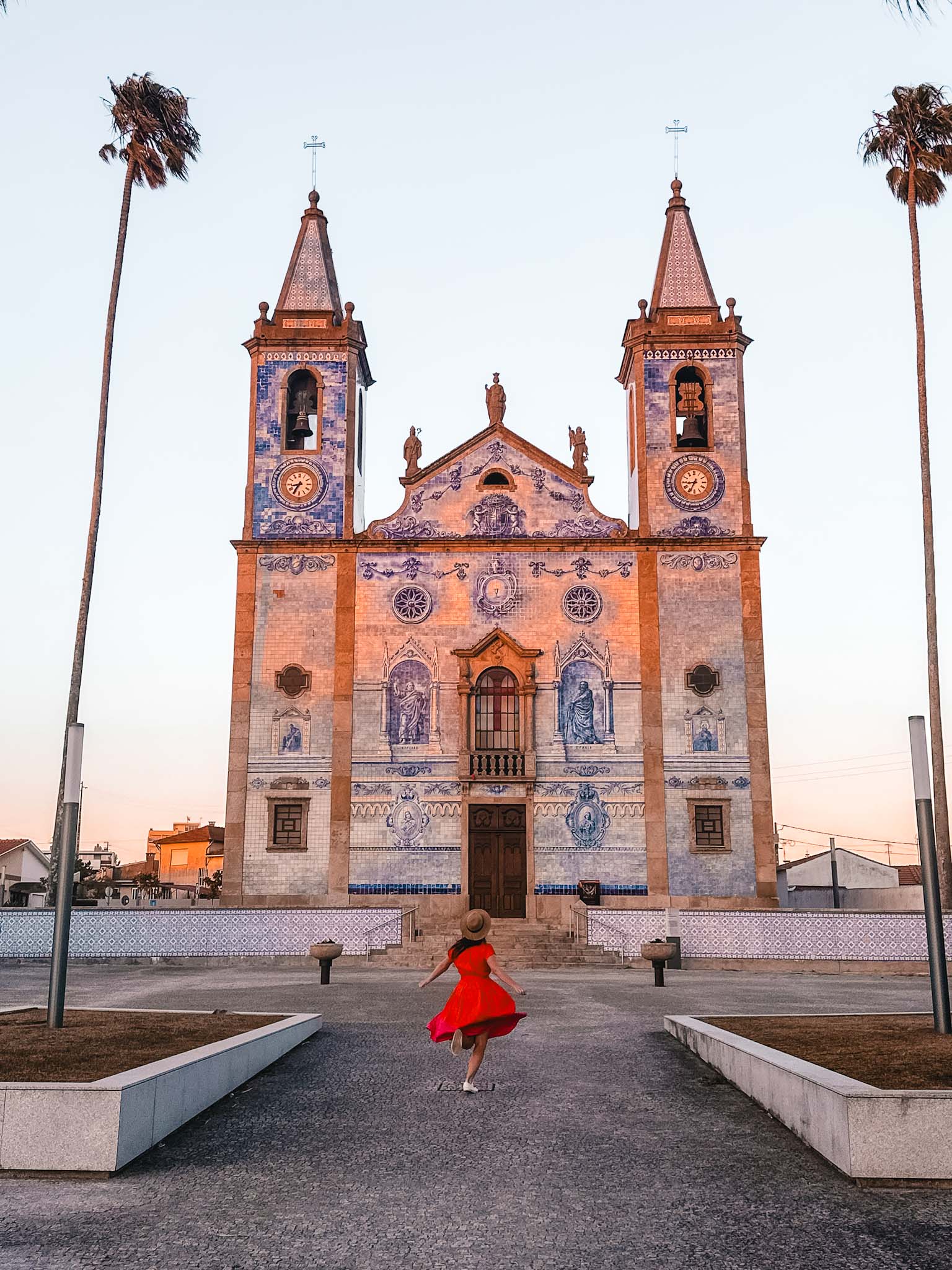
Located in the Cortegaça village in the Aveiro district is this wonderful sight you will remember forever – the stunning Igreja Paroquial de Cortegaça church, or the blue tile church!
The building that we see today was completed in 1918 and was built to replace the old temple, dating back to the middle of the 12th century.
But, really, if you build new places on top of old buildings, they should look just as impressive and unique as this church turned out, am I right?


This striking church is located in a square at the end of an alley of palm trees. The incredible facade was covered with tiles between 1921 and 1923 and depicts religious figures.
The church also has two flanking towers topped with spires. I love the creativity that went into this church! I could only silently admire everything I saw here – it was magical!
This church is definitely one of the most exquisite examples of Portuguese tile artworks and one of the most beautiful churches in Portugal. I highly recommend checking it out!
Location: Igreja Paroquial de Cortegaça
15. Lisbon Cathedral, the capital’s oldest church

One of the most famous sights in the capital is the Lisbon Cathedral, the oldest church in Lisbon.
It was built in 1147 and so far has survived multiple earthquakes and has been rebuilt and redesigned multiple times over the centuries.
This means that the Lisbon Cathedral features many different architectural styles – including Gothic, Baroque, Neoclassical, and Rococo styles.
You can observe the whole nave from the back for free, but there is an entrance fee to see the rest of the building.
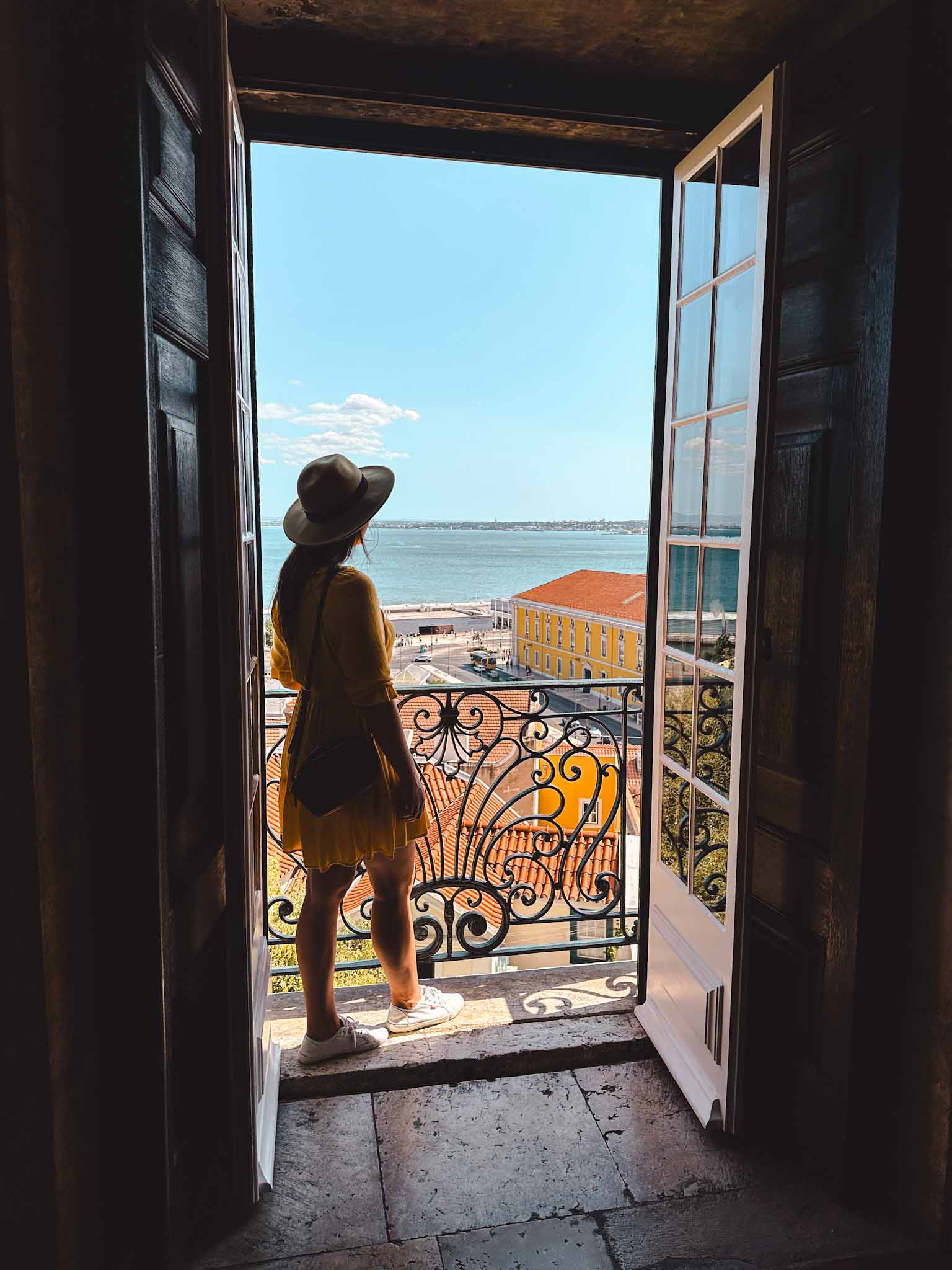

Tickets cost a couple of euros per person when we visited. There are two floors to explore. The ground floor features the main nave with multiple chambers where you can walk around and see everything.
The upper floor features rooms with exhibitions of artifacts and balconies where you can see Lisbon from above. My favorite place in the cathedral was the front facade balcony, where you can walk on and see the square below – I felt like the Pope, haha!
Location: Lisbon Cathedral – Lisbon Cathedral Entry Ticket
16. The roofless Carmo Convent

There is one event in Lisbon’s history that shaped Lisbon as we see it today, and that is the 1755 Lisbon earthquake.
The earthquake and the following tsunami, as well as the firestorm, destroyed about 85% of all buildings in Lisbon and changed the city forever.
Only a couple of places in Lisbon remind us of the past horrific events, and the Carmo Convent in Lisbon is one of them.
It is a 14th-century convent that suffered damage in the earthquake – the roof collapsed and part of the building complex was destroyed.
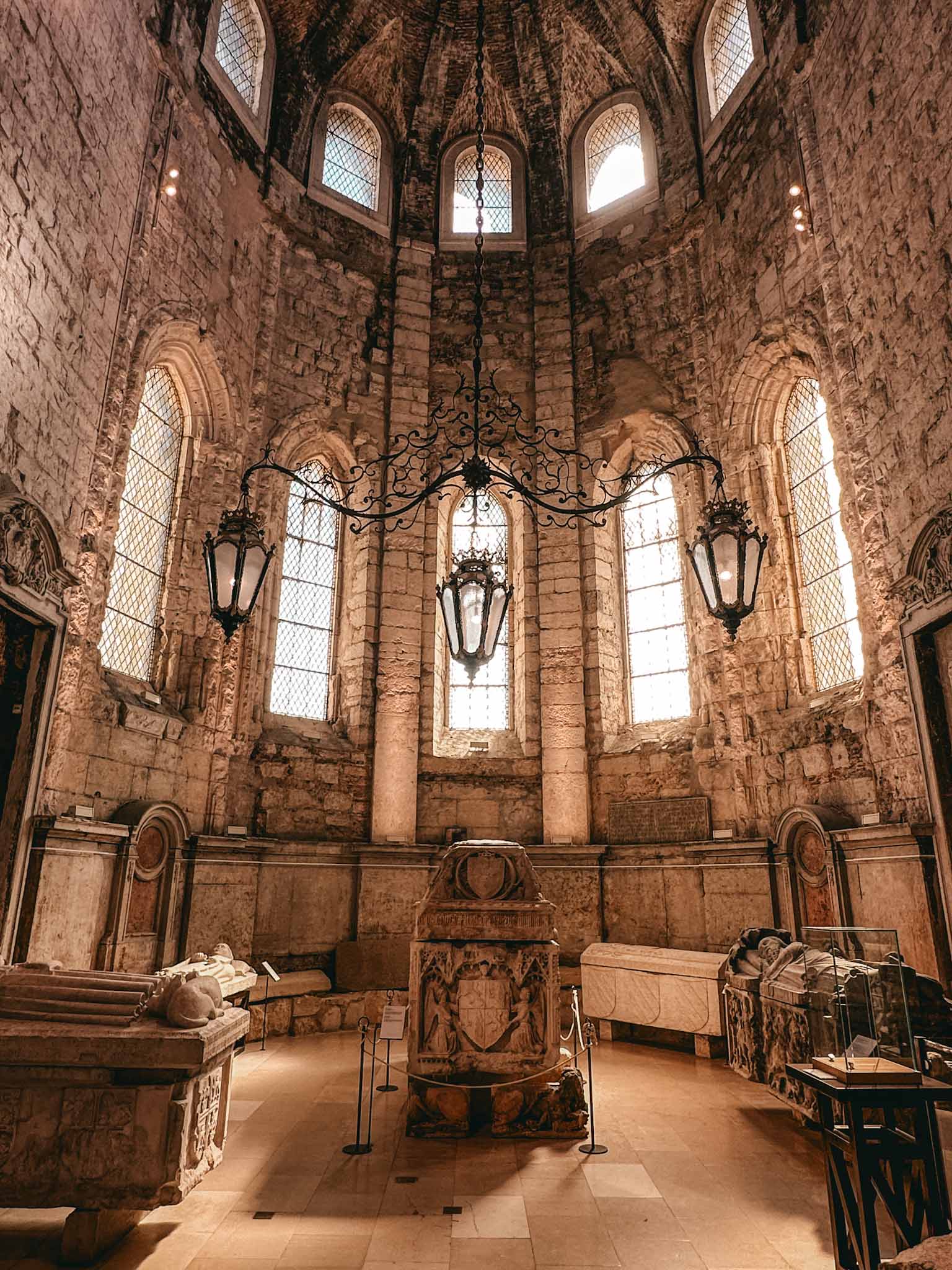
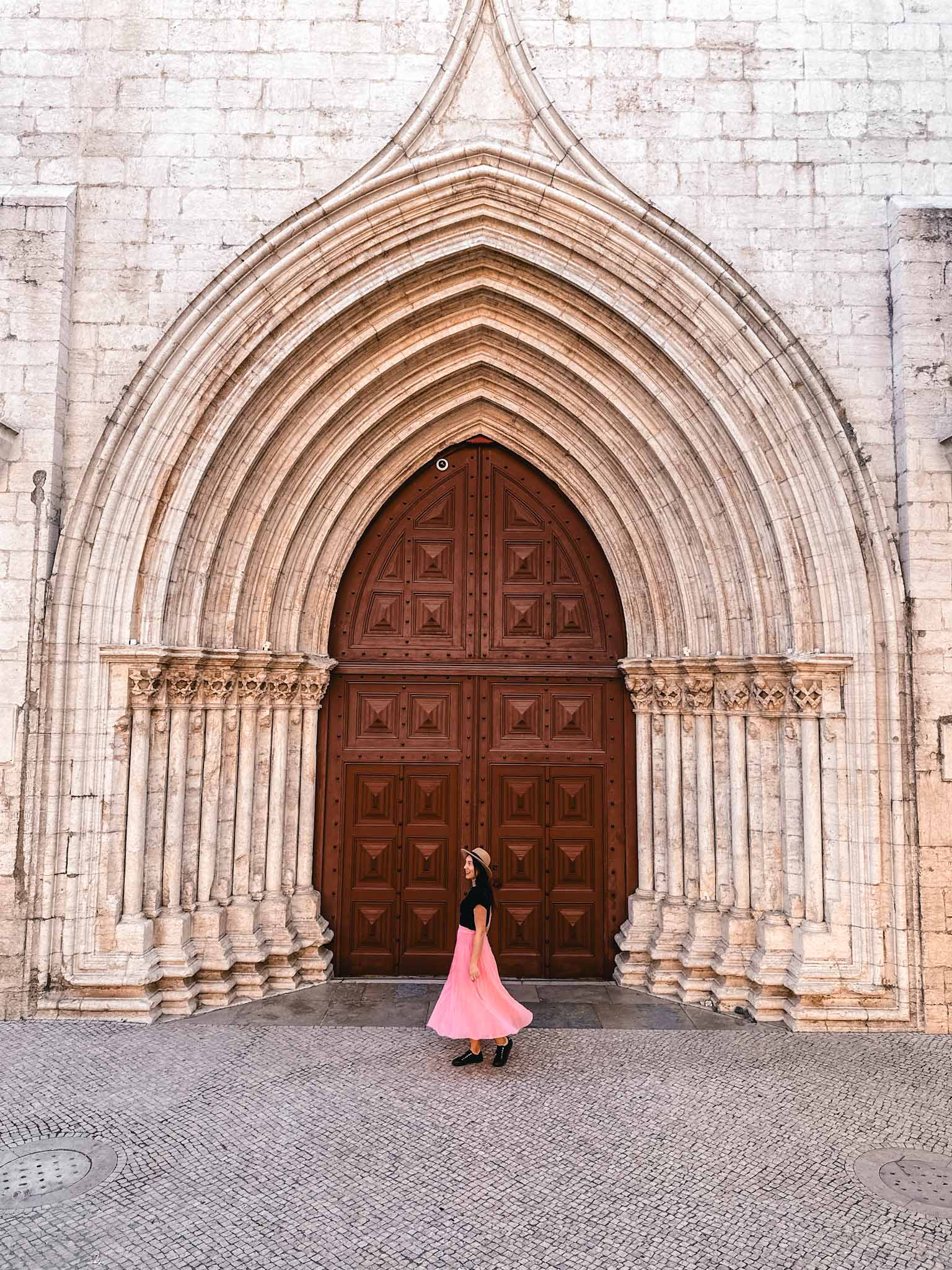
Today, you can visit the ruins and see what is left of the Gothic church – it is completely roofless with high arches crossing the sky.
The visit also includes a museum behind the church with artifacts and two mummies.
This place is not large, so it won’t be a long visit. I think we managed to explore everything in 30 to 45 minutes. It was absolutely unique and beautiful, but also quite sad because of its tragic past.
Location: Carmo Convent
17. Sanctuary of Our Lady of Sameiro
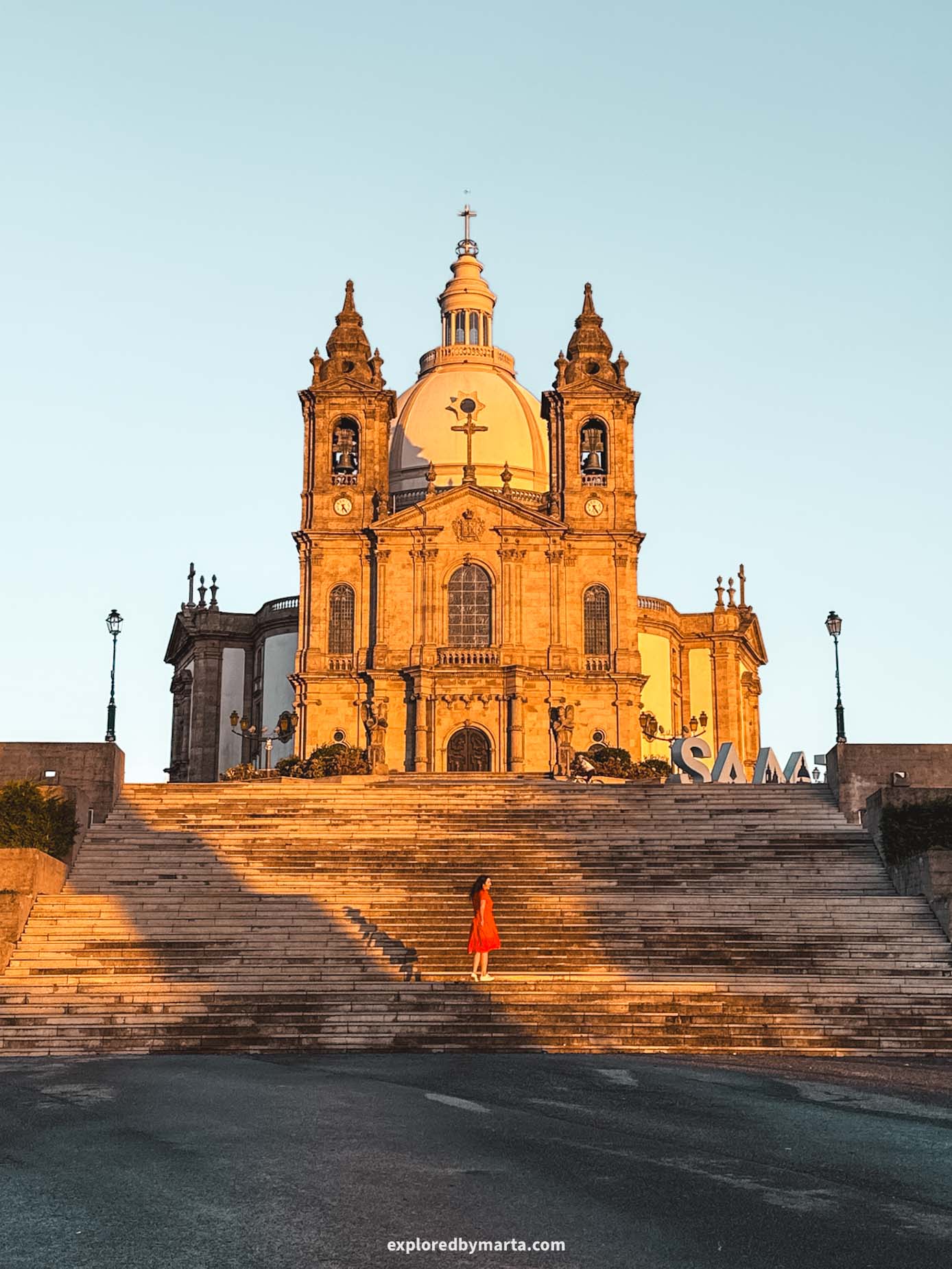

Bom Jesus do Monte is not the only sanctuary on a hilltop near Braga.
Less than 2 kilometers from Bom Jesus do Monte on a neighboring hill, 350 meters above Braga, you will find the Sanctuary of Our Lady of Sameiro.
I have to say, it is one of the most beautiful and peaceful places we visited in Braga. But maybe I felt like that because we visited this sanctuary at sunset, and there were very few people there, haha!

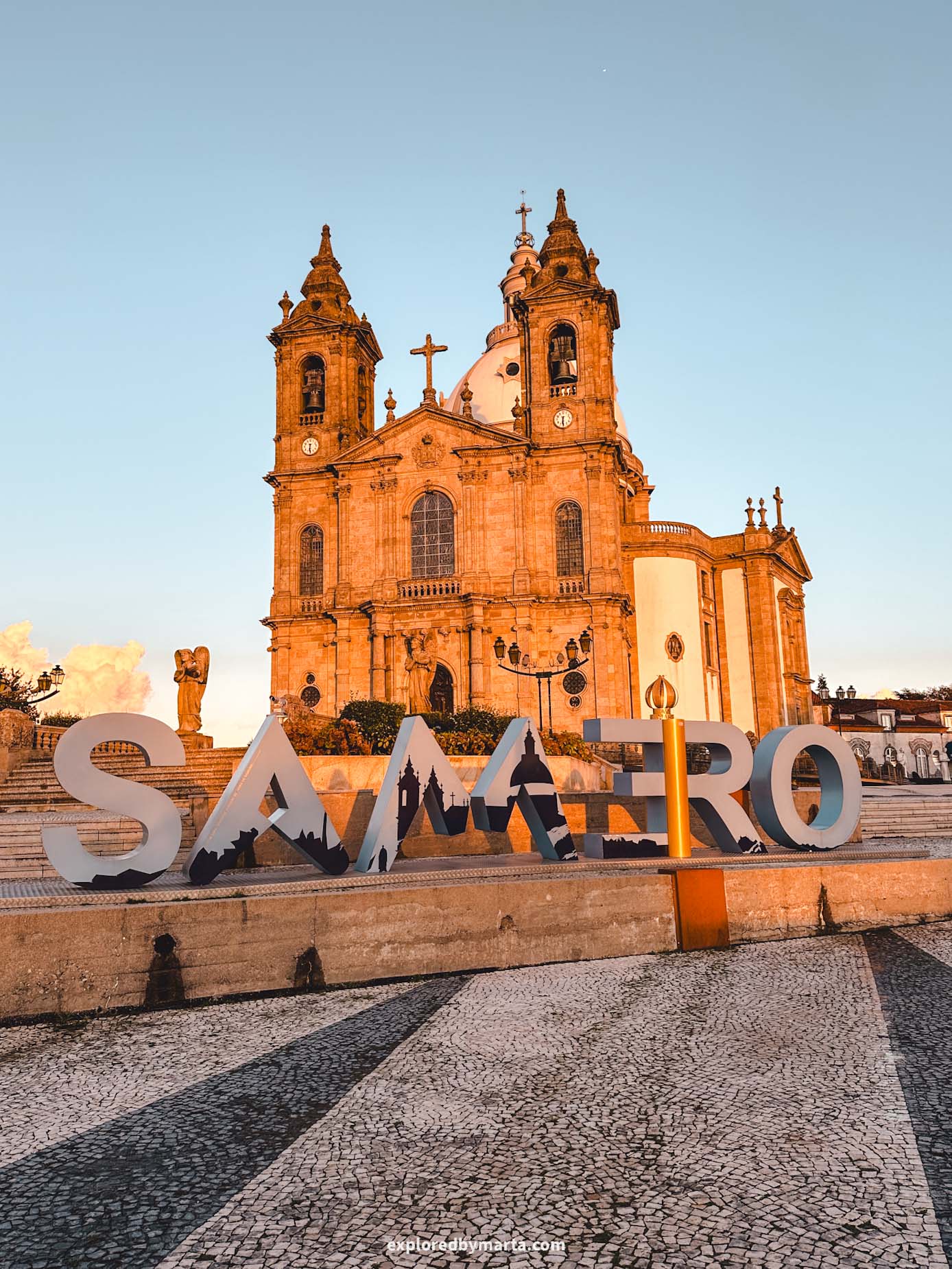
The Sanctuary of Nossa Senhora do Sameiro sits much higher than Bom Jesus do Monte, so the views are absolutely incredible. Especially at sunset!
The golden light reflecting on the white domes of the sanctuary, the peaceful atmosphere, the majestic views – I just look at the pictures and I get transported back there immediately in my thoughts. Something I can’t forget for sure!
The sanctuary itself dates back to the 19th century and is the second most important Marian shrine in Portugal after the famous Sanctuary of Fátima.

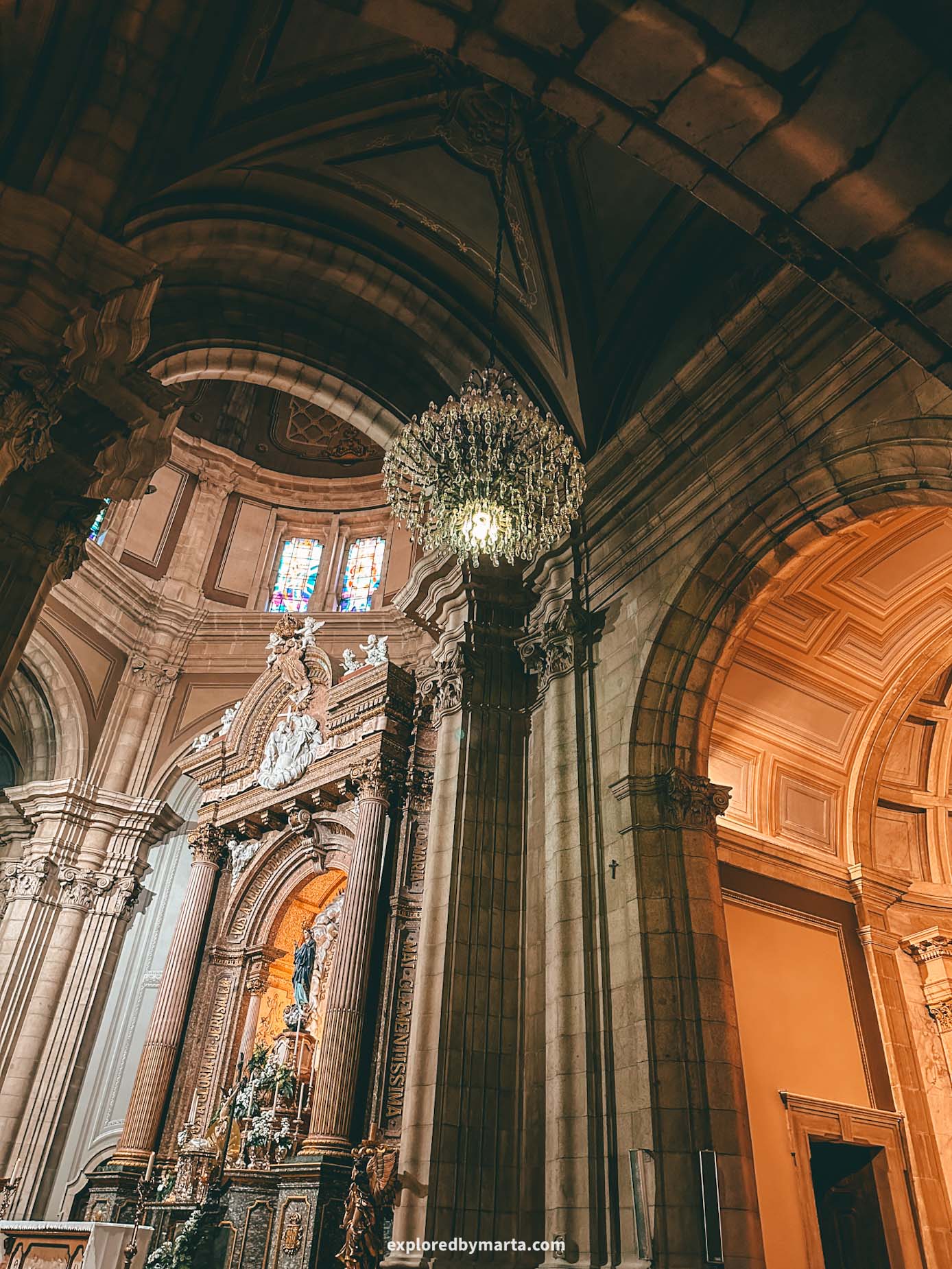
Sanctuary of Our Lady of Sameiro features beautiful neoclassical architecture with an impressive dome and a detailed interior, but the large open square and the views are what really make this place special.
I can tell you – you can see that dome from miles away when you drive closer to Braga!
If you have a rental car like we did, it’s an easy drive from Braga, and you can combine the visit with Bom Jesus do Monte since they’re located quite close to each other.
But if you can, I recommend coming here around sunset like we did. It is just something so special and so much different than during the day (yes, we also came here another time during the day, because we stayed in Braga for over a week!).
Now, a quick hidden gem for you!
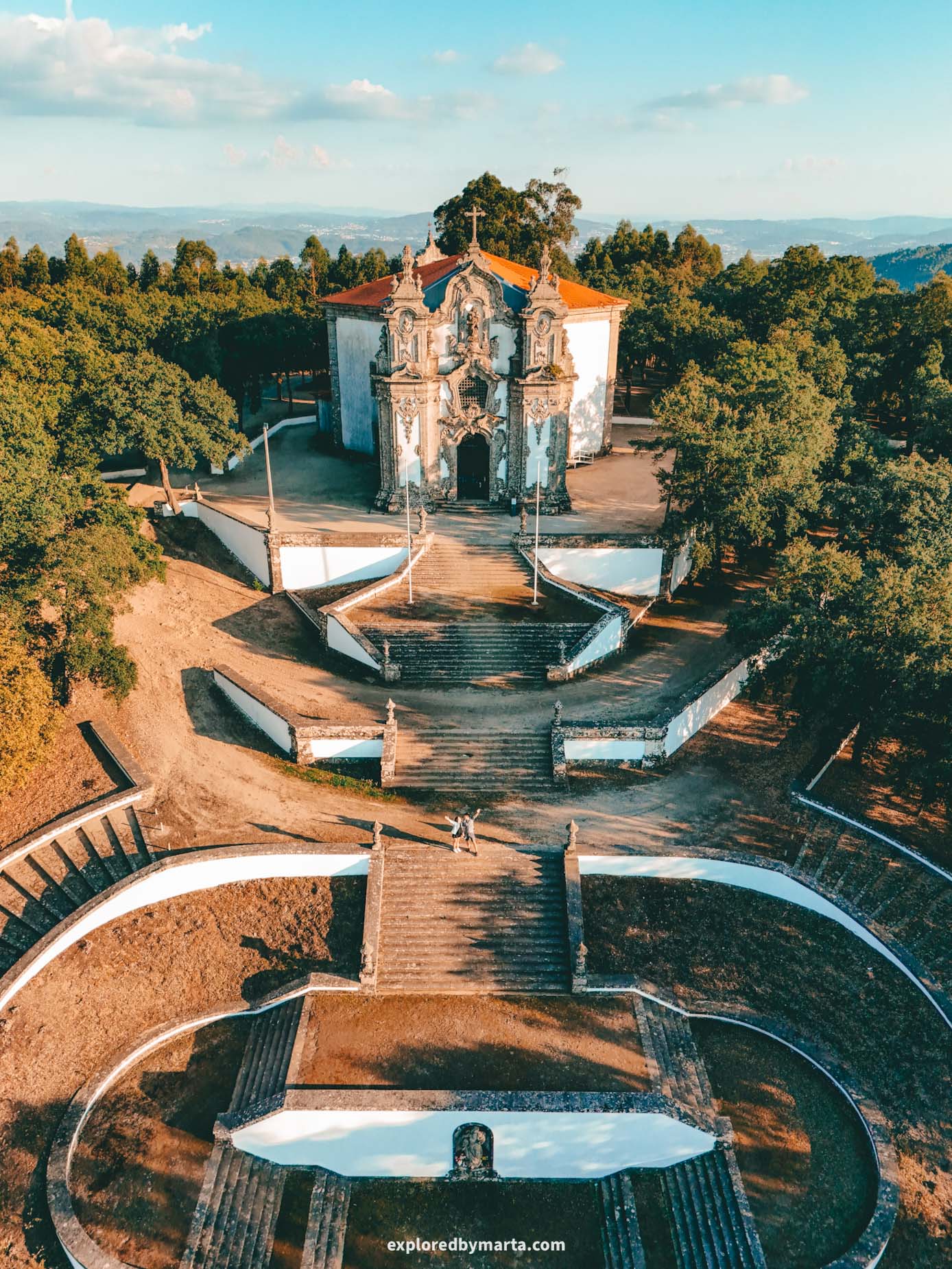
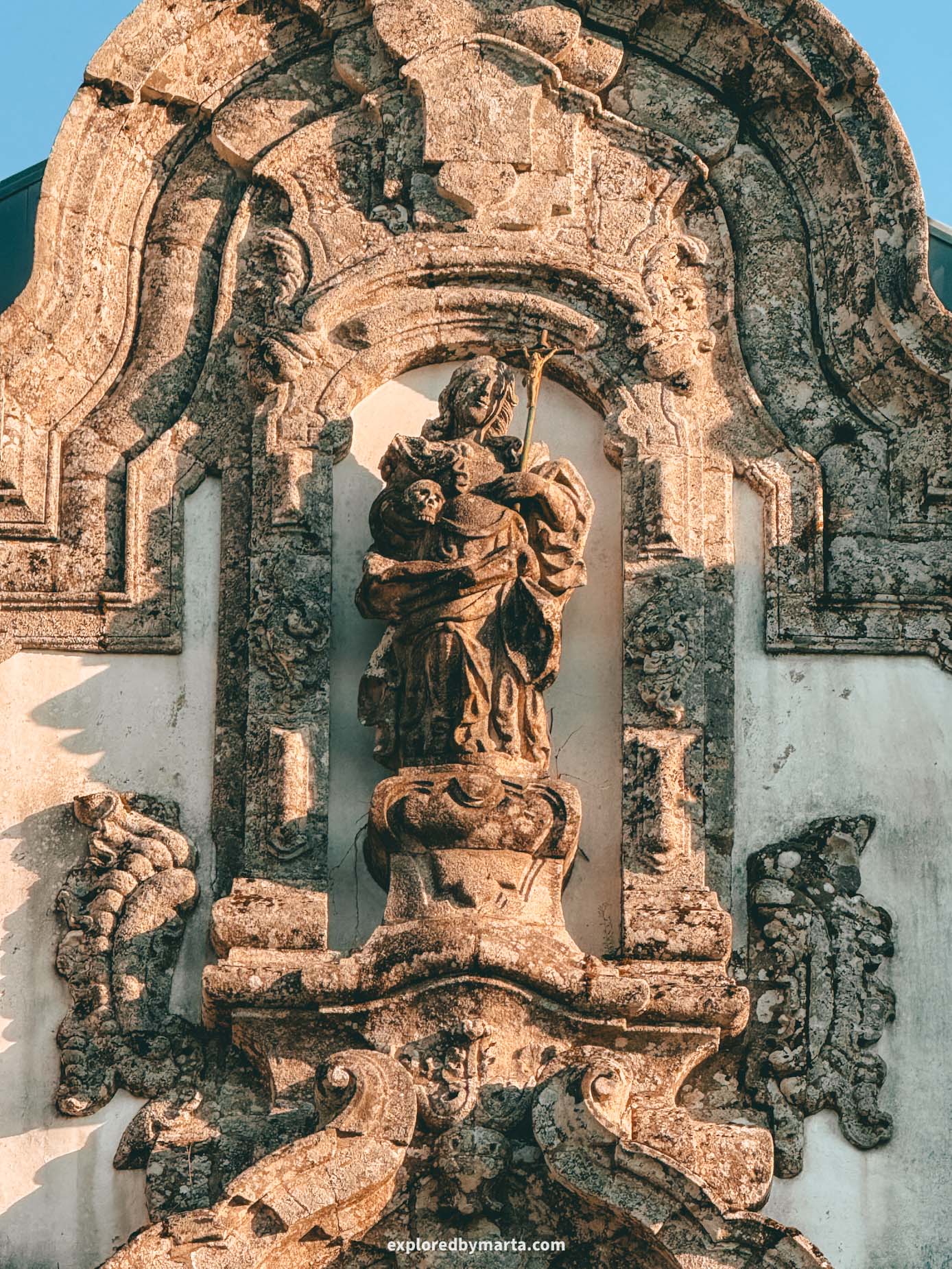
I already mentioned chasing iconic churches in iconic locations, so I might as well add one more to this list.
If you really have a rental car, you might want to stop by another scenic location on a hill – Santuário de Santa Maria Madalena de Falperra.
It is another incredibly beautiful sanctuary just outside Braga, and it was designed by, you guessed it, the famous André Soares, one of Braga’s most important Baroque architects.
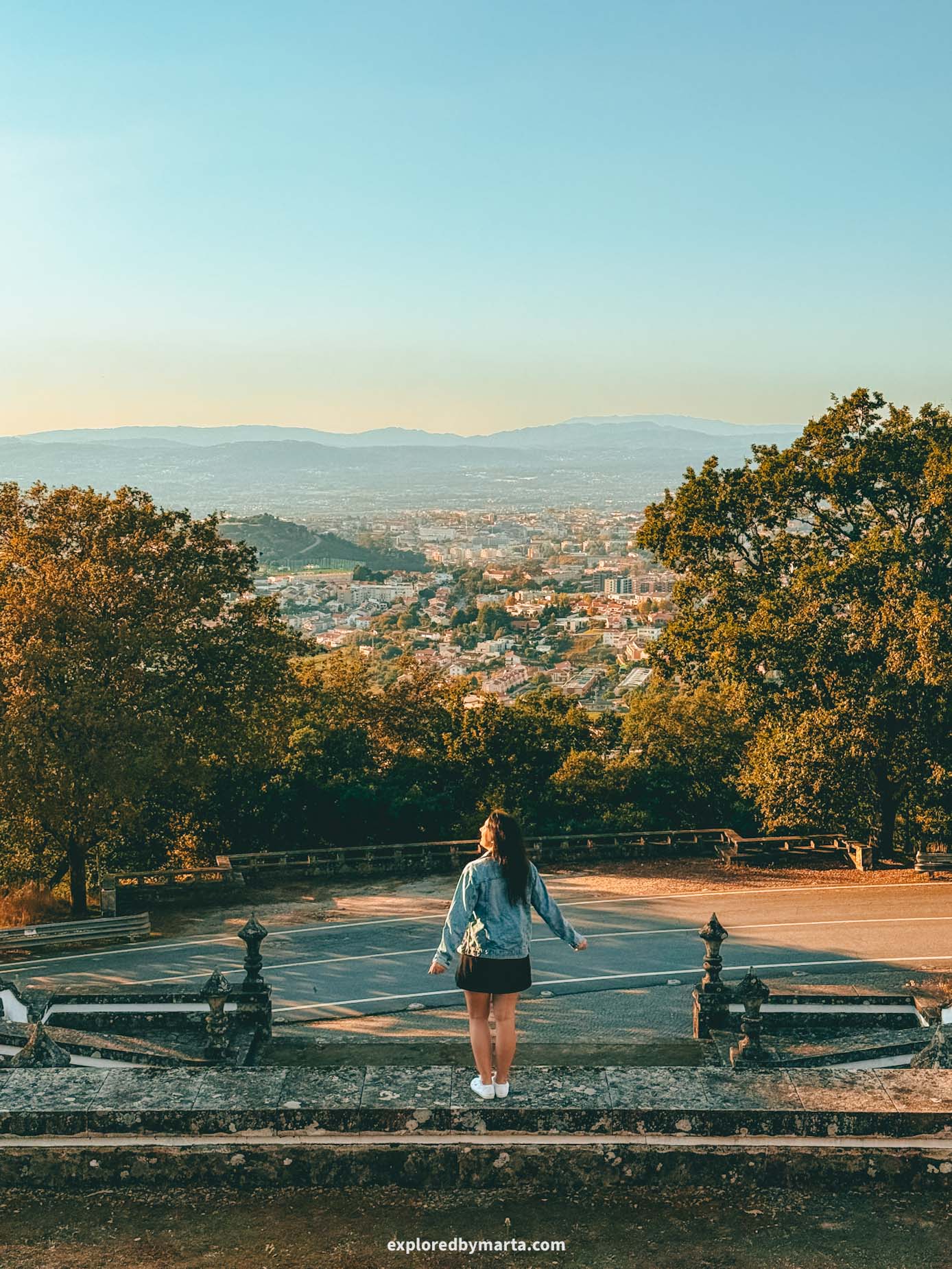
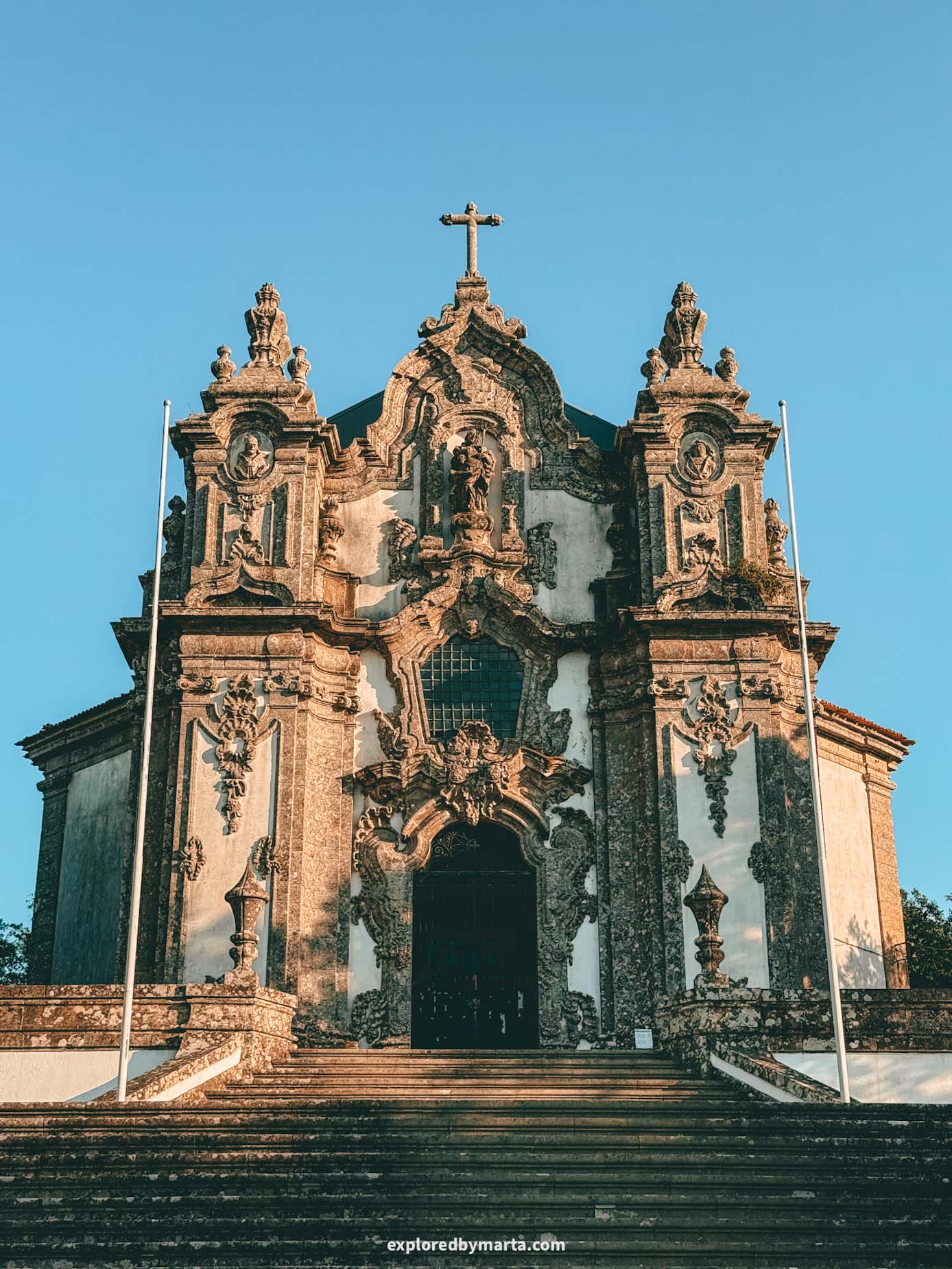
This 18th-century Baroque church is surrounded by the lush green hills of Falperra, and might not be as famous as Bom Jesus do Monte or Sameiro, but it’s absolutely worth a visit for its stunning architecture and peaceful setting.
The ornate stone facade is the most beautiful of all the churches we’ve seen in Braga! It features intricate carvings and statues, and it is actually known as one of the best examples of Baroque architecture in northern Portugal.
We didn’t get to visit the inside, but the views from the hill were more than enough to call this visit a complete success. Plus, there was nobody around besides us, so if you love hidden gems, this is a great spot to include in your Braga itinerary!
Location: Sanctuary of Our Lady of Sameiro – Santuário de Santa Maria Madalen
18. The oceanfront Capela do Senhor da Pedra

The oceanfront Capela do Senhor da Pedra, one of the most picturesque chapels in Portugal, is a bit of a hidden gem, but it’s also not. Locals know about it very well, but not many tourist guides mention this unique place.
So why is it unique? The tiny 17th-century chapel is built on a rock outcrop in the most photogenic setting – right on the edge of the ocean in Miramar, a short ride south from Porto (you can reach it by train).
When the wind is bigger and the tide is high, the chapel is surrounded by dramatic waves that come crashing down against the rocks. It looks pretty epic! This place is both peaceful and wild!
But on a nicer day, this is a wonderful place to spend time at the beach. There’s a nice promenade nearby with cafés and small restaurants.
However, I’d also consider coming here in the morning for sunrise hues or in the evening to watch the sun go down into the ocean with waves painted in golden sunset views.
Either way, I hope you get to visit this very special little chapel by the ocean!
Location: Capela do Senhor da Pedra
19. Chapel of Bones in Évora
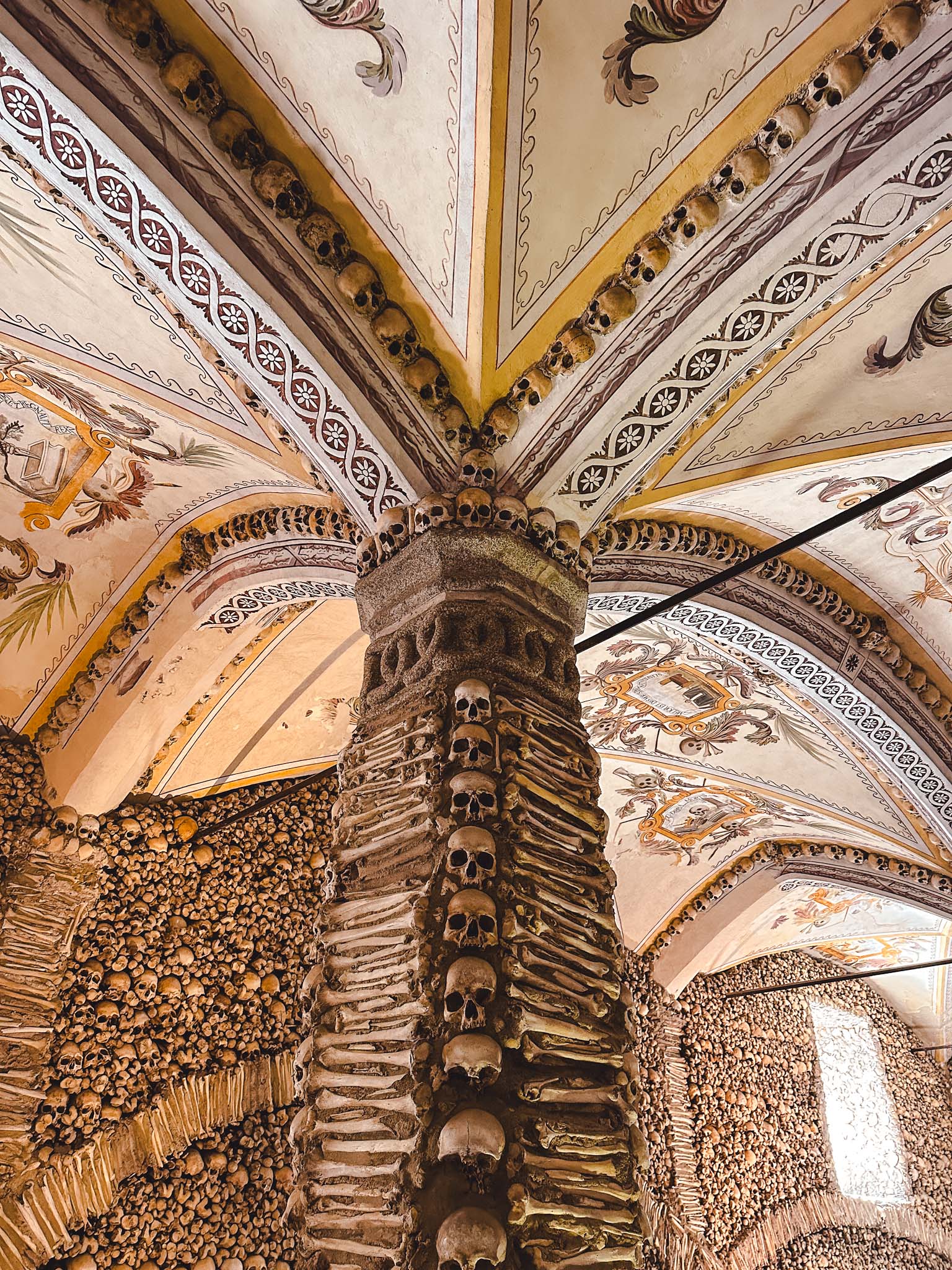
Chapel of Bones is one of the most unique hidden gems in Portugal, and one of the main attractions in Évora. I was really keen to see the famous Capela dos Ossos chapel with its inner walls, pillars, and ceiling arches lined with human bones and skulls.
It did not disappoint!
The Chapel of Bones is part of the Museum of Évora. The ticket costs a few euros and includes visits to the Évora Museum with its vast collection of religious objects, the Chapel of Bones, as well as the church of São Francisco.
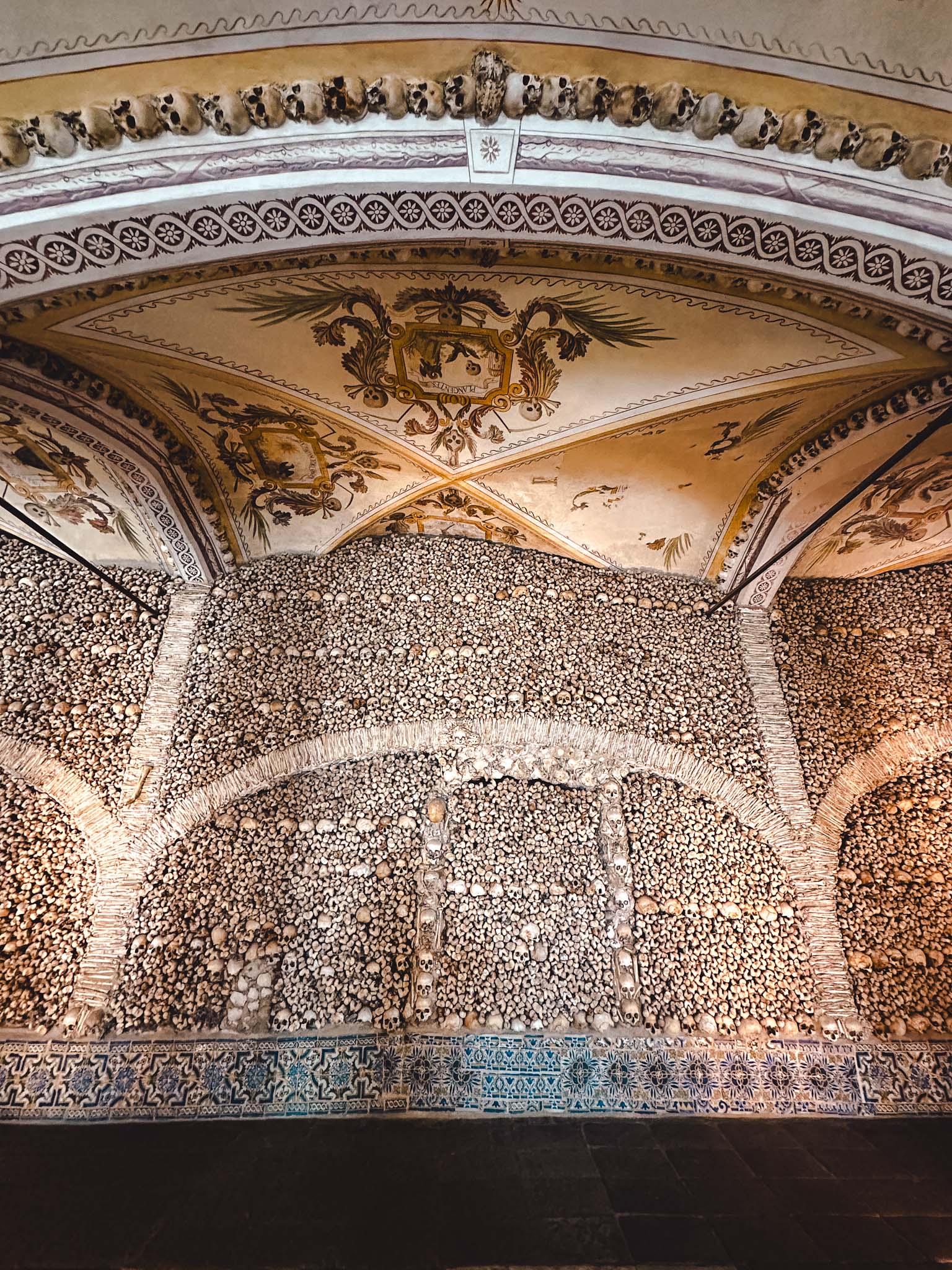
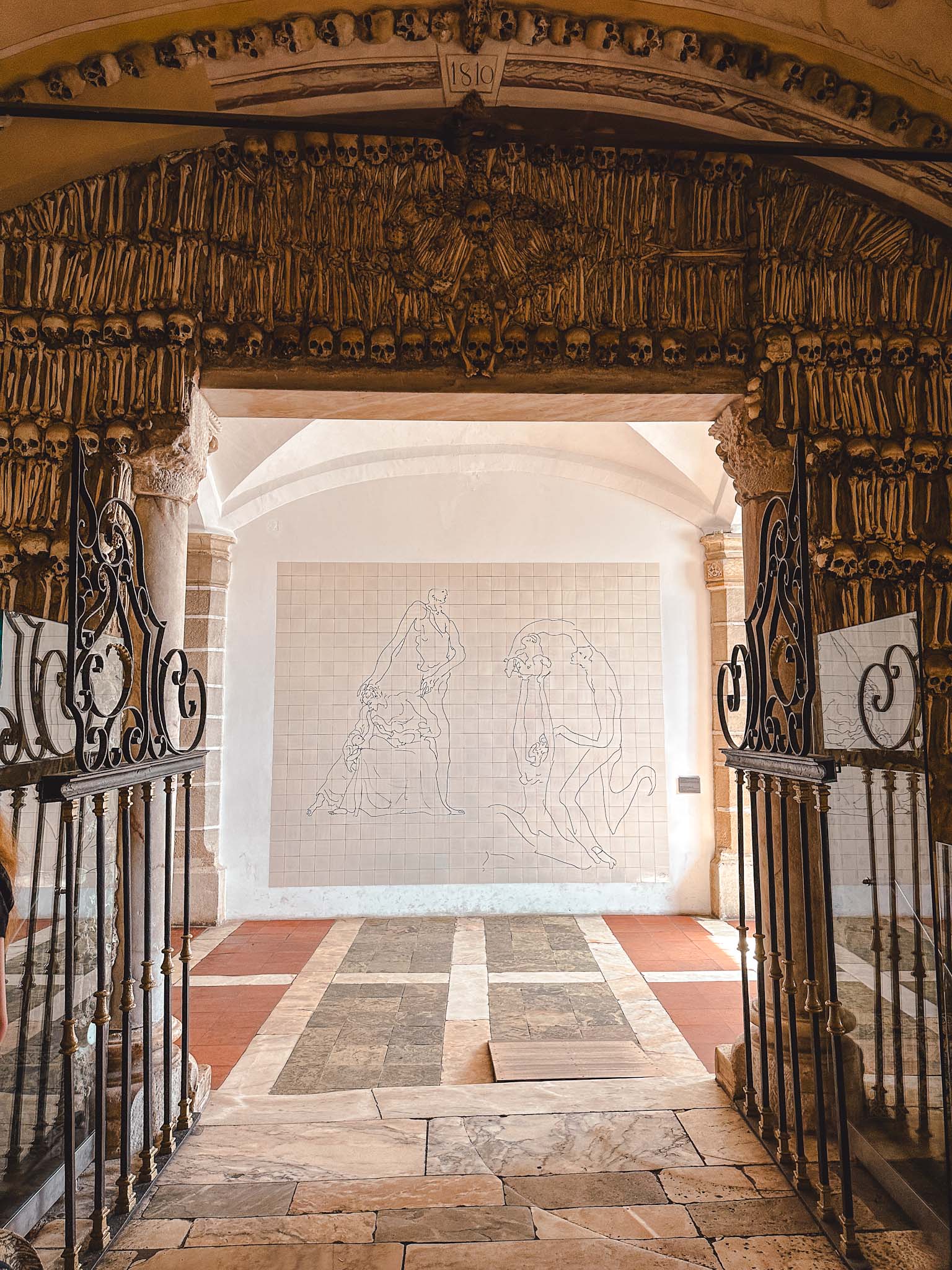
The chapel is a built-in room inside the premises of the monastery and church complex, like a single room lined with multiple pillars, Portuguese tiles, and frescoes that decorate the vaulted ceiling, as well as bones from about 5,000 skeletons.
It is a strange feeling for sure, however, I tried to look at it as part of our historic heritage.
This was something people did in those days, and it has to be looked at through their perspective, not mine, so then it was easier to take it all in!

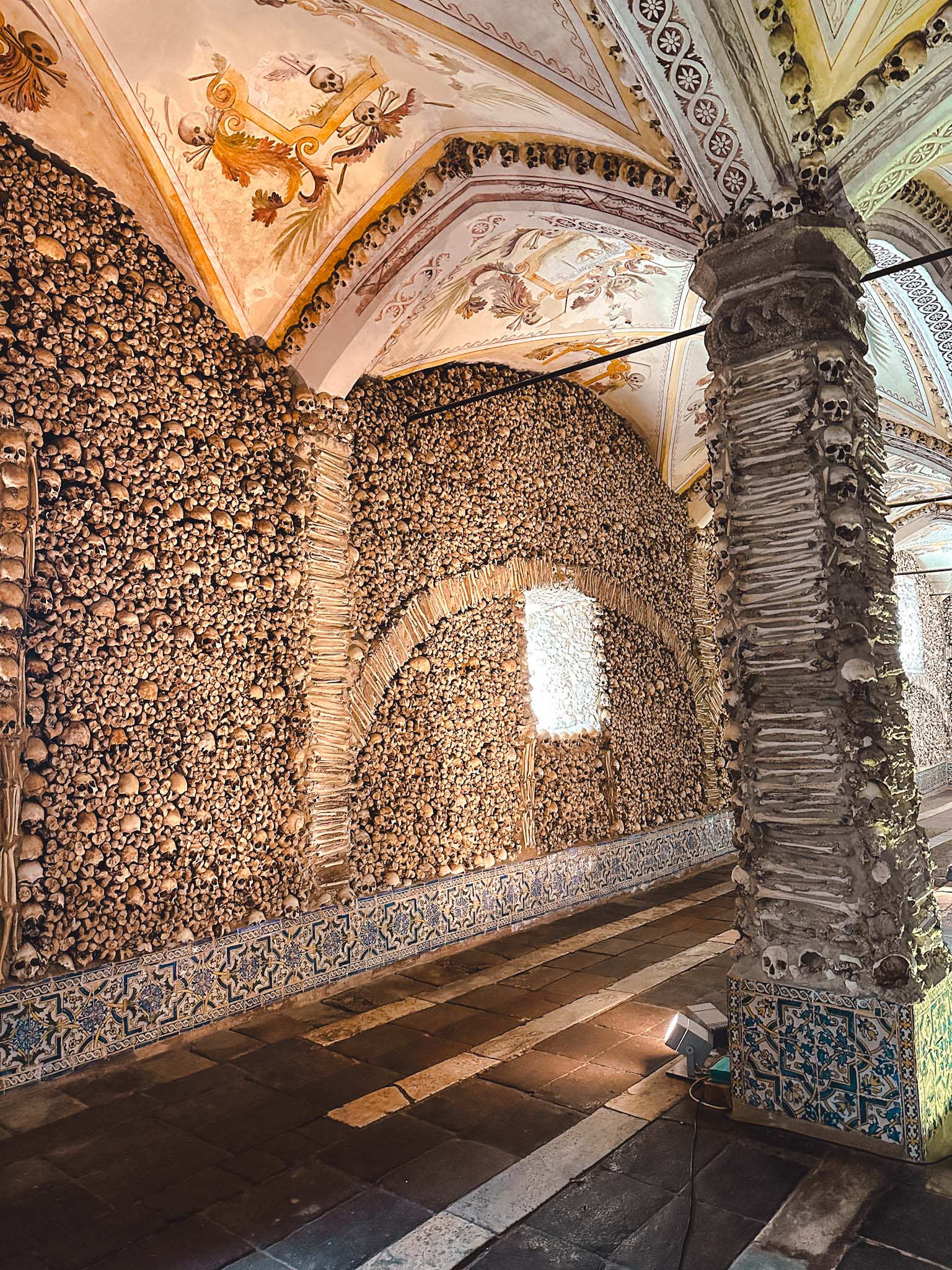
The Chapel of Bones was built in the 17th century and is the star of the museum.
If you are wondering where all the bones came from, then there isn’t a special story – Franciscan monks took them from the exhumated corpses from the medieval cemetery in Évora.
Another interesting part about the Chapel of Bones is the inscription above the entrance that says ‘Nós ossos que aqui estamos pelos vossos esperamos‘ and translates from Portuguese as ‘We, the bones that are here, for yours we wait’. Creepy or not?
Location: Chapel of Bones
20. Santos Passos Church
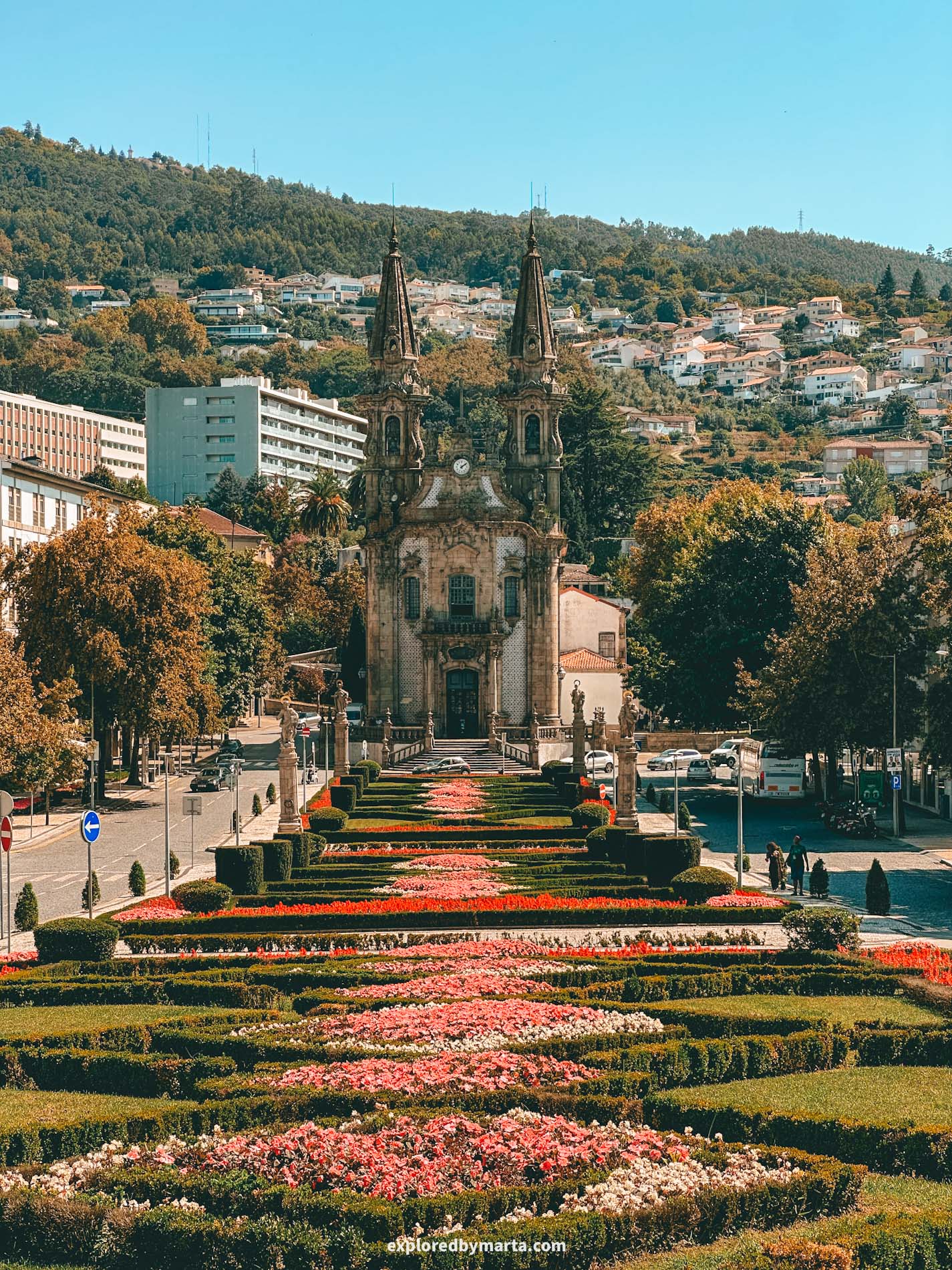
This is one of my favorites – the iconic Santos Pasos Church, or Igreja e Oratórios de Nossa Senhora da Consolação e Santos Passos, is a church with a garden like no other!
You’ll see this church as soon as you arrive at the lovely medieval town of Guimarães in Northern Portugal. It sits at the end of a long avenue filled with vibrant flowerbeds.
Seeing the garden with the church at the end is one thing, but I highly recommend walking all the way along the avenue and visiting the church!
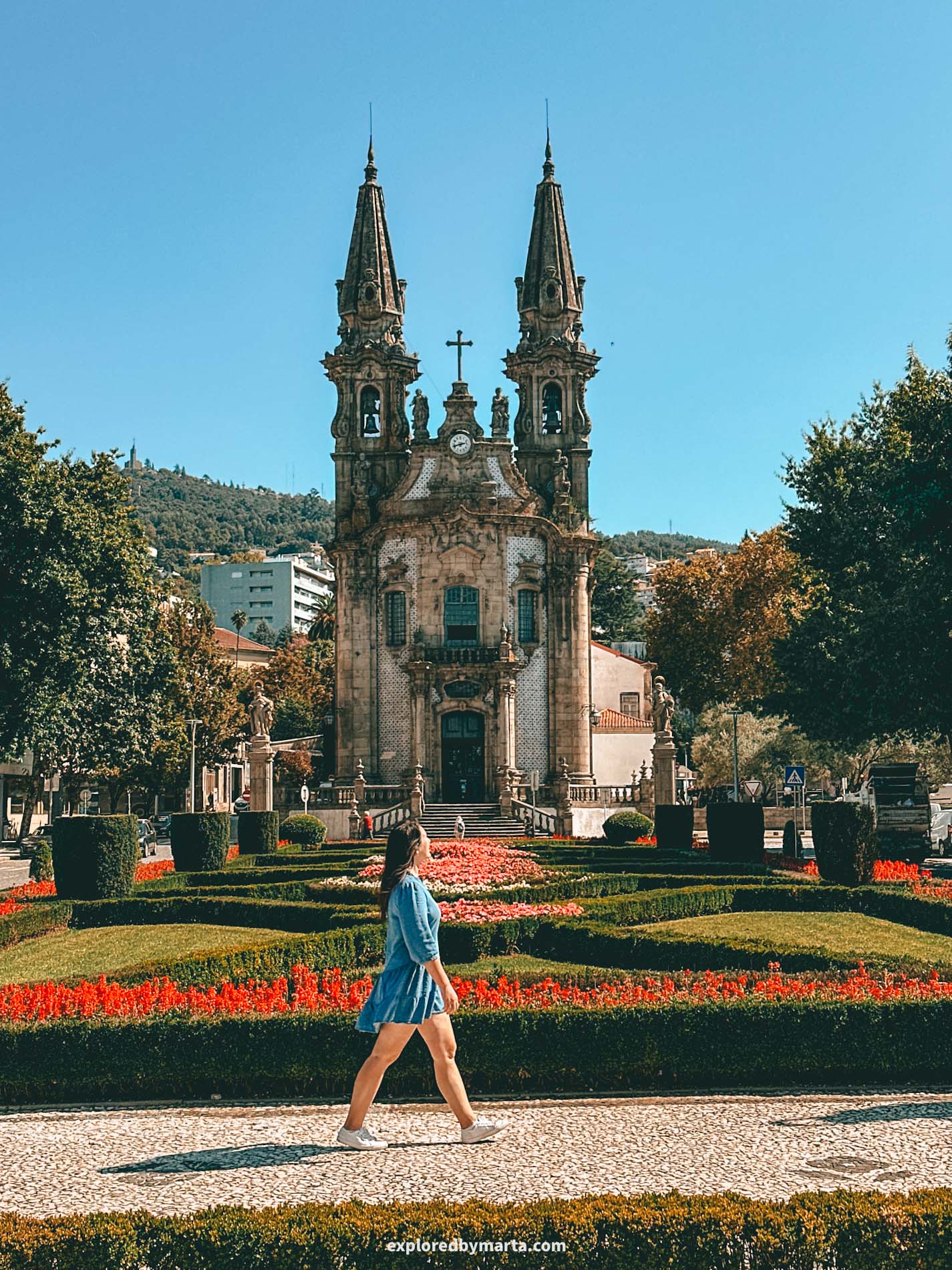

Entrance to the church is free, but there is a secret spot you need to know about.
Advertised as the best and most beautiful view in Guimarães, is an option to climb up to the upper floor of the church and see the view of the beautiful avenue from the church’s perspective.
When we visited, they asked for a 1 EUR donation to be able to climb to the upper floor, so we didn’t think twice and got up there. The view was very beautiful.


I love seeing places from above, so this was one of my favorite things we did in Guimarães!
Now, I don’t know which view I liked best – the one looking from the old town with the church at the end of the avenue, or the view from this church and the Guimarães old town in the background.
We spent a few minutes admiring the view and then continued on to explore the church. It is a beautiful 18th-century church proudly displaying the Baroque architectural style.

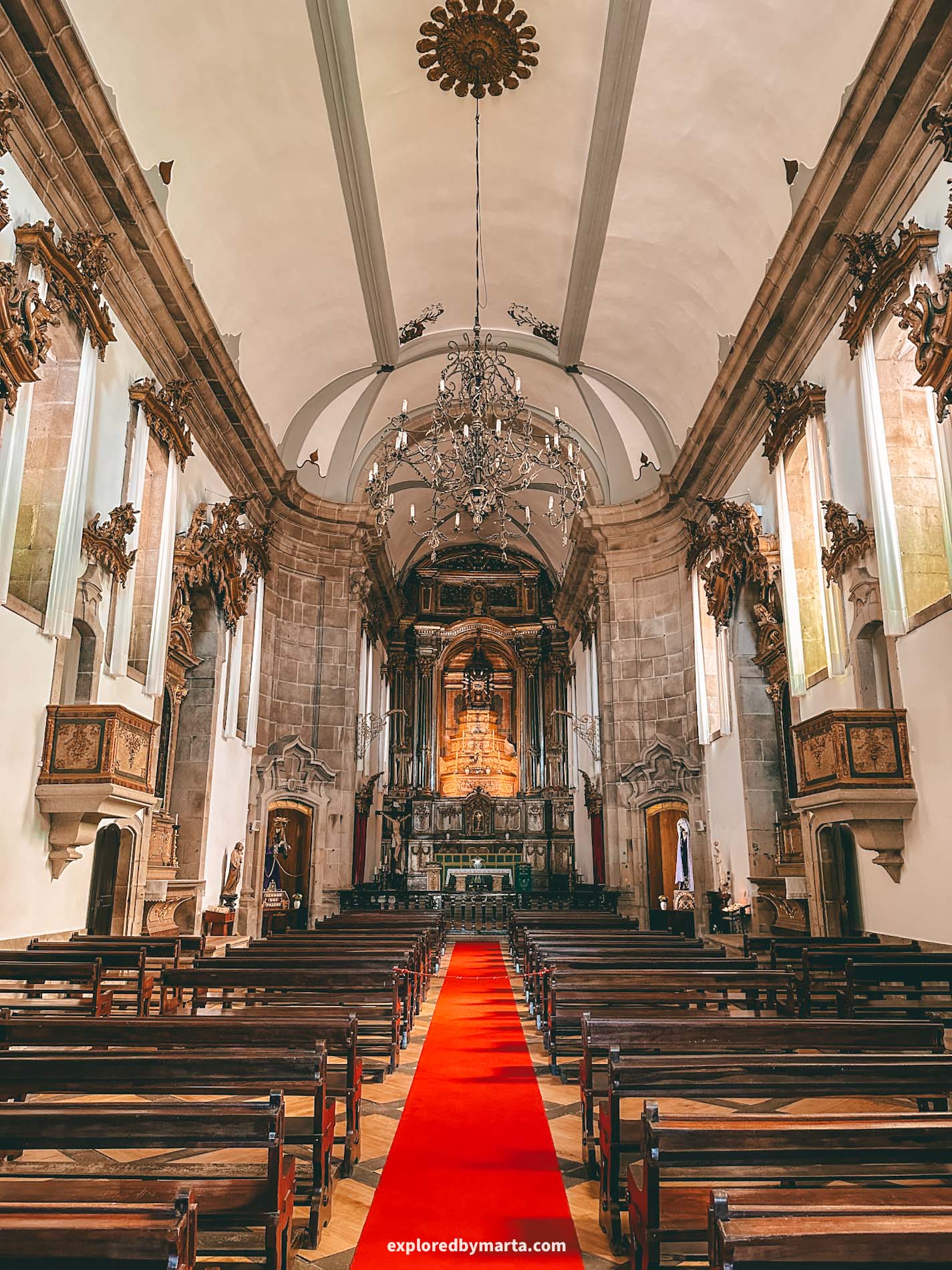
The kind host of the church made sure we got to see all of the church, including climbing up to the pulpits, the tiny balconies along the church’s walls. The church has a single nave and beautiful altars.
It isn’t the most spectacular church you’ll ever see from the inside, but the combination of the long avenue with flowerbeds and the church’s beautiful exterior makes it one of the most iconic churches in Portugal.
If you have time to spare, I definitely recommend visiting this place!
Location: Santos Passos Church
21. Santuário de São Bento da Porta Aberta
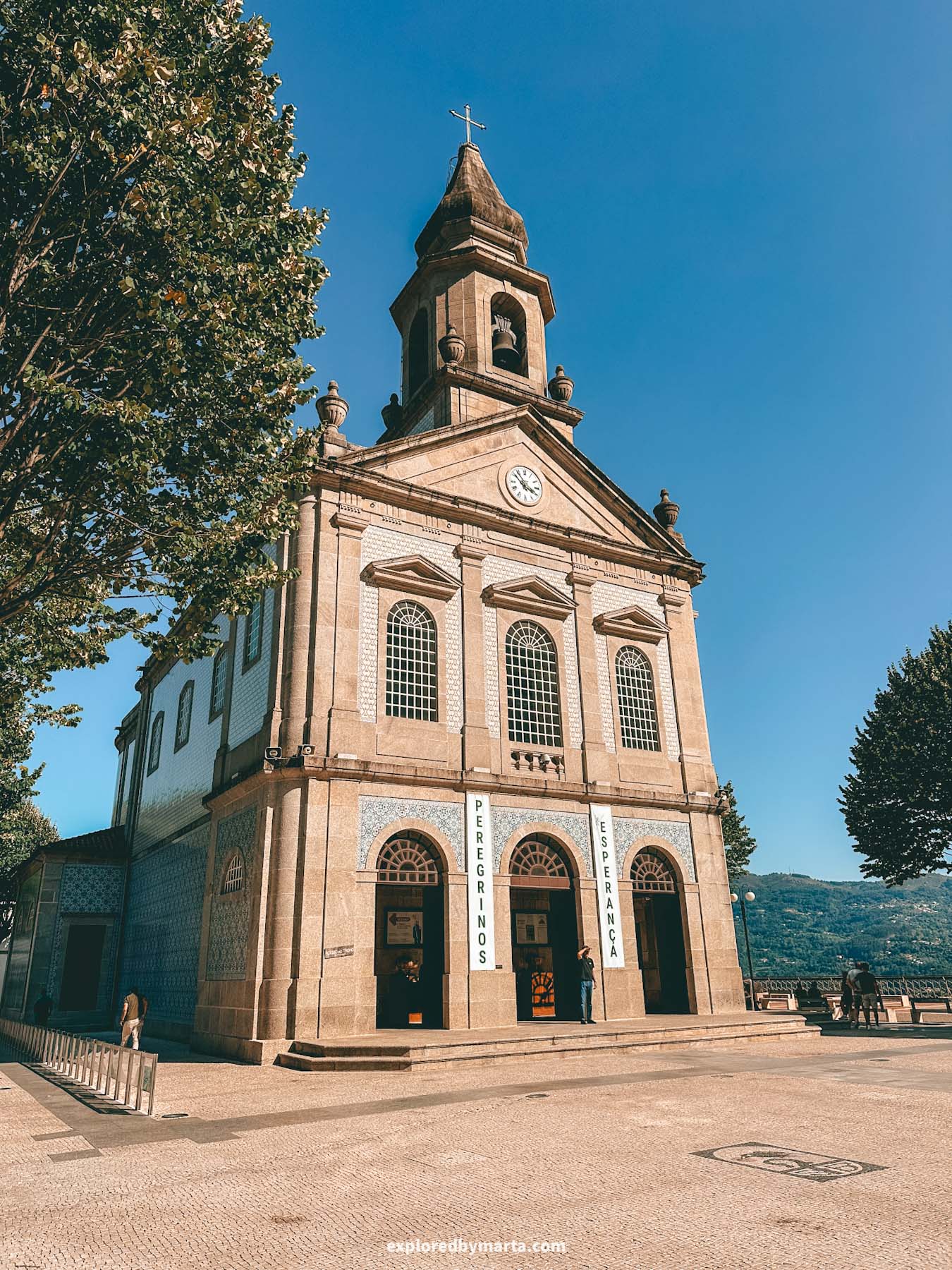
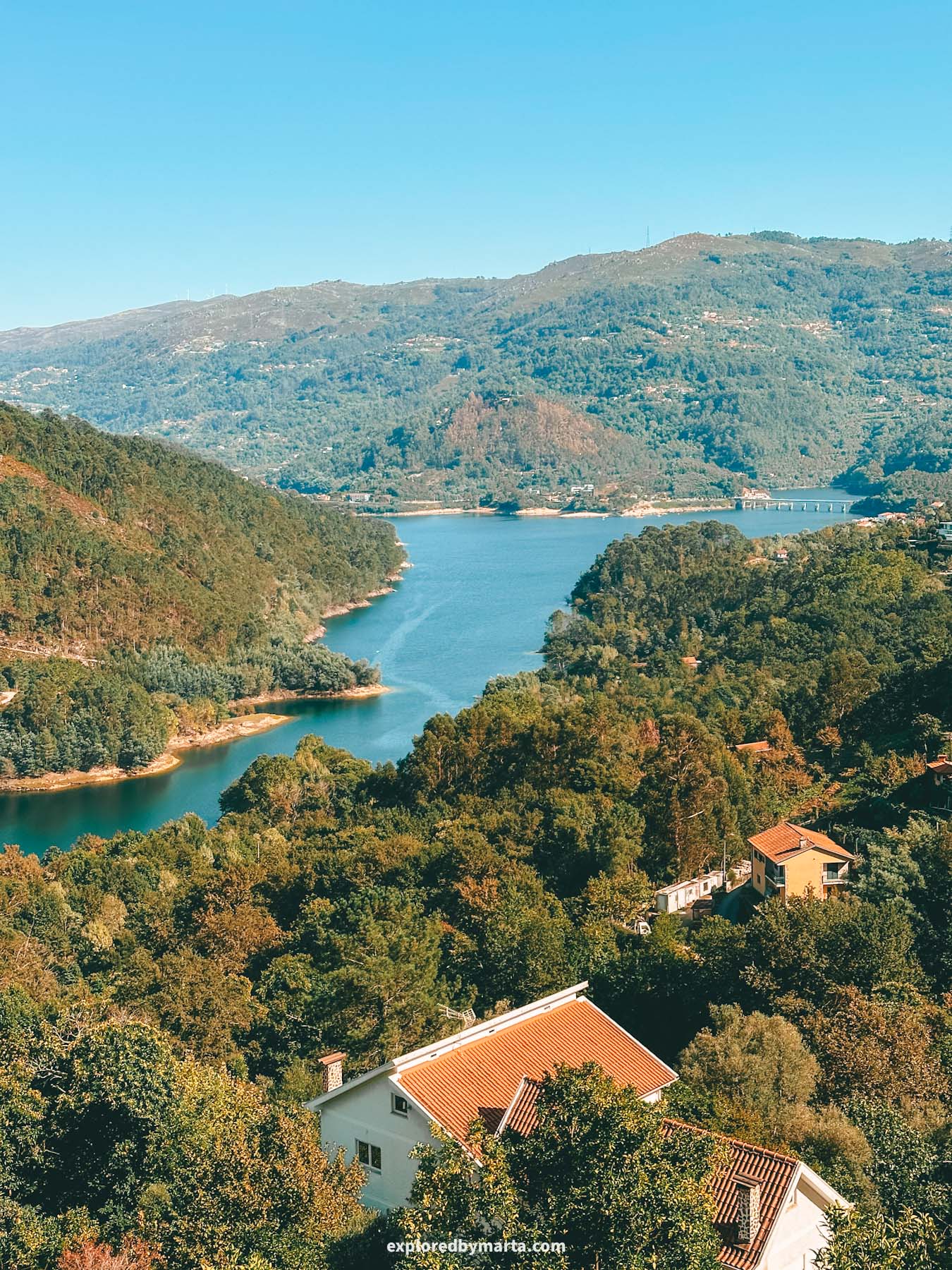
The Sanctuary of São Bento da Porta Aberta is one of the most important pilgrimage sites in northern Portugal, located in the stunning Gerês region, near the Peneda-Gerês National Park.
The scenic church is surrounded by green hills and the peaceful waters of the Cávado River. It is one of the most beautiful settings I’ve seen for a church! Look at those views!


The sanctuary dates back to the 17th century, when a small chapel was built here with its doors always open to travelers and pilgrims passing through the mountains – hence the name Porta Aberta, which means Open Door.
Over the centuries, it grew into a large religious complex. Inside the sanctuary, you’ll find intricate woodwork, religious paintings, and tiles that tell the story of Saint Benedict.

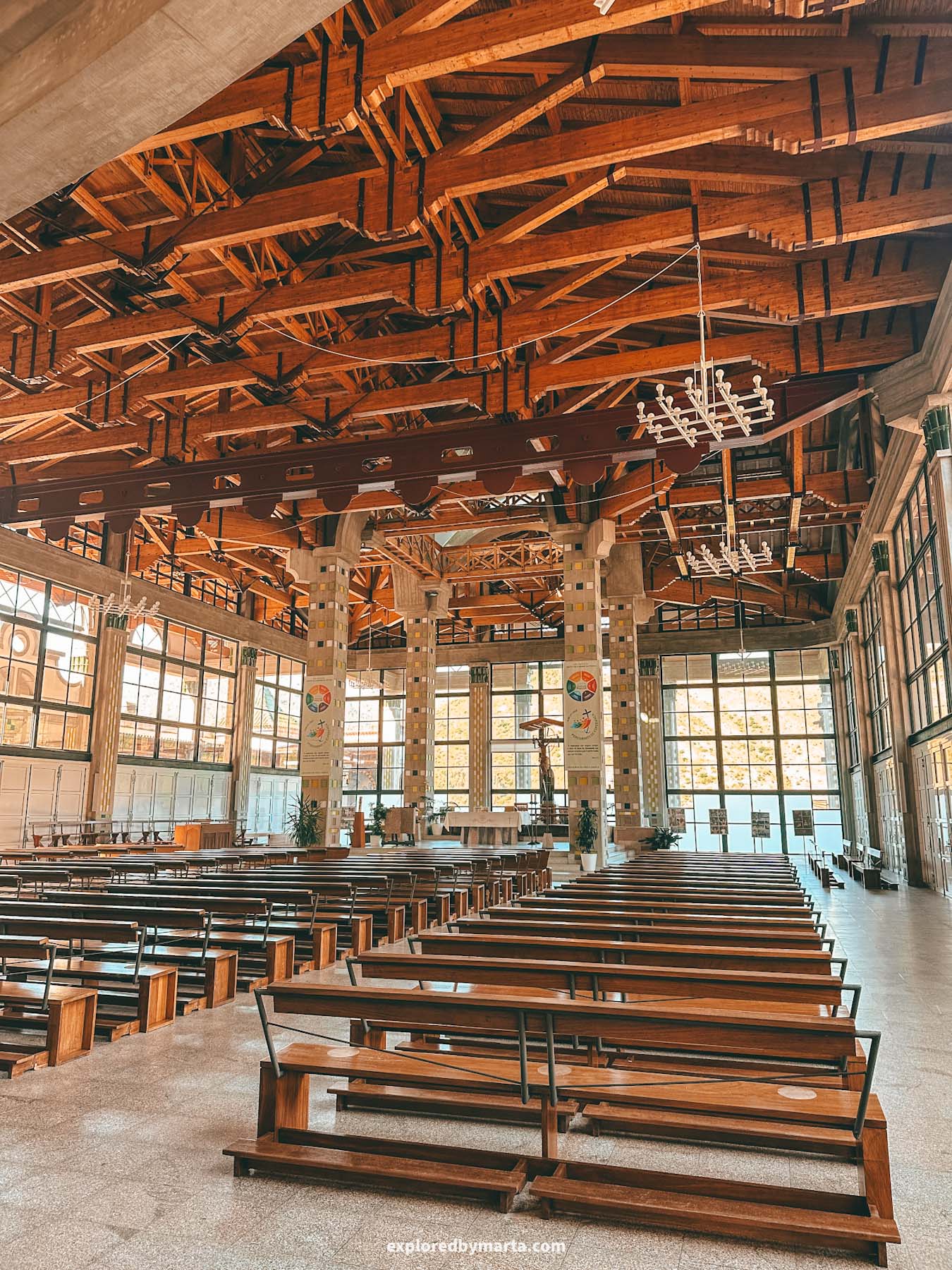
Every August, thousands of pilgrims gather here for the annual São Bento da Porta Aberta festivities, one of the largest religious celebrations in Portugal. They’ve even built a modern complex for large events right next to the church (see photos above).
We visited outside the pilgrimage season, but there were still buses full of people coming here from all sides. It’s a really popular pilgrimage site! Some say it comes second only to Fatima in terms of significance!
If you happen to be around, do stop by. It’s easy to see why São Bento da Porta Aberta has remained a popular destination for centuries. It’s just a special place!
Location: Santuário de São Bento da Porta Aberta
22. Santuario de Nossa Senhora da Peneda
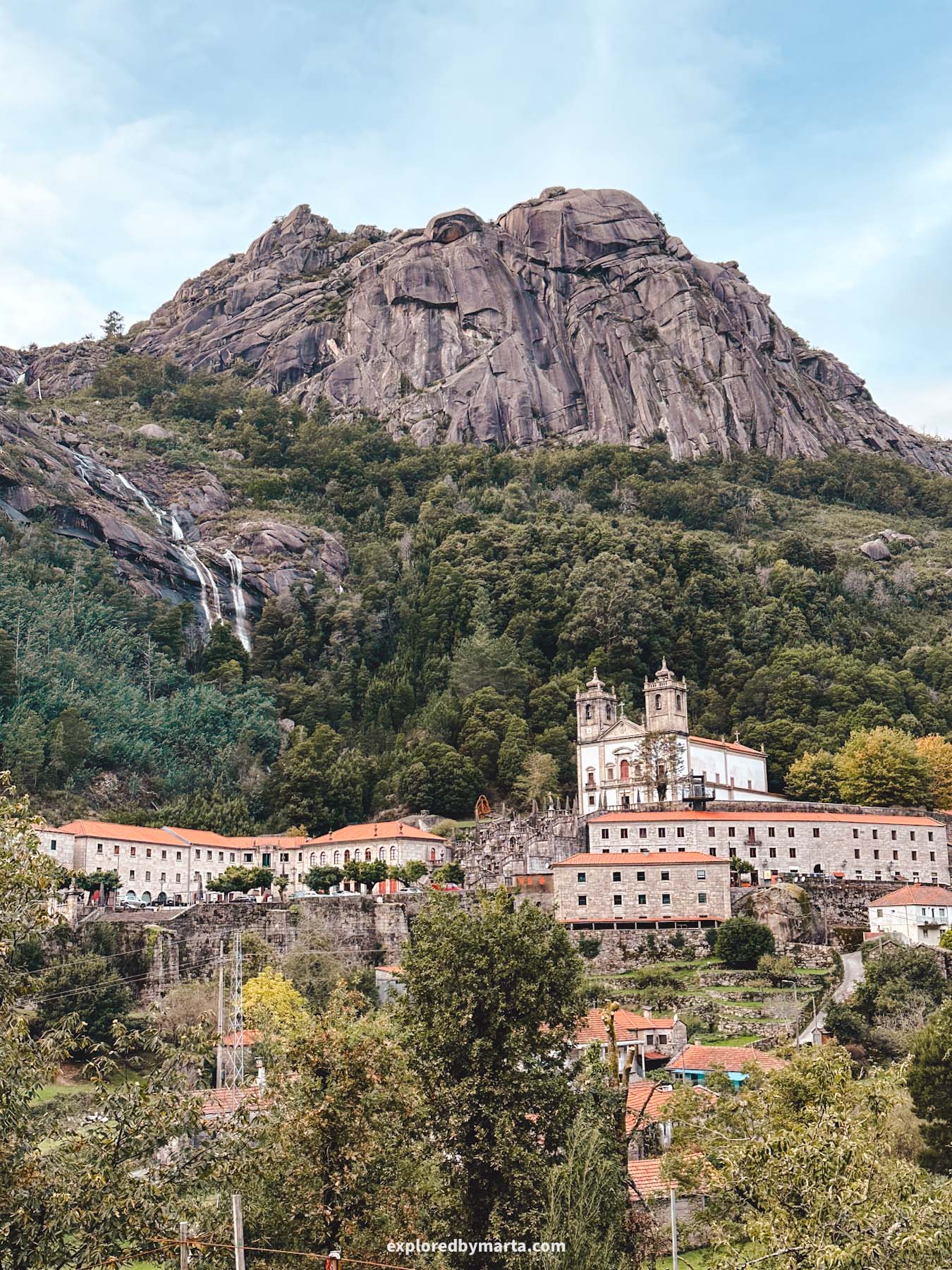
The Sanctuary of Nossa Senhora da Peneda is one of Portugal’s most scenic and peaceful religious sites, hidden away in the Peneda-Gerês National Park in the country’s far north.
The mountain sanctuary is surrounded by dramatic granite mountains, lush forests, and a waterwall right next to it, which creates the perfect retreat. This place was so quiet and serene!
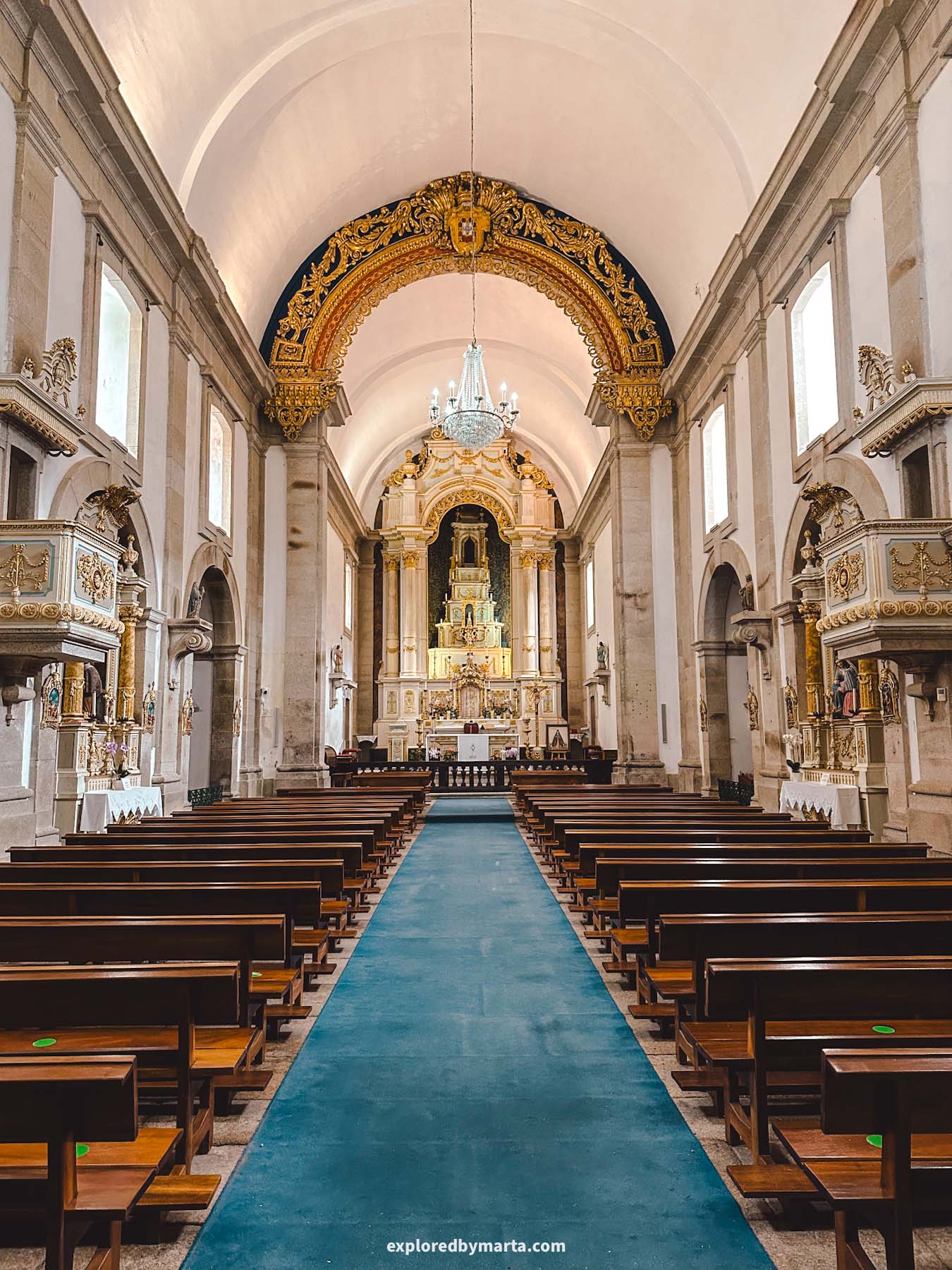
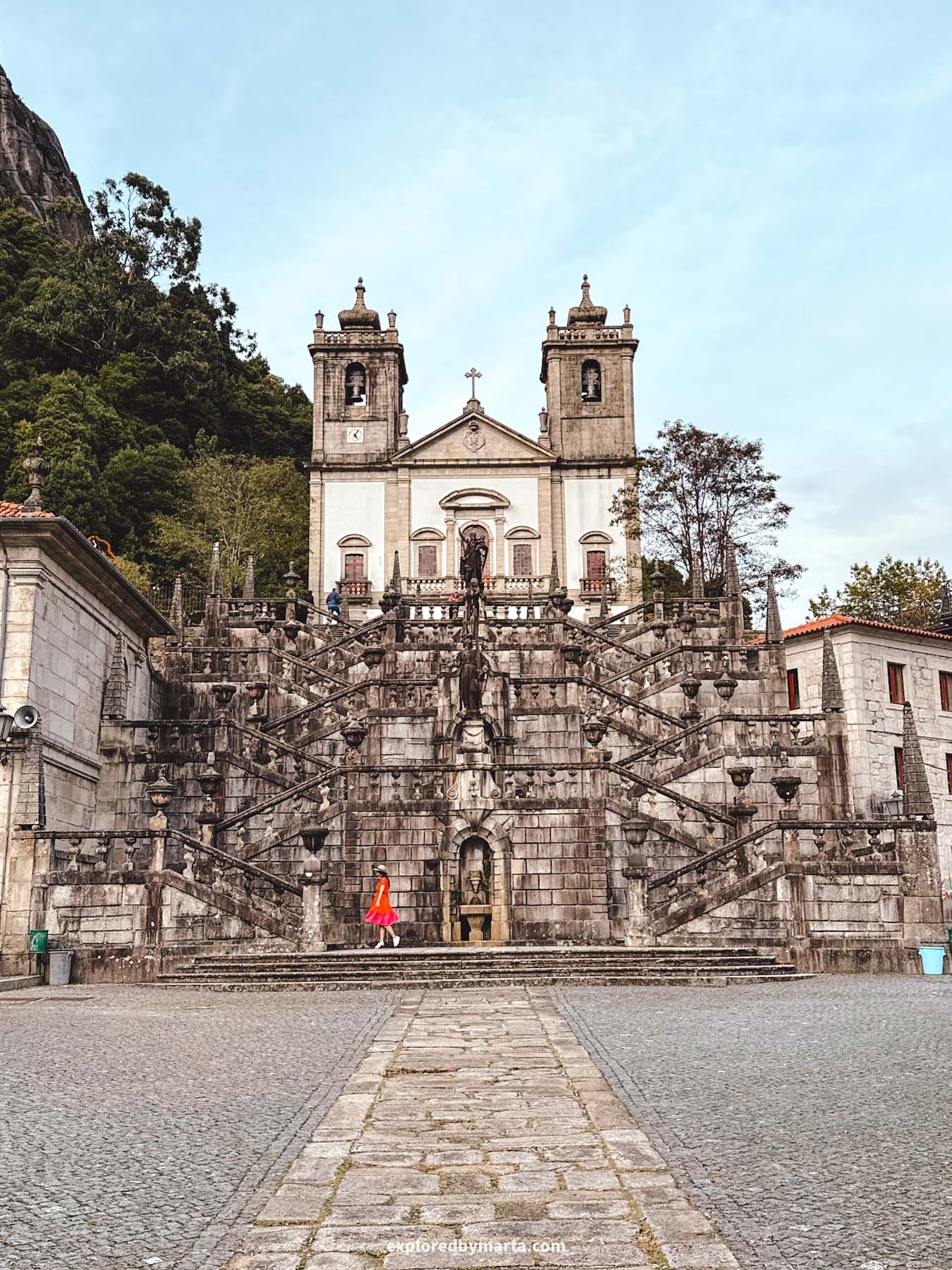
Built between the 18th and 19th centuries, the sanctuary is often compared to the famous Bom Jesus do Monte in Braga because of its impressive Baroque staircase. However, it is not nearly as grand as the one in Braga.
The staircase climbs up the hill and is beautifully decorated with statues. At the top of the hill, you will find the iconic mountain church. Entrance to the church is free, but it does have opening hours, so make sure to check that before you come.
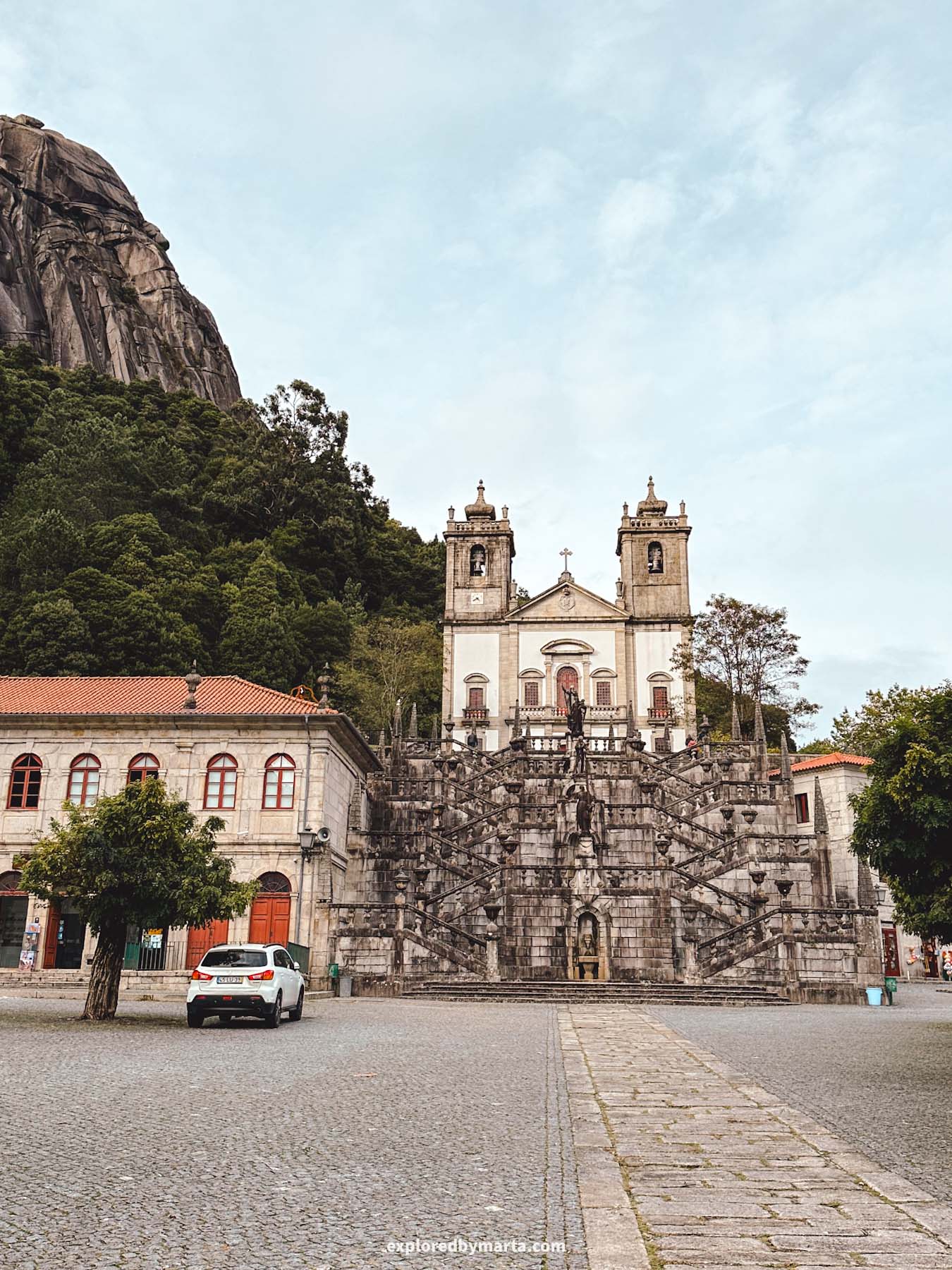
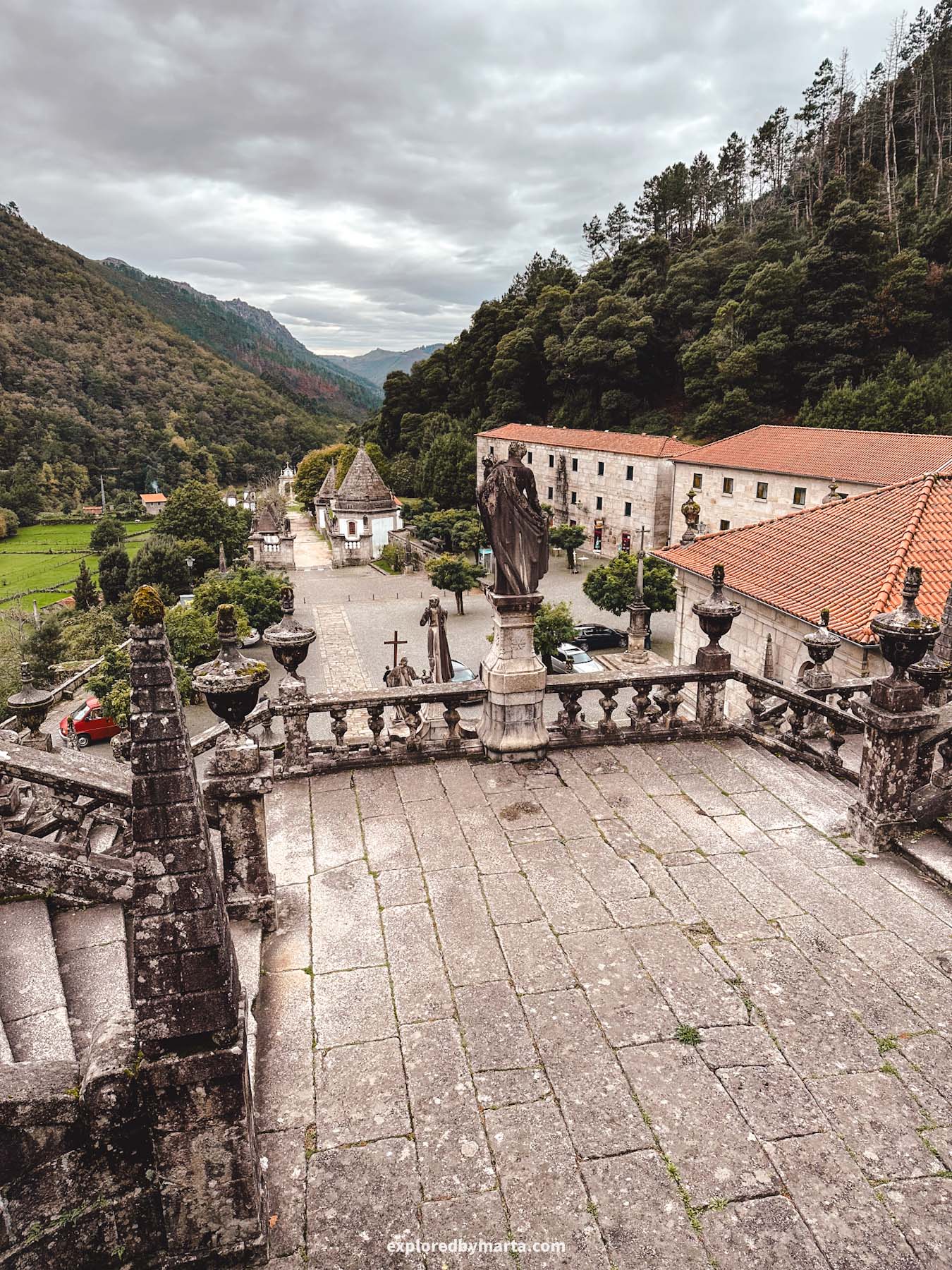
We drove here during our road trip through northern Portugal, and it became one of our favorite hidden gems. The views from the sanctuary are spectacular, and the surrounding landscapes are breathtaking.
Each September, the Sanctuary of Nossa Senhora da Peneda hosts an annual pilgrimage that attracts thousands of visitors. But I’d rather go there at a different time to enjoy the peaceful atmosphere.
Location: Santuario de Nossa Senhora da Peneda
Happy exploring!
Portugal’s deep spiritual history, stunning architecture, and timeless charm make it one of the most captivating countries to explore in Europe. From grand cathedrals and hilltop sanctuaries to hidden chapels, there is a story waiting to be told on every turn.
We’ve spent several months living in and exploring every region in Portugal, and visiting some of the country’s iconic churches was one of my favorite memories from our travels. It’s a small glimpse into the country’s soul!
There are some curches that have to be in every Portugal itinerary, no matter how long you are staying in the country, so I hope this blog post helps you plan your own unforgettable Portugal adventures in Portugal. Cheers!
PIN FOR LATER!
